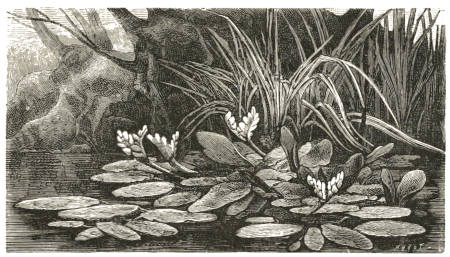TRANSCRIBER’S NOTES:
—Obvious print and punctuation errors were corrected.
—Where necessary, illustrations have been relocated. List of illustration has been therefore adapted.
—The transcriber of this project created the book cover image using the front cover of the original book. The image is placed in the public domain.
THE WILD GARDEN
The
WILD GARDEN
Or our Groves and Gardens made beautiful by the Naturalisation of Hardy Exotic Plants; being one way onwards from the Dark Ages of Flower Gardening, with suggestions for the Regeneration of the Bare Borders of the London Parks.
By W. ROBINSON, F. L. S.
THIRD EDITION
Illustrated by Alfred Parsons
LONDON
JOHN MURRAY, ALBEMARLE STREET
NEW YORK: SCRIBNER AND WELFORD
1883
By the same Author.
THE ENGLISH FLOWER GARDEN: ITS STYLE AND ARRANGEMENT. Followed by an ALPHABETICAL DESCRIPTION of all the PLANTS BEST SUITED FOR ITS EMBELLISHMENT, their CULTURE, and POSITION. With numerous Illustrations. Medium 8vo. 15s.
THE PARKS AND GARDENS OF PARIS, considered in Relation to the Wants of other Cities and of Public and Private Gardens. Third Edition. With 350 Illustrations. 8vo. 18s.
ALPINE FLOWERS FOR ENGLISH GARDENS. How they may be Grown in all Parts of the British Islands. With Illustrations of Rock–gardens, Natural and Artificial. Third Edition. With Woodcuts. Crown 8vo. 7s. 6d.
THE SUB–TROPICAL GARDEN; or, Beauty of Form in the Flower Garden; with Illustrations of all the finer Plants used for this purpose. Second Edition. With Illustrations. Small 8vo. 5s.
HARDY FLOWERS. Descriptions of upwards of 1300 of the most Ornamental Species; with Directions for their Culture, &c. Fourth Edition. Post 8vo. 3s. 6d.
GOD’S ACRE BEAUTIFUL; or, The Cemeteries of the Future. Third Edition. With Illustrations. 8vo. 7s. 6d.
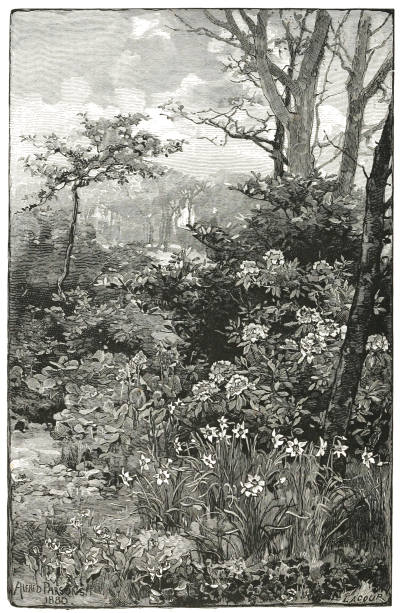
Illustration: Colonies of Poet’s Narcissus and Broad–leaved Saxifrage, etc.—Frontispiece.
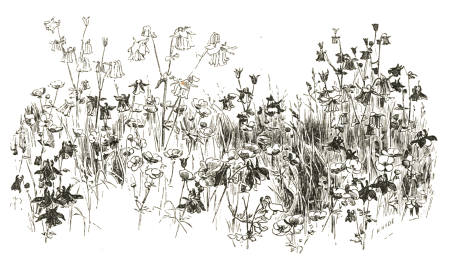
Columbines and Geraniums in meadow–grass.
PREFACE.
When I began, some years ago, to plead the cause of the innumerable hardy flowers against the few tender ones, put out at that time in a formal way, the answer frequently was, “We cannot go back to the mixed border”—that is to say, the old way of arranging flowers in borders. Knowing, then, a little of the vast world of plant beauty quite shut out of our gardens by the “system,” in vogue, I was led to consider the ways in which it might be introduced to our gardens; and, among various ideas that then occurred to me, was the name and scope of the “wild garden.” I was led to think of the enormous number of beautiful hardy plants from other countries which might be naturalised, with a very slight amount of trouble, in many situations in our gardens and[vi] woods—a world of delightful plant beauty that we might in this way make happy around us, in places now weedy, or half bare, or useless. I saw that we could not only grow thus a thousandfold more lovely flowers than are commonly seen in what is called the flower garden, but also a number which, by any other plan, have no chance whatever of being seen around us. This is a system which will give us more beauty than ever was dreamt of in gardens, without interfering with formal gardening in any way.
In this illustrated edition, by the aid of careful drawings, I have endeavoured to suggest in what the system consists; but if I were to write a book for every page that this contains, I could not hope to suggest the many beautiful aspects of vegetation which the wild garden will enable us to enjoy at our doors.
The illustrations are, with a few slight exceptions, the work of Mr. Alfred Parsons, and the drawing and engraving have been several years in execution. They are after nature, in places where the ideas expressed in the first small edition of the book had been carried out, or where accident, as in the case of the beautiful group of Myrrh and white Harebells, had given rise to the combinations or aspects of vegetation sought. I cannot too heartily acknowledge the skill and pains which Mr. Parsons devoted to the drawings, and to the success which he has attained in illustrating the motive of the book, and such good effects as have already been obtained where the idea has been intelligently carried out.
There has been some misunderstanding as to the term “Wild Garden.” It is applied essentially to the placing of perfectly hardy exotic plants in places and under conditions where they will become established and take care of themselves. It has nothing to do with the old idea of the “wilderness,” though it may be carried out in connection with that. It does not necessarily mean the picturesque garden, for a garden may be highly picturesque, and yet in every part the result of ceaseless care. What it does mean is best explained by the winter Aconite flowering under a grove of naked trees in February; by the Snowflake growing abundantly in meadows by the Thames side; by the perennial Lupine dyeing an islet with its purple in a Scotch river; and by the Apennine Anemone staining an English wood blue before the blooming of our blue bells. Multiply these instances a thousandfold, illustrated by many different types of plants and hardy climbers, from countries as cold or colder than our own, and one may get a just idea of the wild garden. Some have erroneously represented it as allowing a garden to run wild, or sowing annuals promiscuously; whereas it studiously avoids meddling with the garden proper at all, except in attempting the improvements of bare shrubbery borders in the London parks and elsewhere; but these are waste spaces, not gardens.
I wish it to be kept distinct in the mind from the various important phases of hardy plant growth in groups, beds, and borders, in which good culture and good taste may produce[viii] many happy effects; distinct from the rock garden or the borders reserved for choice hardy flowers of all kinds; from the best phase of the sub–tropical garden—that of growing hardy plants of fine form; from the ordinary type of spring garden; and from the gardens, so to say, of our own beautiful native flowers in our woods and wilds. How far the wild garden may be carried out as an aid to, or in connection with, any of the above in the smaller class of gardens, can be best decided on the spot in each case. In the larger gardens, where, on the outer fringes of the lawn, in grove, park, copse, or by woodland walks or drives, there is often ample room, fair gardens and wholly new and beautiful aspects of vegetation may be created by its means.
May 28, 1881.
CONTENTS.
| CHAPTER I. | |
| PAGE | |
| Explanatory | 1 |
| CHAPTER II. | |
| Example from the Forget–me–not Family | 9 |
| CHAPTER III. | |
| Example from Hardy Bulbs and Tubers in Grass | 15 |
| CHAPTER IV. | |
| Example from the Globe Flower Order | 21 |
| CHAPTER V. | |
| Plants chiefly fitted for the Wild Garden | 32 |
| CHAPTER VI. | |
| Ditches and narrow shady Lanes, Copses, Hedgerows, and Thickets | 36 |
| CHAPTER VII. | |
| Drapery for Trees and Bushes | 43 |
| CHAPTER VIII.[x] | |
| The common Shrubbery, Woods and Woodland Drives | 51 |
| CHAPTER IX. | |
| The Brook–side, Water–side, and Bog Gardens | 67 |
| CHAPTER X. | |
| Roses for the Wild Garden, and for Hedgerows, Fences, and Groups | 81 |
| CHAPTER XI. | |
| Wild Gardening on Walls or Ruins | 88 |
| CHAPTER XII. | |
| Some Results | 92 |
| CHAPTER XIII. | |
| A Plan for the Embellishment of the Shrubbery Borders in London Parks | 111 |
| CHAPTER XIV. | |
| The Principal Types of Hardy Exotic Flowering Plants for the Wild Garden | 120 |
| CHAPTER XV. | |
| Selections of Hardy Exotic Plants for various Positions in the Wild Garden |
163 |
LIST OF ILLUSTRATIONS.
| PAGE | |
| Colonies of Poet’s Narcissus and Broad–leaved Saxifrage, etc. | |
| Frontispiece | |
| Columbine and Geraniums in meadow–grass | v |
| Large flowered Meadow Rue in the Wild Garden, type of plant mostly excluded from the Garden | 1 |
| Night effect of large evening Primrose in the Wild Garden (Œnothera Lamarkiana) |
|
| To face page 4 | |
| A “mixed border” with tile edging, the way in which the beautiful hardy flowers of the world have been grown in gardens hitherto, when grown at all. (Sketched in a large garden, 1878) | 5 |
| Blue flowered Composite plant; fine foliage and habit; type of noble plants excluded from Gardens. (Mulgedium Plumieri) | 6 |
| Wood Anemone | 8 |
| Caucasian Comfrey in shrubbery | 9 |
| The Cretan Borage (Borago cretica) | 12 |
| Flowers of Geneva Bugle (Ajuga genevensis), Dwarf Boragewort | 14 |
| Star of Bethlehem in Grass | 15 |
| The association of exotic and British wild flowers in the Wild Garden.—The Bell–flowered Scilla, naturalised with our own Wood Hyacinth | 16 |
| The Turk’s Cap Lily, naturalised in the grass by wood–walk | 19 |
| Crocuses in turf, in grove of Summer leafing trees | 20 |
| Group of Globe flowers (Trollius) in marshy place; type of the nobler Northern flowers little cultivated in gardens | 21 |
| [xii]The Mountain Clematis (C. montana) | 22 |
| The White Japan Anemone in the Wild Garden | 23 |
| Anemones in the Riviera. Thrive equally well in any open soil here, only flowering later | |
| To face page 24 | |
| The Green Hellebore in the Wild Garden | 26 |
| Tall perennial Larkspurs, naturalised in Shrubbery (1878) | 28 |
| Double Crimson Pæonies in grass | 30 |
| Eupatorium purpureum | 32 |
| The Giant Scabious (8 feet high). (Cephalaria procera) | 32 |
| Giant Cow parsnip. Type of Great Siberian herbaceous vegetation. For rough places only | 35 |
| Foliage of Dipsacus, on hedge–bank in spring | 36 |
| The large white Bindweed, type of nobler climbing plants, with annual stems. For copses, hedgerows, and shrubberies | 39 |
| The Nootka Bramble; type of free–growing flowering shrub. For copses and woods | 40 |
| The Yellow Allium (A. Moly) naturalised | 42 |
| Periploca græca (climber) | 43 |
| Large White Clematis on Yew tree at Great Tew. (C. montana grandiflora) | 45 |
| The way the climbing plants of the world are crucified in gardens—winter effect (a faithful sketch) |
45 |
| Climbing shrub (Celastrus), isolated on the grass; way of growing woody Climbers away from walls or other supports | 47 |
| A Liane in the North. Aristolochia and Deciduous Cypress | 48 |
| A beautiful accident.—A colony of Myrrhis odorata, established in shrubbery, with white Harebells here and there | 51 |
| Large White Achilleas spread into wide masses under shade of trees in shrubbery | 53 |
| Lilies coming up through carpet of White Arabis | 56 |
| Colony of Narcissus in properly spaced shrubbery | 57 |
| The American White Wood–Lily (Trillium grandiflorum) in Wild Garden, in wood bottom in leaf–mould |
|
| To face page 58 | |
| The Lily of the Valley in a copse | 63 |
| Solomon’s Seal and Herb Paris, in copse by streamlet | 67 |
| [xiii]Colony of hardy exotic Flowers, naturalised by brook–side | 70 |
| Valley in Somersetshire, with Narcissi, Marsh Marigolds, and Primroses | |
| To face page 70 | |
| Cyperus longus | 73 |
| The Cape Pond Weed in an English ditch in winter | 75 |
| Day Lily by margin of water | 76 |
| Marsh Marigold and Iris in early spring | 78 |
| The same spot as in previous sketch, with aftergrowth of Iris, Meadow Sweet, and Bindweed | 79 |
| Partridge Berry (Gaultheria) | 80 |
| Wild Rose growing on a Pollard Ash in Orchardleigh Park, Somerset | 83 |
| White Climbing Rose scrambling over old Catalpa Tree | |
| To face page 84 | |
| Climbing Rose isolated on grass | 87 |
| Arenaria balearica, in a hole in wall at Great Tew | 88 |
| Cheddar Pink, Saxifrage, and Ferns, on cottage wall at Mells | 89 |
| The Yellow Fumitory on wall (Corydalis lutea) | 91 |
| Large Japan Sedum (S. spectabile) and Autumn Crocuses in the Wild Garden | 92 |
| Crane’s Bill, wild, in grass | 94 |
| Large–leafed Saxifrage in the Wild Garden | 95 |
| Tiger Lilies in Wild Garden at Great Tew | |
| To face page 98 | |
| Large–flowered Clematis | 102 |
| Sun Roses (Cistus) and other exotic hardy plants among heather, on sandy slope | |
| To face page 104 | |
| Wood and herbaceous Meadow–sweets grouped together in Mr. Hewittson’s garden | 105 |
| Woodruff and Ivy | 108 |
| Tailpiece | 110 |
| Dug and mutilated Shrubbery in St. James’s Park. Sketched in winter of 1879 | 111 |
| Colony of the Snowdrop–Anemone in Shrubbery not dug. Anemone taking the place of weeds or bare earth | 115 |
| Colony of the Summer Snowflake, on margin of shrubbery | 119 |
| [xiv]The Monkshood, naturalised by wet ditch in wood | 121 |
| The white Narcissus–like Allium, in the orchards of Provence; type of family receiving little place in gardens which may be beautiful for a season in wild places | 123 |
| The Alpine Windflower (Anemone alpina) | 124 |
| Siberian Columbine in rocky place | 126 |
| Tall Asphodel in copse | 127 |
| The foliage of the Meadow Saffron in Spring | 132 |
| The White–flowered European Clematis (C. erecta) | 133 |
| Cyclamens in the Wild Garden; from nature | 134 |
| A South European Bindweed creeping up the stems of an Iris in an English garden | 135 |
| A Sea Holly; Eryngium | 138 |
| Groups of Funkia Sieboldi | 140 |
| A hardy Geranium | 141 |
| Snowdrops, wild, by streamlet in valley | 142 |
| Sun Rose on limestone rocks | 144 |
| White Lily in Wild Garden | 146 |
| Everlasting Pea, creeping up stem in shrubbery | 148 |
| Type of fine–leaved umbellate plants seldom grown in gardens | 149 |
| The Bee Balm, Monarda. American wood plant | 150 |
| The Great Japan Knotweed (Polygonum cuspidatum). (Showing the plant in flower) | 152 |
| Phlomis. Type of handsome Labiates; admirably suited for the Wild Garden |
153 |
| The tall Ox–eye daisy (Pyrethrum serotinum) | 154 |
| The Great Reed of Southern Europe (Arundo Donax) | 155 |
| Telekia. Type of the Larger Composites, excluded from gardens proper | 159 |
| Group of Tritoma, in grass | 160 |
| A tall Mullein | 161 |
| Ophrys in grass | 163 |
| Rock steps with Omphalodes | 175 |
| Butterbur and Double Furze on margin of lake | 176 |
THE WILD GARDEN.
ONE WAY ONWARDS FROM THE DARK AGES OF FLOWER–GARDENING.
CHAPTER I.
EXPLANATORY.
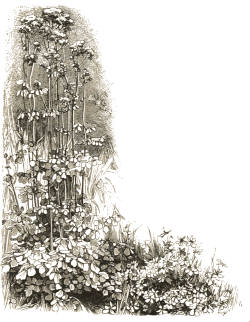
Large–flowered Meadow Rue in the Wild Garden, type of plant mostly excluded from the Garden.
About a generation ago a taste began to be manifested for placing a number of tender plants in the open air in summer, with a view to the production of showy masses of decided colour. The subjects selected were mostly from sub–tropical climates and of free growth; placed annually in the open air of our genial early summer, and in fresh rich earth, every year they grew rapidly and flowered abundantly during the summer and early autumn months, and until cut down by the first frosts. The showy colour of this system was very attractive, and since its introduction[2] there has been a gradual rooting out of all the old favourites in favour of this “bedding” system. This was carried to such an extent that it was not uncommon, indeed it has been the rule, to find the largest gardens in the country without a single hardy flower, all energy and expense being devoted to the production of the few exotics required for the summer decoration. It should be distinctly borne in mind that the expense for this system is an annual one; that no matter what amount of money may be spent in this way, or how many years may be devoted to perfecting it, the first sharp frost of November announces a yet further expense and labour, usually more heavy than the preceding.
Its highest results need hardly be described; they are seen in all our great public gardens; our London and many other city parks show them in the shape of beds filled with vast quantities of flowers, covering the ground frequently in a showy way, or in a repulsively gaudy manner: nearly every private garden is taken possession of by the same things. I will not here enter into the question of the merits of this system; it is enough to state that even on its votaries it is beginning to pall. Some are looking back with regret to the old mixed–border gardens; others are endeavouring to soften the harshness of the bedding system by the introduction of fine–leaved plants, but all are agreed that a great mistake has been made in destroying all our old flowers, from Lilies to Hepaticas, though very few persons indeed have any idea of the numbers of beautiful subjects in this way which we may gather from every northern and temperate clime to adorn our gardens under a more artistic system.
My object in the Wild Garden is now to show how we[3] may have more of the varied beauty of hardy flowers than the most ardent admirer of the old style of garden ever dreams of, by naturalising innumerable beautiful natives of many regions of the earth in our woods and copses, rougher parts of pleasure grounds, and in unoccupied places in almost every kind of garden.
I allude not to the wood and brake flora of any one country, but to that which finds its home in the vast fields of the whole northern world, and that of the hill–ground that falls in furrowed folds from beneath the hoary heads of all the great mountain chains of the world, whether they rise from hot Indian plains or green European pastures. The Palm and sacred Fig, as well as the Wheat and the Vine, are separated from the stemless plants that cushion under the snow for half the year, by a zone of hardier and not less beautiful life, varied as the breezes that whisper on the mountain sides, and as the rills that seam them. They are the Lilies, and Bluebells, and Foxgloves, and Irises, and Windflowers, and Columbines, and Rock–roses, and Violets, and Cranesbills, and countless Pea–flowers, and mountain Avens, and Brambles, and Cinquefoils, and Evening Primroses, and Clematis, and Honeysuckles, and Michaelmas Daisies, and Wood–hyacinths, and Daffodils, and Bindweeds, and Forget–me–nots, and blue–eyed Omphalodes, and Primroses, and Day Lilies, and Asphodels, and St. Bruno’s Lilies, and the almost innumerable plants which form the flora of the northern and temperate portions of vast continents.
It is beyond the power of pen or pencil to picture the beauty of these plants. Innumerable and infinitely varied scenes occur in the wilder parts of all northern and temperate[4] regions, at many different elevations. The loveliness and ceaselessly varying charms of such scenes are indeed difficult to describe or imagine; the essential thing to bear in mind is that the plants that go to form them are hardy, and will thrive in our climate as well as native plants.
Such beauty may be realised in every wood and copse and shrubbery that screens our “trim gardens.” Naturally our woods and wilds have no little loveliness in spring; we have here and there the Lily–of–the–valley and the Snowdrop, and everywhere the Primrose and Cowslip; the Bluebell and the Foxglove sometimes take nearly complete possession of whole woods; but, with all our treasures in this way, we have no attractions in or near our gardens compared to what it is within our power to create. There are many countries with winters as cold as, or colder than, our own, possessing a rich flora; and by taking the best hardy exotics and establishing them in wild or half–wild spots, we may produce beautiful pictures in such places. To most people a pretty plant in a free state is more attractive than any garden denizen. It is taking care of itself; and, moreover, it is usually surrounded by some degree of graceful wild spray—the green above, and the moss and brambles and grass around.
By the means presently to be explained, numbers of plants of the highest order of beauty and fragrance, and clothed with pleasant associations, may be seen perfectly at home in the spaces now devoted to rank grass and weeds, and by wood walks in our shrubberies and ornamental plantations.
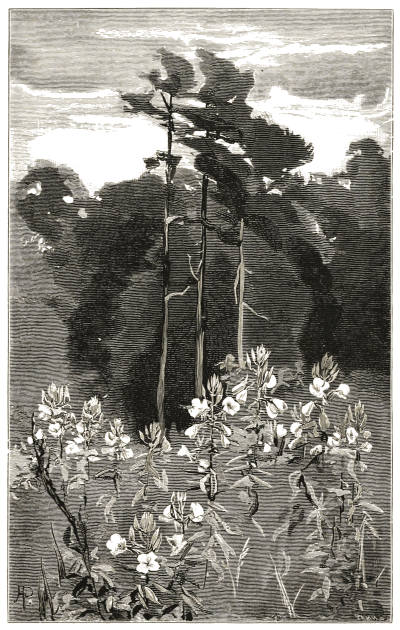
Night effect of large evening Primrose in the Wild Garden (Œnothera Lamarkiana)
Among my reasons for advocating this system are the following:—
First, because hundreds of the finest hardy flowers will thrive much better in rough and wild places than ever they did in the old–fashioned border. Even comparatively small ones, like the ivy–leaved Cyclamen, a beautiful plant that we rarely find in perfection in gardens, I have seen perfectly naturalised and spread all over the mossy surface of a thin wood.ill5

A “mixed border” with tile edging, the way in which the beautiful hardy flowers of the world have been grown in gardens hitherto, when grown at all. (Sketched in a large garden, 1878.)
Secondly, because they will look infinitely better than ever they did in gardens, in consequence of fine–leaved plant, fern, and flower, and climber, grass and trailing shrub, relieving each other in ways innumerable and delightful. Any one of a thousand combinations will prove as far superior to any aspect of the old mixed border, or the ordinary type of modern flower–garden, as is a lovely mountain valley to a piece of the “black country.”
Thirdly, because, arranged as I propose, no disagreeable effects result from decay. The raggedness of the old mixed border after the first flush of spring and early summer bloom had passed was intolerable, bundles of decayed stems tied to sticks, making the place look like the parade–ground of a number of crossing–sweepers. When Lilies are sparsely[6] dotted through masses of shrubs, their flowers are admired more than if they were in isolated showy masses; when they pass out of bloom they are unnoticed amidst the vegetation, and not eyesores, as when in rigid unrelieved tufts in borders, etc. In a wild or semi–wild state the beauty of individual species will proclaim itself when at its height; and when out of bloom they will be succeeded by other kinds, or lost among the numerous objects around.ill6

Blue flowered Composite plant; fine foliage and habit; type of noble plants excluded from gardens. (Mulgedium Plumieri.)
Fourthly, because it will enable us to grow many plants that have never yet obtained a place in our “trim gardens.” I allude to the multitudes of plants which, not being so showy as those usually considered worthy of a place in gardens, are never seen therein. The flowers of many of these are of the highest order of beauty, especially when seen in numbers. An isolated tuft of one of these, seen in a formal border, may not be considered worthy of its place, while in some wild glade, in a wood, as a little colony, grouped naturally, or associated with like subjects, its effect may be exquisite. Among the subjects usually considered unfit for garden cultivation may be included a goodly number that, grown in gardens, are no addition to them; subjects like the American Asters, Golden Rods, and like plants, which merely[7] overrun the choicer and more beautiful border–flowers when planted amongst them. These coarse subjects would be quite at home in copses and woody places, where their blossoms might be seen or gathered in due season, and their vigorous vegetation form a covert welcome to the game–preserver. To these two groups might be added subjects like the winter Heliotrope, the handsome British Willow herb, and many other plants which, while attractive in the garden, are apt to spread about so rapidly as to become a nuisance there. Clearly these should only be planted in wild and semi–wild places.
Fifthly, because we may in this way settle also the question of spring flowers, and the spring garden, as well as that of hardy flowers generally. In the way I suggest, many parts of every country garden, and many suburban ones, may be made alive with spring flowers, without interfering at least with the geometrical beds that have been the worthless stock–in–trade of the so–called landscape–gardener for centuries. The blue stars of the Apennine Anemone will be seen to greater advantage “wild,” in shady or half–shady bare places, under trees, than in any conceivable formal arrangement, and it is but one of hundreds of sweet spring flowers that will succeed perfectly in the way I propose.
Sixthly, because there can be few more agreeable phases of communion with nature than naturalising the natives of countries in which we are infinitely more interested than in those of which greenhouse or stove plants are native. From the Roman ruin—home of many flowers, the prairies of the New World, the woods and meadows of all the great mountains of Europe; from Greece and Italy and Spain, from the[8] sunny hills of Asia Minor; from the alpine regions of the great continents—in a word, from almost every interesting region the traveller may bring seeds or plants, and establish near his home the pleasantest souvenirs of the various scenes he has visited.
Moreover, the great merit of permanence belongs to this delightful phase of gardening. Select a wild rough slope, and embellish it with the handsomest and hardiest climbing plants,—say the noble mountain Clematis from Nepal, the sweet C. Flammula from Southern Europe, “Virginian creepers” in variety, the Nootka Bramble (Rubus nutkanus and R. odoratus), various species of hardy vines, Jasmines, Honeysuckles—British and European, and wild Roses. Arranged with some judgment at first, such a colony might be left to take care of itself; time would but add to its attractions, and the happy owner might go away for years, and find it beautiful on his return.
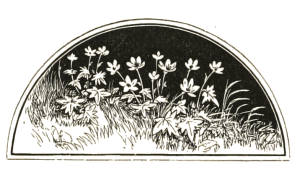
CHAPTER II.
EXAMPLE FROM THE FORGET–ME–NOT FAMILY.
ill9
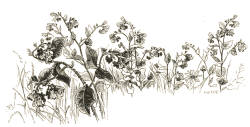
Caucasian Comfrey in shrubbery.
I will now endeavour to illustrate my meaning by showing what may be done with one type of northern vegetation— that of the Forget–me–not order, one far from being as rich as others in subjects suited for the wild garden. Through considering its capabilities in this way, the reader may be able to form some idea of what we may do by selecting from the numerous plants that grow in the meadows and mountain–woods of Europe, Asia, and America.
The Forget–me–not or Borage family is a well–marked and well–known one, containing a great number of coarse weeds, but which, if it possessed only the common Forget–me–not, would have some claims on us. Many persons are not acquainted with more than the Forget–me–nots; but what lovely exotic plants there are in this order that would afford delight if met with creeping about along our wood and[10] shrubbery walks! Nature, say some, is sparing of her deep true blues; but there are obscure plants in this order that possess the truest, deepest, and most delicate of blues, and which will thrive as well in the wild garden as common weeds. The creeping Omphalodes verna even surpasses the Forget–me–not in the depth and beauty of its blue and its other good qualities, and runs about quite freely in any shady or half–shady shrubbery or open wood, or even in turf in moist soil not very frequently mown. Its proper home is the wood or semi–wild spot, where it takes care of itself. Put it in a garden, and probably, unless the soil and region be moist, it soon perishes. Besides, in the border, it would be a not very agreeable object when once the sweet spring bloom had passed; whereas, in the positions spoken of, in consequence of the predominance of trees, shrubs, and tall herbs, the low plants are not noticed when out of flower, but crawl about unobserved till returning spring reminds those fortunate enough to see them how superior is the inexpensive and natural kind of gardening here advocated.
Another plant of the order is so suitable and useful for this purpose, that if a root or two of it be planted in any shrubbery, it will soon run about, exterminate the weeds, and prove quite a lesson in wild gardening. I allude to the Caucasian Comfrey (Symphytum caucasicum), which grows about twenty inches high, and bears quantities of the loveliest blue pendulous flowers. It, like many others, does much better in a wood, grove, or any kind of shrubbery, than in any other position, filling in the naked spaces between the trees and shrubs, and has a quick–growing and spreading tendency, but never becomes weedy or objectionable. As if to contrast[11] with it, there is the deep crimson Bohemian Comfrey (S. bohemicum), which is sometimes startling from the depth of its vivid colouring; and the white Comfrey (S. orientale), quite a vigorous–growing kind, blooming early in April and May, with the blue Caucasian C.
These Comfreys, indeed, are admirable plants for rough places—the tall and vigorous ones thriving in a ditch or any similar place, and flowering much better and longer than they ever did in the garden proper, in prim borders. There are about twenty species, mostly from Southern and Central Europe, Asia, and Siberia.
I purposely omit the British Forget–me–nots, wishing now chiefly to show what we may do with exotics quite as hardy as our own wildlings; and we have another Forget–me–not, not British, which surpasses them all—the early Myosotis dissitiflora. This is like a patch of the bluest sky settled down among the moist stones of a rockwork or any similar spot, before our own Forget–me–not has opened its blue eyes, and is admirable for blades or banks in wood or shrubbery, especially in moist districts.
For rocky bare places and sunny sandy banks we have the spreading Gromwell (Lithospermum prostratum), which, when in flower, looks just as if some exquisite alpine Gentian had assumed the form of a low bush, to enable it to hold its own among creeping things and stouter herbs than accompany it on the Alps. The Gromwells are a large and important genus but little known in gardens, some of them, like our native kind, being handsome plants.
Among the fairest plants we have are the Lungworts, Pulmonaria, too seldom seen, and partly destroyed through[12] exposure on bare dug and often dry border. The old Pulmonaria (Mertensia virginica) is one of the loveliest spring flowers ever introduced. It is very rare in gardens, but if placed in a moist place near a stream, or in a peat bottom, it will live; whereas it frequently dies in a garden. The newer and more easily grown Mertensia sibirica is a lovely plant, taller and flowering longer. These two plants alone would repay any one for a trial of the wild garden, and will illustrate the fact that for the sake of culture alone (apart from art, beauty, or arrangement) the wild–garden idea is worth carrying out.
Among the many plants suitable for the wild garden none look more at home than Borage, a few seeds of which scattered over fresh dry ground soon germinate, and form fine patches that will flower during the summer. Although only an annual, once it is introduced there is no fear of losing it, as it comes up somewhere near the same spot each succeeding year, and when in bloom the peculiar Solanum–like shape of the blossoms, and their rich blue colour, make it beautiful.
The Cretan Borage is a curious old perennial, seldom seen in gardens; and deservedly so, for its growth is robust and its habit coarse. It is, however, a capital plant for the wild garden, or for rough places—in copse, or shrubbery, or lane, where the ample room which it requires would not be begrudged, and where it may take care of itself from year to year, showing among the boldest and the hardiest of the early spring flowers.
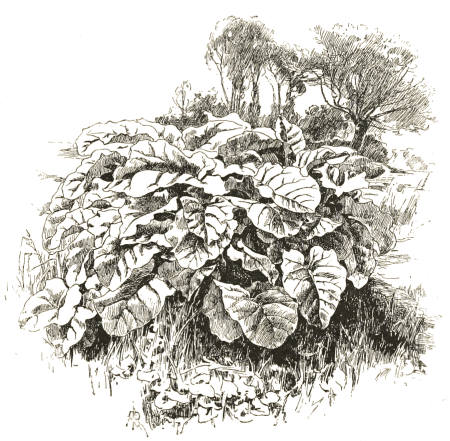
The Cretan Borage (Borago Cretica).
Thus, though I say little of the Alkanet (Anchusa) tribe, several of which could be found worth a place with our own handsome Evergreen Alkanet, and do not mention other important[13] genera, it will be seen that a whole garden of beauty may be reaped from this tribe alone. Any one who doubts the advantages of carrying out the idea of the wild garden could settle the matter to his satisfaction in a couple of years with these plants alone, in a shrubbery, ditch, lane, copse, or wood, always providing that he takes care to adapt each kind to the position and the soil. For instance, the Giant Comfrey will grow six feet high in rich or moist soil in a partially shaded ditch, and therefore, once fairly started, might be trusted to take care of itself in any position. The Caucasian Comfrey, on the other hand, grows from eighteen inches to two feet high, and is at home in the spaces in a copse or[14] shrubbery. The creeping Forget–me–not (Ompalodes verna) is a little plant that creeps about in grass or among vegetation, not over a span high, or forms a carpet of its own—these points must be considered, and then the rest is gardening of the happiest kind only. These Borageworts, richer in blue flowers than even the gentians, are usually poor rusty things in exposed sunny borders, and also much in the way when out of flower, whereas in shady lanes, copses, open parts of not too dry or impoverished shrubberies, in hedgerow–banks, or ditches, we only notice them in their beautiful bloom.
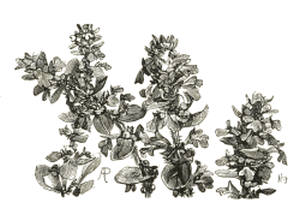
Flowers of Geneva Bugle (Ajuga genevensis), Dwarf Boragewort.
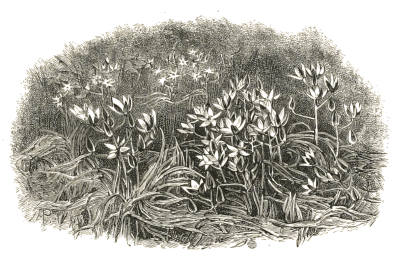
Star of Bethlehem in Grass.
CHAPTER III.
EXAMPLE FROM HARDY BULBS AND TUBERS IN GRASS.
We will now turn from the Forget–me–not order to a very different type of vegetation—hardy bulbs and other plants dying down after flowering early in the year, like the Winter Aconite and the Blood–root (Sanguinaria). How many of us really enjoy the beauty which a judicious use of a profusion of hardy Spring–flowering Bulbs affords? How many get beyond the miserable conventionalities of the flower–garden, with its edgings and patchings, and taking up, and drying, and mere playing with our beautiful Spring Bulbs? How many enjoy the exquisite beauty afforded by flowers of this class, established naturally, without troubling us for attention at any time? The subject of decorating with Spring–flowering Bulbs is merely in its infancy; at present we merely place a few of the showiest of them in geometrical lines. The little we do leads to such a very poor result, that numbers of people,[16] alive to the real charms of a garden too, scarcely notice Spring Bulbs at all, regarding them as things which require endless trouble, as interfering with the “bedding–out;” and in fact, as not worth the pains they occasion. This is likely to be the case so long as the most effective and satisfactory of all modes of arranging them is unused; that way is the placing of them in wild and semi–wild parts of country seats, and in the rougher parts of a garden, no matter where it may be situated or how it may be arranged. This way will yield more real interest and beauty than any other.
Look, for instance, at the wide and bare belts of grass that wind in and around the shrubberies in nearly every country place; frequently, they never display a particle of plant–beauty, and are merely places to be roughly mown now and then. But if planted here and there with the Snowdrop, the blue Anemone, the Crocus, Scillas, and Winter Aconite, they would in spring surpass in attractiveness the gayest of spring gardens. Cushioned among the grass, these would have a more congenial medium in which to unfold than is offered by the beaten sticky earth of a border; in the grass of spring, their natural bed, they would look far better than ever they do when arranged on the bare earth of a garden. Once carefully planted, they—while an annual source of the greatest interest—occasion no trouble whatever.ill16
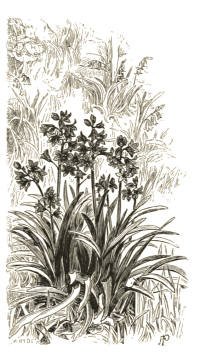
The association of exotic and British wild flowers in the Wild Garden.—The Bell–flowered Scilla, naturalised with our own Wood Hyacinth.
Their leaves die down so early in spring that they would scarcely interfere with the mowing of the grass, if that were desired, but I should not attempt to mow the grass in such places till the season of vernal beauty had quite passed by. Surely it is enough to have a portion of lawn as smooth as a carpet at all times, without sending the mower to shave the[17] “long and pleasant grass” of the other parts of the grounds. It would indeed be worth while to leave many parts of the grass unmown for the sake of growing many beautiful plants in it. If in some spot where a wide fringe of grass spreads out in the bay of a shrubbery or plantation, and upon this carpet of rising and unshaven verdure there be dotted, in addition to the few pretty natural flowers that happened to take possession of it, the blue Apennine Anemone, the Snowdrop, the Snowflake, Crocuses in variety, Scillas, Grape–Hyacinths, earlier and smaller Narcissi, the Wood Anemone, and any other pretty Spring flowers that were suitable to the soil and position, we should have a glimpse of the vernal beauty of temperate and northern climes, every flower relieved by grass blades and green leaves, the whole devoid of any trace of man, or his exceeding weakness for tracing wall–paper patterns, where everything should be varied, indefinite, and changeful. In such a garden it would be evident that the artist had caught the true meaning of nature in her disposition of vegetation, without sacrificing one jot of anything of value in the garden, but, on the contrary, adding the highest beauty to spots devoid of the slightest interest. In connection with this matter I may as well say here that mowing the grass once[18] a fortnight in pleasure grounds, as now practised, is a great and costly mistake. We want shaven carpets of grass here and there, but what cruel nonsense both to men and grass it is to shave as many foolish men shave their faces! There are indeed places where they boast of mowing forty acres! Who would not rather see the waving grass with countless flowers than a close shaven surface without a blossom? Imagine the labour wasted in this ridiculous labour of cutting the heads off flowers and grass. Let the grass grow till fit to cut for hay, and we may enjoy in it a world of lovely flowers that will blossom and perfect their growth before the grass has to be mown; more than one person who has carried out the ideas expressed in this book has waving lawns of feathery grass where he used to shave the grass every ten days; a prairie of flowers where a daisy was not allowed to peep; and some addition to his hay crop as he allows the grass to grow till it is fit for that purpose.
It is not only to places in which shrubberies, and plantations, and belts of grass in the rougher parts of the pleasure–ground, and shady moss–bordered wood–walks occur that these remarks apply. The suburban garden, with its single fringe of planting, may show like beauty, to some extent. It may have the Solomon’s Seal arching forth from a shady recess, behind tufts of the sweet–scented Narcissus, while in every case there may be wild fringes of strong and hardy flowers in the spring sun, and they cannot be cut off by harsh winds as when exposed in the open garden. What has already been stated is, I hope, sufficient to show to everybody the kind of place that may be used for their culture. Wild and semi–wild places, rough banks in or near the pleasure–ground or flower–garden,[19] such spots as perhaps at present contain nothing but weeds, or any naturally rough or unused spot about a garden—such are the places for them. Even where all the lawn must be mown the Snowdrop may be enjoyed in early spring, for its leaves die down, or at all events ripen sufficiently before there is any occasion to mow the grass.

The Turk’s Cap Lily, naturalised in the grass by wood–walk.
But the prettiest results are only attainable where the grass need not be mown till nearly the time the meadows are mown. Then we may have gardens of Narcissi, such as men never dared to dream about a dozen years ago; such as no one ever thought possible in a garden. In grass not mown at all we may even enjoy many of the Lilies, and all the lovelier and more stately bulbous flowers of the meadows and mountain lawns of Europe, Asia, and America.
On a stretch of good grass which need not be mown, and on fairly good soil in any part of our country, beauty may be[20] enjoyed such as has hitherto only gladdened the heart of the rare wanderer on the high mountain lawns and copses, in May when the earth children laugh in multitudes on their mother’s breast.
All planting in the grass should be in natural groups or prettily fringed colonies, growing to and fro as they like after planting. Lessons in this grouping are to be had in woods, copses, heaths, and meadows, by those who look about them as they go. At first many will find it difficult to get out of formal masses, but that may be got over by studying natural groupings of wild flowers. Once established, the plants soon begin to group themselves in a way that leaves nothing to desire.

Crocuses in turf, in grove of Summer leafing trees.
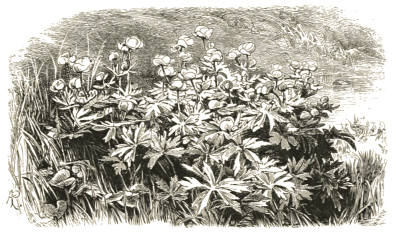
Group of Globe flowers (Trollius) in marshy place: type of the nobler Northern flowers little cultivated in gardens.
CHAPTER IV.
EXAMPLE FROM THE GLOBE FLOWER ORDER.
Let us next see what may be done with the Buttercup order of plants. It embraces many things widely diverse in aspect from these burnished ornaments of northern meadows and mountains. The first thing I should take from it to embellish the wild wood is the sweet–scented Virgin’s Bower (Clematis flammula), a native of the south of Europe, but as hardy and free in all parts of Britain as the common Hawthorn. And as the Hawthorn sweetens the breath of early summer, so will this add fragrance to the autumnal months. It is never to be seen half so beautiful as when crawling over some tree or decayed stump; and if its profuse masses of white bloom do not attract, its fragrance is sure to do so. An open glade in a wood, or open spaces on banks near a wood or shrubbery, would be charming for it, while in the garden or pleasure–ground it may be used[22] as a creeper over old stumps, trellising, or the like. Clematis campaniflora, with flowers like a campanula, and of a pale purplish hue, and the beautiful white Clematis montana grandiflora, a native of Nepaul, are almost equally beautiful, and many others of the family are worthy of a place, rambling over old trees, bushes, hedgerows, or tangling over banks. These single wild species of Clematis are more graceful than the large Hybrids now common; they are very hardy and free. In mild and seashore districts a beautiful kind, common in Algeria, and in the islands on and the shores of the Mediterranean (Clematis cirrhosa), will be found most valuable—being nearly evergreen, and flowering very early in spring—even in winter in the South of England.ill22
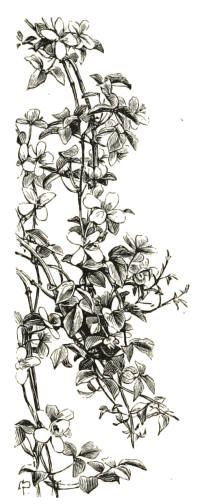
The Mountain Clematis (C. montana).
Next in this order we come to the Wind Flowers, or Anemones, and here we must pause to select, for more beautiful flowers do not adorn this world of flowers. Have we a bit of rich grass not mown? If so, the beautiful downy white and yellow Anemones of the Alps (A. alpina and A. sulphurea) may be grown there. Any sunny bushy bank or southern slope which we wish to embellish with vernal beauty? Then select Anemone blanda, a small but lovely blue kind; place it in open bare spots to begin with, as it is very dwarf, and it will at Christmas, and from that time onward through the spring, open its large flowers of the deepest sky blue.[23] The common garden Anemone (A. Coronaria) will not be fastidious, but had better be placed in open bare sandy places; and the splendid Anemone fulgens will prove most attractive, as it glows with fiery scarlet. Of other Anemones, hardy, free, and beautiful enough to be made wild in our shrubberies, pleasure–grounds, and wilds, the Japan Anemone (A. japonica) and its white varieties, A. trifolia and A. sylvestris, are the best of the exotic species. The Japan Anemones grow so strongly that they will take care of themselves even among stiff brushwood, brambles, etc.; and they are beautifully fitted for scattering along the low, half–wild margins of shrubberies and groups. The interesting little A. trifolia is not unlike our own wood Anemone, and will grow in similar places.ill23
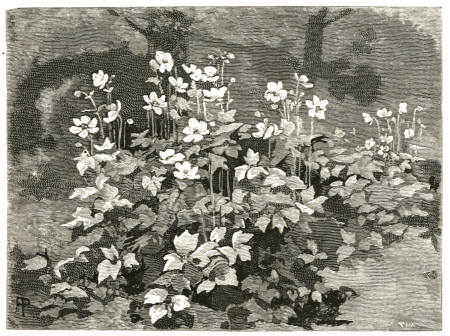
The White Japan Anemone in the Wild Garden.
Few plants are more lovely in the wild garden than the White Japan Anemone. The idea of the wild garden first arose in the writer’s mind as a home for a numerous class of coarse–growing plants, to which people begrudge room in their borders, such as the Golden Rods, Michaelmas Daisies, Compass plants, and a host of others, which are beautiful for a season only, or perhaps too rampant for what are called choice borders and beds. This Anemone is one of the most beautiful of garden flowers, and one which is as well suited for the wild garden as the kinds alluded to. It grows well in any good soil in copse or shrubbery, and increases rapidly. Partial shade seems to suit it; and in any case the effect of the large white flowers is, if anything, more beautiful in half–shady places. The flowers, too, are more lasting here than where they are fully exposed.
As for the Apennine Anemone (the white as well as the blue variety), it is one of the loveliest spring flowers of any clime, and should be in every garden, in the borders, and scattered thinly here and there in woods and shrubberies, so that it may become “naturalised.” It is scarcely a British flower, being a native of the south of Europe; but having strayed into our wilds and plantations occasionally, it is now included in most books on British plants. The yellow A. ranunculoides, a doubtful native, found in one or two spots, but not really British, is well worth growing, thriving well on the chalk, and being very beautiful.
The large Hepatica angulosa will grow almost as freely as Celandine among shrubs and in half–shady spots, and we all know how readily the old kinds grow on all garden soils of ordinary quality. There are about ten or twelve varieties of the common Hepatica (Anemone Hepatica) grown in British nurseries and gardens, and all the colours of the species should be represented in every collection of spring flowers.[25]
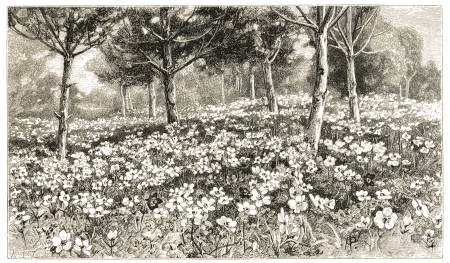
Anemones in the Riviera. Thrive equally well in any open soil here, only flowering later.
There are many of the Ranunculi, not natives of Britain, which would grow as freely as our native kinds. Many will doubtless remember with pleasure the pretty button–like white flowers of the Fair Maids of France (Ranunculus aconitifolius fl. pl.), a frequent ornament of the old mixed border. This, and the wild form from which it comes—a frequent plant in alpine meadows—may also be enjoyed in our wild garden. Quite distinct from all these, and of chastest beauty when well grown, is R. amplexicaulis, with flowers of pure white, and simple leaves of a dark glaucous green and flowing graceful outline; a hardy and charming plant on almost any soil. This is one of the elegant exotic forms of a family well represented in the golden type in our meadows, and therefore it is welcome as giving us a strange form. Such a plant deserves that pains be taken to establish it in good soil, in spots where a rank vegetation may not weaken or destroy it.
Of the Globe Flowers (Trollius), there are various kinds apart from our own, all rich in colour, fragrant, and hardy in a remarkable degree. These are among the noblest wild–garden plants—quite hardy, free of growth in the heaviest of soil and wettest of climates, affording a lovely type of early summer flower–life, and one distinct from any usually seen in our fields or gardens; for these handsome Globe flowers are among the many flowers that for years have found no place in the garden proper. They are lovely in groups or[26] colonies, in cold grassy places, where many other plants would perish.ill26
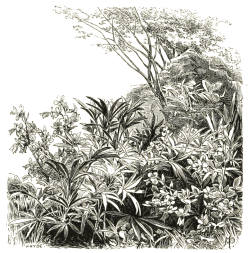
The Green Hellebore in the Wild Garden.
The Winter Aconite (Eranthis hyemalis) should be naturalised in every country seat in Britain—it is as easy to do so as to introduce the thistle. It may be placed quite under the branches of deciduous trees, will come up and flower when the trees are naked, will have its foliage developed before the leaves come on the trees, and be afterwards hidden from sight. Thus masses of this earliest flower may be grown without the slightest sacrifice of space, and only be noticed when bearing a bloom on every little stem. That fine old little plant, the Christmas Rose (Helleborus niger), likes partial shade better than full exposure, and should be used abundantly, giving it rather snug and warm positions, so that its flowers may be encouraged to open well and fully. Any other kinds might also be used. Recently many kinds of Helleborus have been added to our gardens, not all of them so conspicuous at first sight as the Christmas Rose, yet they are of remarkable beauty of foliage and habit as well as of blossom, and they flower in the spring. These, too, show the advantage of the wild garden as regards cultivation. They[27] will thrive much better in any bushy places, or copses, or in mutually sheltering groups on warm banks and slopes, even in hedge banks, old quarries, or rough mounds, than in the ordinary garden border. Of the difference in the effect in the two cases it is needless to speak.
Some of the Monkshoods are very handsome, but all of them virulent poisons; and, bearing in mind what fatal accidents have arisen from their use, they are better not used at all in the garden proper. Amongst tall and vigorous herbaceous plants few are more suitable for wild and semi–wild places. They are hardy and robust enough to grow anywhere in shady or half–shady spots; and their tall spikes, loaded with blue flowers, are very beautiful. An illustration in the chapter on the plants suited for the wild garden shows the common Aconite in a Somersetshire valley in company with the Butterbur and the Hemlock. In such a place its beauty is very striking. The larger rich blue kinds, and the blue and white one, are very showy grown in deep soils, in which they attain a great height. When out of flower, like many other stately Perennials, they were often stiff and ugly in the old borders and beds. In the wild garden their stately beauty will be more remarkable than ever under the green leaves in copses and by streams. And when flower–time is gone, their stems, no longer tied into bundles or cut in by the knife, will group finely with other vigorous herbaceous vegetation.
The Delphiniums, or tall Perennial Larkspurs, are amongst the most beautiful of all flowers. They embrace almost every shade of blue, from the rich dark tone of D. grandiflora to the[28] charming cærulean tints of such as D. Belladonna; and being usually of a tall and strong type, will make way among long grasses and vigorous weeds, unlike many things for which we have to recommend an open space, or a wood with nothing but a carpet of moss under the trees.28
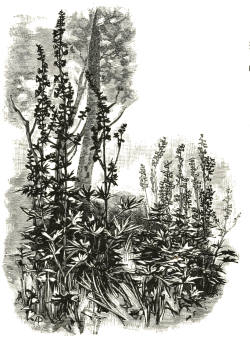
Tall Perennial Larkspurs, naturalised in Shrubbery (1878).
One of the prettiest effects which I have ever seen was a colony of tall Larkspurs. Portions of old roots of several species and varieties had been chopped off when a bed of these plants was dug in the autumn. For convenience sake the refuse had been thrown into the neighbouring shrubbery, far in among the shrubs and trees. Here they grew in half–open spaces, which were so far removed from the margin that they were not dug and were not seen. When I saw the Larkspurs in flower they were certainly the loveliest things that one could see. They were more beautiful than they are in borders or beds, not growing in such close stiff tufts, but mingling with and relieved by the trees above and the shrubs around. Little more need be said to any one who knows and cares about such plants, and has an opportunity of planting in such neglected places. This case points out that one might make wild gardens from the mere parings and thinnings of[29] the beds and borders in autumn in any place where there is a collection of good hardy plants.
The engraving on the next page represents one of the most beautiful effects obtained in his wild garden by an acquaintance of mine who began when he knew very little of plants and their favoured haunts, and succeeded well in a not very favourable site. Herbaceous Pæonies were amongst those that succeeded best. The effect was very beautiful, either close at hand or seen at a considerable distance off. Herbaceous Pæonies are amongst the most free, vigorous, and hardy of perennial plants, and with them alone most novel and beautiful effects may be carried out in most places where there is room. Even in comparatively small gardens, a group or two outside the margin of a shrubbery would be desirable. The effect of the blooms amongst the long grass of the wild garden is finer than any they present in borders, and when out of flower they do not seem to be in the way, as they often are thought to be when in borders and beds. It is almost needless to speak here of the great variety of forms now obtainable amongst these herbaceous Pæonies, many of which are agreeably scented. The older forms were not remarkable in that respect, but rather the contrary. In addition to the splendour of colour for which Pæonies are long and well known, there are now many delicately–coloured and tinted varieties. The whole race is undeservedly neglected. People spend plenty of money on greenhouses which will never produce anything so handsome as a well–grown group of herbaceous Pæonies in the open garden; yet when they are grown they are often begrudged a few feet of good soil, though that is all they would require for years at a time. My friend’s[30] Pæonies formed a group that could be seen from a distance; when I saw them they were surrounded by long and waving grass. I cannot give any idea of the fine effect.

Double Crimson Pæonies in grass.
The Clematis–like Atragene alpina is one of my favourite flowers—seldom seen now–a–days, or indeed at any time, out of a botanical garden, and till lately not often seen in one. It likes to trail over an old stump, or through a thin low bush, or over a rocky bank, and it is a perfectly hardy plant. Speaking of such plants as this, one would like to draw a sharp distinction between them and the various weedy and indistinct subjects which are now creeping into cultivation owing to the revival of interest in hardy plants. Many of these have some botanical interest, but they can be only useless in the garden. Our chief danger now is getting plants into cultivation which are neither very distinct nor very beautiful, while perhaps we neglect many of the really fine kinds. This[31] Atragene is a precious plant for low bush and bank wild garden.
Among plants which one never sees, and which, indeed, one never ought to see, in a flower garden, are the Meadow Rues; and yet there is a quiet beauty and grace about these plants which entitle them to some consideration; and the flowers, too, of certain species, particularly the one here shown in the illustration on page 1, are of singular beauty. When it is considered that all the species will grow anywhere—in any hedgerow or lane or byeway, or among coarse grass, or in a copse, or under the shrubs, in places usually abandoned to common weeds, there is no reason why numbers of them should not be rescued from the oblivion of the botanic garden.
CHAPTER V.
PLANTS CHIEFLY FITTED FOR THE WILD GARDEN.
ill32
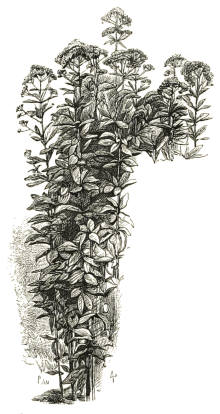

The Giant Scabious (8 feet high). (Cephalaria procera.)
What first suggested the idea of the wild garden, and even the name to me, was the desire to provide a home for a great number of exotic plants that are unfitted for garden culture in the old sense. Many of these plants have great beauty when in flower, and perhaps at other seasons, but they are frequently so free and vigorous in growth that they overrun and destroy all their more delicate neighbours. Many, too, are so coarse that they are objectionable in choice borders, and after flowering they leave a blank or a mass of unsightly stems. These plants are unsightly in gardens, and the main cause of the neglect of hardy flowers; yet many are beautiful at certain stages. A tall Harebell, for example, stiffly tied up in a garden border, as has been the fashion where plants of this kind have been grown at all, is at best of times an unsightly object; but the same plant growing amongst the long[33] grass in a thin wood is lovely. The Golden–rods and Michaelmas Daisies used to overrun the old mixed border, and were with it abolished. But even the poorest of these seen together in a New England wood in autumn form a picture. So also there are numerous exotic plants of which the individual flowers may not be so striking, but which, grown in groups and colonies, and seen at some little distance off, afford beautiful aspects of vegetation, and quite new so far as gardens are concerned. When I first wrote this book, not one of these plants was in cultivation outside botanic gardens. It was even considered by the best friends of hardy flowers a mistake to recommend one of them, for they knew that it was the predominance of these weedy vigorous subjects that made people give up hardy flowers for the sake of the glare of bedding plants; therefore, the wild garden in the case of these particular plants opens up to us a new world of infinite and strange beauty. In it every plant vigorous enough not to require the care of the cultivator or a choice place in the[34] mixed border will find a home. Of such plants there are numbers in every northern and mountainous country, which travellers may gather and afterwards grow in their own gardens. The taller Achilleas, the stately Aconites, the seldom–seen Actæas, the huge and vigorous, but at certain seasons handsome, Althæas, Angelica with its fine foliage, the herbaceous kinds of Aralia from the American woods, also with fine foliage, the Wormwood family (Artemisia), the stronger kinds of American cotton–weed (Asclepias), certain of the vigorous species of Asparagus, Asters and their allies in great variety, the larger and more vigorous species of Astragalus, certain of the larger species of Betonica, pretty, and with delicate flowers, but hardly fit for the mixed border, various free and vigorous exotic Grasses, large and showy Bupthalmums, the handsome creeping Bindweeds, too free in a garden, the most vigorous Campanulas, exotic Thistles (Carduus) and their allies, the more remarkable kinds of Carex, numerous Centaureas, somewhat too coarse for the garden; and among other strong and hardy genera, the following are chiefly suitable for the wild garden:
| Crambe. | Galega. | Rhaponticum. |
| Digitalis. | Helenium. | Rheum. |
| Dipsacus. | Helianthus. | Rudbeckia. |
| Doronicum. | Heracleum. | Scolymus. |
| Echinacea. | Inula. | Senecio. |
| Echinops. | Kitaibelia. | Sida. |
| Elymus. | Lavatera. | Silphium. |
| Epilobium. | Ligularia. | Solidago. |
| Eryngium. | Ligusticum. | Sonchus. |
| Eupatorium. | Mulgedium. | Symphytum. |
| Euphorbia. | Onopordon. | Veratrum. |
| Ferula. | Phytolacca. | Verbascum. |
| Funkia. | Polygonum. | Vernonia. |
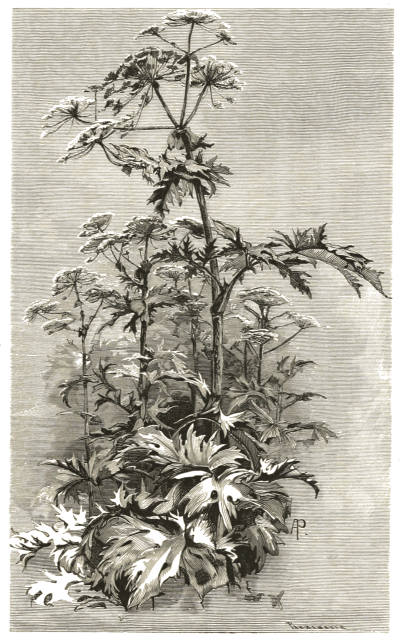
Giant Cow Parsnip. Type of Great Siberian herbaceous vegetation. For rough places only.
CHAPTER VI.
DITCHES AND NARROW SHADY LANES, COPSES, HEDGEROWS,
AND THICKETS.
ill36
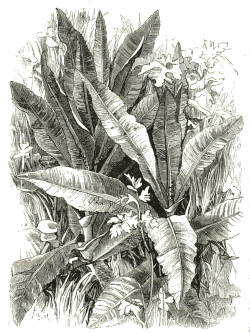
Foliage of Dipsacus, on hedge–bank in spring.
Men usually seek sunny positions for their gardens, so that even those obliged to be contented with the north side of the hill would scarcely appreciate some of the above–named positions. What, the gloomy and weedy dyke as a garden! Yes, there are ditches, dry and wet, in every district, that may readily be made more beautiful than many a “modern flower–garden.” But what would grow in them? Many of the beautiful wood and shade–loving plants of our own and similar latitudes—things that love not the open sunny hill–sides or wide meadows, but take shelter in the stillness of deep woods or in dark valleys, are happy deep[37] between riven rocks, and gaily occupy the little dark caves beneath the great boulders on many a horror–stricken mountain gorge, and which garland with inimitable grace the vast flanks of rock that guard the dark courses of the rivers on their paths through the hills. And as these dark walls, ruined by ceaseless pulse of the torrent, are beautiful exceedingly, how much more may we make all the shady dykes and narrow lanes that occur everywhere! For while the nymph–gardener of the ravine may depend for her novelties on the stray grains of seeds brought in the moss by the robin when building her nest, or on the mercy of the hurrying wave, we may place side by side the snowy white wood lily (Trillium grandiflorum), whose home is in the shades of the American woods, with the twin flower of Scotland and northern Europe, and find both thrive on the same spot in happy companionship. And so in innumerable instances. And not only may we be assured of numbers of the most beautiful plants of other countries thriving in deep ditches and in like positions, but also that not a few of them, like the white wood lily, will thrive much better in them than in any position in garden borders. This plant, when in perfection, has a flower as fair as any white lily, while it is seldom a foot high; but, in consequence of being a shade–loving and wood plant, it usually perishes in the ordinary garden bed or border, while in a shady dyke or any like position it will be found to thrive as well as in its native woods; and if in deep, free, sandy, or vegetable soil, to grow so as not to be surpassed in loveliness by anything seen in our stoves or greenhouses.
Our wild flowers take possession of the stiff, formal, and[38] shorn hedges that seam the land, often draping them with such inimitable grace that half the conservatories in the country, with their collections of small red pots and small mean plants are stiff and poor compared with a few yards’ length of their blossomy verdure. The Wild Roses, Purple Vetch, Honeysuckle, and the Virgin’s Bower, clamber above smaller, but not less pretty, wildlings, and throw a veil of graceful life over the mutilated shrubs, reminding us of the plant–life in the nest–like thickets of dwarf shrubs that one often meets on the high Alpine meadows. In these islets of bushes in a sea of grass one may gather flowers after they have been all browsed down on the turf. Next to the most interesting aspects of Alpine vegetation, there is perhaps nothing in the world of plant–life more lovely than the delicate tracery of low–climbing things wedded to the bushes in all northern and temperate regions of the earth. Perishing like the grass, they are happy and safe in the earth’s bosom in winter; in spring they come up as the buds swell, and soon after, finding the bushes once more enjoyable, rush over them as joyously as children from school over a meadow of cowslips. Over bush, over brake, on mountain or lowland copse, holding on with delicate but unyielding grasp, they engrave themselves on the mind as the central type of grace. In addition to climbing Pea–flowers, Convolvuluses, etc., of which the stems perish in winter, we have the great tribes of wild vines, noble in foliage and often in fruit, the numerous Honeysuckles, from coral red to pale yellow, all beautiful; and the Clematidæ, rich, varied, and lovely beyond description, from those of which each petal reminds one of the wing of some huge[39] tropical butterfly, to those with small flowers borne in showers like drops from a fountain jet, and often sweet as Hawthorn blossoms.ill39
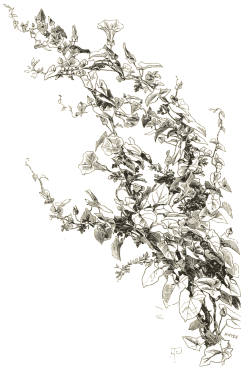
The large white Bindweed, type of nobler climbing plants, with annual stems. For copses, hedgerows, and shrubberies.
This climbing vegetation may be trained and tortured into forms in gardens, but never will its beauty be seen until we entrust it to the garlanding of shrub, and copse, or hedgerow, fringes of dwarf plantation, or groups of shrubs and trees. All to be done is to put in a few tufts of any desired kind, and leave them alone, adapting the kind to the position. The large, flesh–coloured Bindweed, for example, would be best in rough places, out of the pale of the pleasure–ground or garden, so that its roots would not spread where they could do harm, while a delicate Clematis might be placed beneath the choicest specimen Conifer, and allowed to paint its rich green with fair flowers. In nature we frequently see a Honeysuckle clambering up through an old Hawthorn tree, and then struggling with it as to which should produce the greatest profusion[40] of blossoms—but in gardens not yet. Some may say that this cannot be done in gardens; but it can be done infinitely better in gardens than it has ever been done in nature; because, for gardens we can select plants from many countries. We can effect contrasts, in which nature is poor in any one place in consequence of the comparatively few plants that naturally inhabit one spot of ground. People seldom remember that “the art itself is nature;” and foolish old laws laid down by landscape–gardeners are yet fertile in perpetuating the notion that a garden is a “work of art, and therefore we must not attempt in it to imitate nature.”ill40
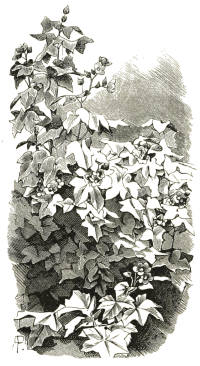
The Nootka Bramble; type of free–growing flowering shrub. For copses and woods.
Sometimes, where there are large and bare slopes, an excellent effect may be obtained by planting the stouter climbers, such as the Vines, Mountain Clematis, and Honeysuckles, in groups or masses on the grass, away from shrubs or low trees; while, when the banks are precipitous or the rocks crop forth, we may allow a curtain of climbers to fall over them.
Endless charming combinations may be made in this way in many spots near most country houses. The following genera are among the climbing and clinging hardy plants most suitable for garlanding copses, hedges, and thickets:—Everlasting Peas (many kinds), the hardy exotic Honeysuckles, Clematis (wild species mainly), the common Jasmine,[41] the double Bramble, Vines (American and the common varieties), single Roses, the Virginian creepers (Ampelopsis), the large Bindweed (Calystegia dahurica), Aristolochia Sipho, and A. tomentosa, and several of the perennial Tropæolums, T. pentaphyllum, speciosum, and tuberosum. The hardy Smilax, too, are very handsome, and the Canadian Moonseed, only suitable for this kind of gardening.
Among the families of plants that are suitable for the various positions enumerated at the head of this chapter may be named—Acanthus, any variety, Viola, both the sweet varieties and some of the large scentless kinds, the Periwinkle, Speedwells, Globe Flowers, Trilliums, Plume Ferns (Struthiopteris), and many other kinds, the Lily of the Valley and its many varieties and allies, the Canadian Bloodwort, the Winter Greens (Pyrola), Solomon’s Seal, and allied exotic species, the May Apple, Orobus in variety, Narcissi, many, the Common Myrrh, the perennial Lupin, hardy common Lilies, the Snowflakes, all kinds of Everlasting Peas and allied plants, admirable for scrambling through low hedges and over bushes, Windflowers, the taller and stronger kinds in lanes and hedgerows, the various Christmas Roses which will repay for shelter, the European kinds of Gladiolus, such as segetum and Colvilli, the taller and more vigorous Cranes Bills (Geranium), the Snake’s Head (Fritillaria) in variety, Strawberries of any variety or species, the beautiful Plume–leaved Giant Fennel, Dog’s Tooth Violets in bare spots or spots bare in spring, the Winter Aconite, the Barren Worts, for peaty spots or leaf soil, the May Flower, for sandy poor soil under trees, the Dentaria, the coloured and showier forms of Primroses, Oxslips, Polyanthus, the hardy European Cyclamens[42] in carefully chosen spots, Crocuses in places under branches and trees not bearing leaves in Spring, the yellow and pink Coronilla (C. montana and C. varia), the larger forms of Bindweed, many of the taller and finer Harebells, Starworts (Aster), for hedgerows, and among the taller plants the Italian Cuckoo Pint (Arum), and also the Dragons, for warm sandy soils, the Monkshoods which people fear in gardens and which do admirably in many positions; the different species of Onion, also unwelcome in gardens, some of which are very beautiful, as, for example, the White Provence kind and the old yellow garden Allium (Moly). With the above almost exclusively exotic things and our own wild flowers and ferns beautiful colonies may be made.
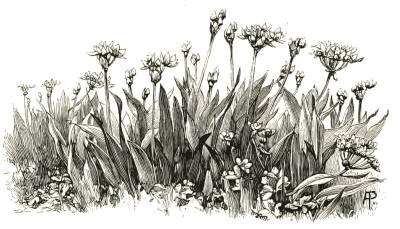
The Yellow Allium (A. Moly) naturalised.
CHAPTER VII.
DRAPERY FOR TREES AND BUSHES.
ill43

The numerous hardy climbers which we possess are very rarely seen to advantage, owing to their being stiffly trained against walls. Indeed, the greater number of hardy climbers have gone out of cultivation mainly for this reason. One of the happiest of all ways of using them is that of training them in a free manner over trees; in this way many beautiful effects may be secured. Established trees have usually exhausted the ground near their base, which may, however, afford nutriment to a hardy climbing shrub. In some low trees the graceful companion may garland their heads; in tall ones the stem only may at first be adorned. But some vigorous climbers could in time ascend the tallest trees, and there can be nothing more beautiful than a veil of such a one as Clematis montana suspended from the branch of a tall tree. A whole host of lovely plants may be seen to great advantage in this way, apart from the well–known and popular climbing plants. There are, for example, many species of Clematis which[44] have never come into cultivation, but which are quite as beautiful as any climbers. The same may be said of the Honeysuckles, wild Vines, and various other families of which the names may be found in catalogues. Much of the northern tree and shrub world is garlanded with creepers, which may be grown in similar ways, as, for example, on banks and in hedgerows. The trees in our pleasure–grounds, however, have the first claim on our attention in planting garlands.[45] There would seldom be need to fear injury to established trees.
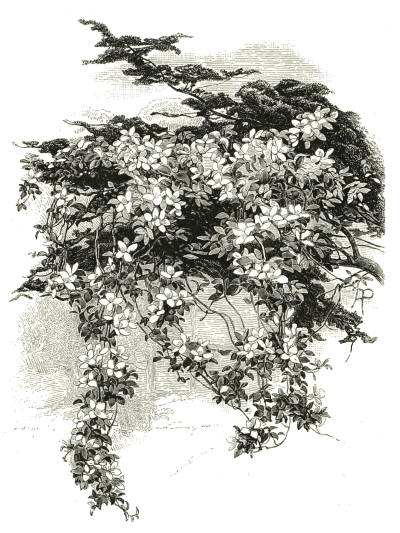
Large White Clematis on Yew tree at Great Tew. (C. montana grandiflora.)
Some time ago I saw a Weeping Willow, on the margin of a lake, that had its trunk clothed with Virginian Creeper, and the effect in autumn, when the sun shone through the drooping branches of the Willow—whose leaves were just becoming tinged with gold—upon the crimson of the creeper–covered trunk was very fine. The Hop is a very effective plant for draping a thin specimen Arbor–vitæ, or Yew tree, but the shoots should be thinned out in spring, and not more than three or four allowed to climb up to the tree. When the leader emerges from the top of the bush, and throws its long, graceful wreaths of Hops over the dark green foliage, the contrast is most effective. The Wistaria, if planted before its support has become old, will combine with excellent effect with any single specimen of not too dense a habit.ill45a

The way the climbing plants of the world are crucified in gardens—winter effect (a faithful sketch).
A correspondent, who has added largely to the charms of a place in Suffolk by means of the wild garden, writes as follows:—
“Some time ago I discovered and had removed from the woods to the pleasure–grounds a robust round–headed[46] Holly tree, which had been taken entire possession of by a wild Honeysuckle, which, originating at the root of the tree, had scrambled up through the branches to the top, and there, extending itself in all directions, had formed a large head and hung in festoons all round—a highly ornamental object indeed. The Holly had endured the subjection for many years, and still seemed to put forth sufficient shoots and leaves annually to ensure a steady support to its climbing companion. The birds also had discovered that the dense and tangled thicket created by the Honeysuckle was a suitable home for their young, for inside of it was a regular settlement of nests of various kinds; and, since the tree has been moved it has been taken complete possession of again by the bird tribe.” The Honeysuckle in question is an example of what might be done with such handsome and free growing climbers and scrambling Roses. What could be more effective, for instance, than a lofty tree–like mass of the purple and white Clematis mixed, or either of these alone, or, better[47] still, a gigantic head of Roses? I throw out these hints for those who choose to act upon them. Draped trees, such as I have described, may soon be had. I do not know that a better tree than the Holly could be selected for a support. Where the trees are not in the place in which they are wanted, they should be moved about the end of August to the desired situation, and if some good rich soil—loam and decayed manure—is furnished to the roots at the same time, it will be in proper condition for climbers in spring. The latter should be planted pretty closely to the stem of the tree, and a start should be made with good vigorous plants, whether of Honeysuckle, Roses, or Clematis. The Roses and other things will want a little leading off at first till they get hold of their supporters, but afterwards no pruning or interference should be attempted.ill47
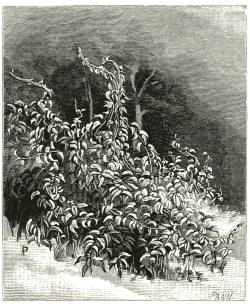
Climbing shrub (Celastrus), isolated on the grass; way of growing woody Climbers away from walls or other supports.
Mr. Hovey, in a letter from Boston, Mass., wrote as follows, on certain interesting aspects of tree drapery:— Some ten or fifteen years ago we had occasion to plant three or four rows of popular climbers in nursery rows, about 100 feet long; these consisted of the Virginian creeper, the Moonseed (Menispermum), Periploca græca, and Celastrus scandens; subsequently, it happened accidentally that four rows of rather large Tartarian (so–called) Arbor–vitæs were planted on one side, and about the same number of rows of Smoke trees, Philadelphus, and Cornus florida, on the other. For three or four years many of these climbers were taken up annually until rather too old to remove, and year by year the Arbor–vitæs and shrubs were thinned out until what were too large to safely transplant remained. But the land was not wanted then, and the few scattered trees and climbers grew on while cultivation was partially neglected, a large specimen being occasionally taken out until the climbers had fairly taken possession of the trees, and are now too beautiful to disturb. It forms the most unique specimen of tree drapery I have ever seen. Some of the Arbor–vitæs are entirely overrun with the Moonseed (Menispermum), whose large, slightly–scalloped leaves overlap[48] one another from the ground to the top like slates on a roof. Over others, the gloomy leaves of the Periploca scramble, and also the Celastrus, and on still others the deep green leaves of the Ampelopsis completely festoon the tree; of some trees all four and other climbers have taken possession; and from among the tops of the Sumach the feathery tendrils of the Ampelopsis, and, just now, its deep blue berries hold full sway. And these are not all. The Apios tuberosa is indigenous, and springs up everywhere as soon as our land is neglected. This has also overrun several trees, and coils up and wreaths each outstretching branch with its little bunches of fragrant brownish coloured flowers. It is the Arbor–vitæs which give the peculiar beauty of this description of tree drapery. On the deciduous trees the new growth lengthens rapidly, and the branches soon get far apart; but with Arbor–vitæs, which always present a round compact head, the effect is entirely different; they are covered so densely that it is impossible, in some instances, to say what the tree is that supports the climbers. One Hemlock Spruce (Abies canadensis) has every branch loaded with the Apios and profuse with blossoms; but this one sees happen with other trees. The Smoke tree looks interesting just now, while its flowers are fresh, but soon they will fade, and the dry tops will be a disadvantage; but the Arbor–vitæ will remain clothed with the foliage, flowers, and berries too, of the Celastrus until the autumn frosts have shorn them of their beauty, and no falling leaves are scattered around. The Arbor–vitæ is the tree I would recommend when it is desirable to produce such effects as I have described. When such strong–growing climbers as Begonias and Wistarias take possession of a shrub they generally injure it; but the very slender stems of Menispermum and Apios die entirely to the ground after the first sharp frost, and the slender stems of the others do not appear to arrest the growth of the Arbor–vitæs, which are restored when the climbers are down, and, after full eight months’ rest, are again ready to aid in sustaining their more dependent companions. The Honeysuckle, the Clematis, and similar plants might, no doubt, be added to the list, and give more variety, as well as fragrance and beauty, but I have only detailed the effects of what has been done, leaving what might be effected for some future trial.ill48
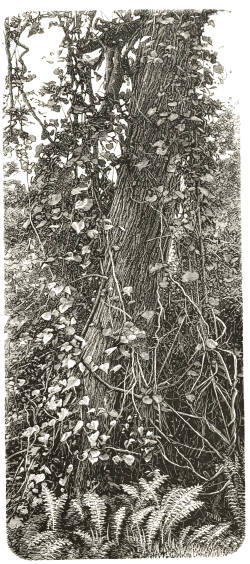
A Liane in the North. Aristolochia and Deciduous Cypress.
But the noblest kind of climbers forming drapery for trees are not so often seen as some of the general favourites mentioned above. A neglected group are the wild Vines, plants[49] of the highest beauty, and which, if allowed to spring through the tall trees, which they would quickly do, would soon charm by their bold grace. Some of them are fine in colour of foliage in autumn. With these might be associated, though not so fine in form, certain free–growing species of Ampelopsis, grown in some nurseries. The Wistaria is also well worth growing on trees, in districts where it flowers freely[50] away from walls. In visiting the garden of MM. Van Eden, at Haarlem, I was surprised to see a Liane, in the shape of the well–known Aristolochia or Dutchman’s Pipe, which had clambered high into a fine old deciduous Cypress. Being much interested in this long–established companionship, I was able to procure, through the kindness of Messrs. Van Eden, photographs of the tree and its Liane, from which this illustration was engraved. When I saw it early in spring the leaves had not appeared on either the tree or its companion, and the effect of the old rope–like stems was very picturesque. The Aristolochia ascends to a height of 35 ft. 6 in. on the tree.
The tree was a superb specimen, and was not in the least injured by the growth of the climber. What a beautiful effect a graceful flowering climber would afford in a similar case! Imagine one of the white–flowered Clematis (which may be seen as many as over forty feet in height under suitable conditions) garlanding such a tree, or any tree, with wreaths of fragrant blossoms. Strange and lovely aspects of vegetation may be created in our pleasure–grounds by the judicious use of these climbers, varying according to the trees and their position, and also as to their being evergreen or summer–leafing. Even where one might fear to injure a valuable tree by a vigorous climber, trees may easily be found of little value, and much may be done even with the old or dead trees.
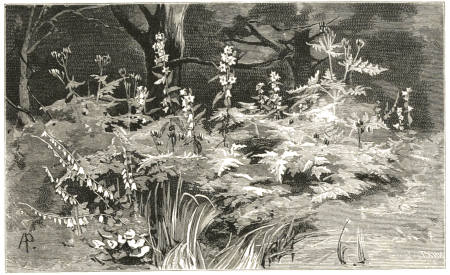
A beautiful accident.—A colony of Myrrhis odorata, established in shrubbery, with white Harebells here and there. (See p. 60.)
CHAPTER VIII.
THE COMMON SHRUBBERY, WOODS AND WOODLAND DRIVES.
It must not be thought that the wild garden can only be formed in places where there is some extent of rough pleasure–ground. Excellent results may be obtained from the system in comparatively small gardens, on the fringes of shrubberies and marginal plantations, open spaces between shrubs, the surface of beds of Rhododendrons, where we may have plant–beauty instead of garden–graveyards. I call garden–graveyards the dug shrubbery borders which one sees in nearly all gardens, public or private. Every shrubbery and plantation surface that is so needlessly and relentlessly dug over by the gardener every winter, may be embellished in the way I propose, as well as wild places. The custom of digging shrubbery borders prevails now in every garden, and there is[52] in the whole course of gardening no worse or more profitless custom. When winter is once come, almost every gardener, although animated with the best intentions, simply prepares to make war upon the roots of everything in his shrubbery border. The generally–accepted practice is to trim, and often to mutilate the shrubs, and to dig all over the surface that must be full of feeding roots. Delicate half–rooted shrubs are disturbed; herbaceous plants are destroyed; bulbs are displaced and injured; the roots as well as the tops of shrubs are mutilated; and a sparse depopulated aspect is given to the margins, while the only “improvement” that is effected by the process is the annual darkening of the surface by the upturned earth.
Illustrations of these bad practices occur by miles in our London parks in winter. Walk through any of them at that season, and observe the borders around masses of shrubs, choice and otherwise. Instead of finding the earth covered, or nearly covered, with vegetation close to the margin, and each individual plant developed into something like a fair specimen of its kind, we find a spread of recently–dug ground, and the plants upon it with an air of having recently suffered from a whirlwind, or some calamity that necessitated the removal of mutilated branches. Rough–pruners precede the diggers, and bravely trim in the shrubs for them, so that nothing may be in the way; and then come the diggers, plunging their spades deeply about plants, shrubs, or trees. The first shower that occurs after this digging exposes a whole network of torn–up roots. There is no relief to the spectacle; the same thing occurs everywhere—in botanic gardens as well as in our large West–end parks; and year after year is the process repeated.
While such is the case, it will be impossible to have an agreeable or interesting margin to a shrubbery or plantation. What secrets one might have in the central hidden portions of these now dug and bare shrubberies—in the half–shady spots where little colonies of rare exotic wildlings might have their first introduction to our wild garden! Of course all the labour required to produce this miserable result of dug borders is worse than thrown away, as the shrubberies would do better if let alone, and by utilising the power thus wasted, we might highly beautify the positions that are now so ugly.
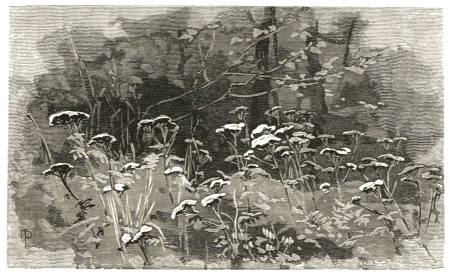
Large White Achilleas spread into wide masses under shade of trees in shrubbery.
If we resolve that no annual manuring or digging is to be permitted, nobody will grudge a thorough preparation at first. When a plantation of shrubs is quite young it is well to keep the ground open by lightly stirring it for a year or two. Then the planting should be so arranged as to defeat the digger. To graduate the vegetation from the taller subjects behind to the very margin of the grass is of much importance,[54] and this could be done best by the greater use of dwarf evergreens. Happily, there is quite enough of these to be had suitable for every soil. Light, moist, peaty, or sandy soils, where such things as the sweet–scented Daphne Cneorum would spread forth its dwarf cushions, would be somewhat more desirable than, say, a stiff clay; but for every position suitable plants might be found. Look, for example, at what we could do with the dwarf–green Iberises, Helianthemums, Aubrietias, Arabises, Alyssums, dwarf shrubs, and little conifers like the creeping Cedar (Juniperus squamata), and the Tamarix–leaved Juniper, in spreading groups and colonies. All these are green, and would spread out into dense wide cushions, covering the margin, rising but little above the grass, and helping to cut off the formal line which usually divides margin and border. Behind them we might use other shrubs, deciduous or evergreen, in endless variety; and of course the margin should be varied also as regards height.
In one spot we might have a wide–spreading tuft of the prostrate Savin pushing its graceful evergreen branchlets out over the grass; in another the dwarf little Cotoneasters might be allowed to form the front rank, relieved in their turn by pegged–down Roses; and so on without end. Herbaceous plants, that die down in winter and leave the ground bare afterwards, should not be assigned any important position near the front. Evergreen Alpine plants and shrubs, as before remarked, are perfectly suitable here; but the true herbaceous type, and the larger bulbs, like Lilies, should be in groups between spreading shrubs. By so placing them, we should not only secure a far more satisfactory general effect, but highly improve the aspect of the herbaceous plants[55] themselves. To carry out such planting properly, a little more time at first and a great deal more taste than are now employed would be required; but what a difference in the result! All that the well–covered borders would require would be an occasional weeding or thinning, and, in the case of the more select spots, a little top–dressing with fine soil. Here and there, between and amongst the plants, such things as Forget–me–nots and Violets, Snowdrops and Primroses, might be scattered about, so as to give the borders interest even at the dullest seasons; and thus we should be delivered from digging and dreariness, and see our once ugly borders alive with flowers. The chief rule should be—never show the naked earth: clothe it, and then allow the taller plants to rise in their own way through the turf or spray. Here is a little sketch of what is meant. A colony of the white Arabis carpets the ground in which strong hardy Lilies are growing; and the Lilies are pushing up their bold unfolding shoots. The latter are none the worse in winter for this light carpet of foliage over the border; and then for a long time in spring it is bedecked with white flowers. Indeed, in fairly good seasons it blooms in winter too. It would take a big[56] book to tell all the charms and merits belonging to the use of a variety of small plants to carpet the ground beneath and between those of larger growth. It need hardly be said that this argument against digging applies to two or three beds of shrubs, and places where the “shrubbery” is little larger than the dining–room, as much as to the large country seat, public park, or botanic garden.
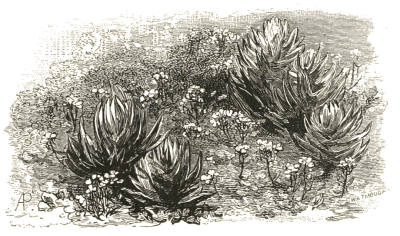
Lilies coming up through carpet of White Arabis.
There are great cultural advantages too, in leaving the whole of the leaves to nourish the ground and protect it from frost or heat. I append a note from a correspondent inquiring about what he supposes practical difficulties, and an answer to them:—
You draw a pretty picture of what a shrubbery border should be and how it should be kept in winter. There should be no digging, and the fallen leaves should be left. I fully agree, except as to the leaves. Theoretically, it seems quite right to allow the leaves to lie and decay amidst the surrounding plants, but in practice it does not answer. There are, for instance, in most gardens such things as slugs and snails. These delight in a leafy covering, and, protected from frost by the shelter, will prey upon the perennial green leafage and the starting crowns of the herbaceous plants, and do an immense amount of mischief. Then there are usually in gardens in winter, especially in hard weather, blackbirds and thrushes, which in their efforts to obtain food set all notions of tidiness at defiance. A troop of fowls would hardly turn a flower border more topsy–turvy than would a few of these birds. The first storm that came would whirl the disturbed leaves all over the place, much to the disgust of the cultivator, and the hardy plants would find that the theory of a natural dressing of leaf manure had broken down. I detest the forking of borders so common in winter. A moderate stirring of the surface first with a two or three–tined rake is good, then a dressing of soot or guano, or both, and over all a thin surfacing of old pot soil, or the rough screened produce of the rubbish heap, or, in fact, any kind of refuse soil that may offer. I think that most cultivators will agree that such a plan would answer better than the natural, but very inoperative leaf–dressing.—A.
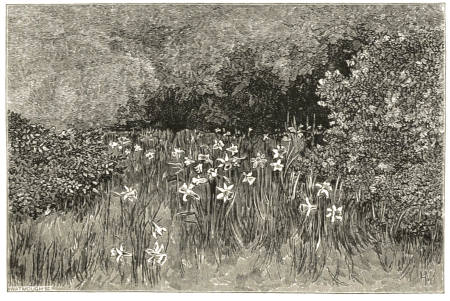
Colony of Narcissus in properly spaced shrubbery.
How do the swarming herbs of the woods and copses of the world exist in spite of the slugs? A good protection for them is hard gravel walks and paths, where they lay their eggs without danger. Against the door one may do what one likes, but not one leaf would I ever allow removed from a clump of shrubs or trees on my lawn or in my pleasure ground. I would prefer the leaves all over the place to a dug border, but I would, if need be, meet that difficulty by scattering a light dressing of soil over them. In what I should call a properly managed shrubbery or clump, with the bushes well spaced, and their branches resting on the ground, with low shrubs between, and evergreen and other herbs, there are natural impediments to the leaves rushing about in the way you suppose. This is a subject of the greatest interest and the utmost practical importance. Our annual digging[58] mutilation, scraping away of leaves, and exposing on bare sloppy borders plants that in Nature shelter each other, and are shielded from bitter frost and burning heat by layers of fallen leaves, gradually sinking into excellent light surface soil for the young roots, are ignorant and brutal practices that must be given up by all who really look into the needs of our hardy garden flora.
With reference to this point, I print this letter from an observer of what goes on in the woods of New England. Our own woods are full of lessons, and so it is in all countries. Mr. Falconer’s letter is very suggestive of the revolution in method which must be carried out in the gardens of the future:—
I go into the woods in the spring time, and find them carpeted with Dog’s–tooth Violets, Wood Anemones, blue and purple Hepaticas, Spring beauty, Trilliums, Blood–root, Star–flowers, False Solomon’s Seal, Gold Thread, trailing Arbutus, wild Ginger, and a host of other pretty little flowers, all bright and gay, arising from their bed of decaying herbage and tree leaves, and many of them are in perfection, too, before a tree has spread a leaf; and thus they glow and revel in their cosy bed, fed and sheltered by their tree friends. When their petals drop and their leaves are mature, the trees expand their leafy canopy and save the little nurslings from the torture of a scorching sun. And early as the earliest, too, the outskirts of the woods and meadows with hosts of Violets are painted blue and white, and speckled everywhere with Bluets, or little Innocents, as the children call them. Woodsias, tiny Aspleniums, and other Ferns are unfolding their fronds along the chinks among the stones; the common Polypody is reaching over blocks and boulders; and even the exposed rocks, with their rough and Lichen–bearded faces, are aglow in vernal pride. Every nook and cranny among them, and little mat of earth upon them are checkered with the flowery print of the Canada Columbine, the Virginia Saxifrage, and the glaucous Corydalis. But to the carpet. What can be prettier or more appropriate than the Partridge–berry (Mitchella repens), the Twin–flower (Linnæa borealis—does well with us), Creeping Winter Green (Gaultheria procumbens), Bearberry (Arctostaphylos Uva–Ursi), Cowberry (Vaccinium Vitis–idæa), Dwarf Cornel (Cornus canadensis), Fringed Polygala (P. paucifolia), the Common Pipsissewa (Chimaphila umbellata) with its shining deep green leaves, the Spotted Pipsissewa (C. maculata), the sombre–hued Pyrola and Galax, and that bright and easily–grown Club Moss (Lycopodium lucidulum)? Add to these such plants as Winter Aconite, Apennine Anemone, Creeping Forget–me–not, and the like, together with a few of the most suitable kinds of the host of bulbous ornamental plants which we now possess, and our shrubbery carpets may be replete with garden jewels. It is now generally conceded that shrubs thrive better in beds whose surface is undisturbed than where it is annually loosened by digging or pointing. This, coupled with a yearly top–dressing of decayed leaf–soil or light rich vegetable heap compost, is equally beneficial for the shrubs and their carpet.
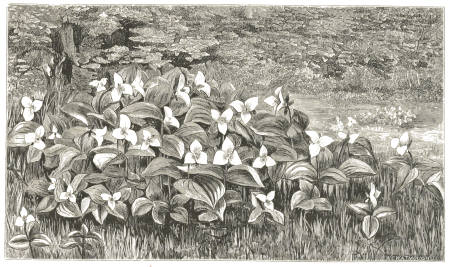
The American White Wood–Lily (Trillium grandiflorum) in Wild Garden, in wood bottom in leaf–mould.
“One day last spring, when strolling through the Medford wood, I came upon an open meadow with a high bank—cleared timber land—on one side. Adown this bank in a rough and rocky course, came a little stream of water, bordered on both sides with streaks and patches of Blood–root in its gayest state. The large and showy blossoms, clasped erect in their own leaf–vases and sparkling in the sun, while the sward and other vegetation around were yet dormant, had a cheerful influence indeed. True, near by in the hollow, the malodorous Skunk Cabbage was rank in leaf and flower, and the Indian Poke was rushing out its plaited, broadly oval leaves, and away in the streamlet a few Marsh Marigolds glittered on the water. But the Blood–root is neither an aquatic nor a bog plant, but most at home in the leaf–mould beds and linings of rich woodlands.”
“Hereabout, a little wild flower (Erythronium americanum) more commonly known as Dog’s–tooth Violet, is a charming plant, with variegated handsome leaves, and comely flowers in earliest spring. In low copses in rich deposits of vegetable[60] mould it grows around here in the utmost profusion. In one place by the side of a wood is a sort of ditch, which is filled with water in winter but dry in summer, and wherein is collected a mass of leaf–soil. Here the Erythronium runs riot, and forms the densest kind of matted sod, all bespeckled with yellow blossoms before a bush or tree has spread a leaf. Then blackberry bushes get a growing and sprawling everywhere, the trees expand their leafy shade, and Grass and weeds grow up and cover the surface of the earth. But all too late for evil, the Adder’s–tongue’s mission for a year is ended; it has blossomed, matured, and retired. The next densest mass I know of is in a low piece of cleared timber land, where, besides the profusion in the hollow, the carpet extends, thinner as it ascends, for many yards up the slope of the hill. As garden plants they are at home anywhere, underneath bushes, or in any out of–the–way corner, merely praying to be let alone. But what I desire to urge is their naturalisation in your rich woodlands, where Anemones and Primroses, Buttercups and Violets, grow up and flower together.”
I cannot better conclude this chapter than by showing one of the most interesting aspects of vegetation I have ever seen.[1] It was in an ordinary shrubbery, forming a belt round a botanic garden. In the inner parts, hidden from the walk probably from want of labour, the digging had not been carried out for some years. Some roots of the common Myrrh (Myrrhis odorata), thrown out of the garden in digging, had rooted by accident and spread into a little colony. The plant grows freely in any soil. Among the graceful tufts of Myrrh were tall white Harebells, and the effect of these, standing[61] above the elegant spreading foliage of the Myrrh in the shade of the trees, was very beautiful. Note particularly that the front of the shrubbery in which this exquisite scene was discovered was as stiff and hideous as usual in winter—raw earth, full of mutilated roots, and shrubs cut in for the convenience and according to the taste of the diggers. The beds in the botanical arrangement near were ugly beyond description.
Longleat is one of the first places in which the idea of the wild garden was practically carried out and ably by the forester, Mr. Berry. With such a fine variety of surface and soil, the place naturally offers numerous positions in which the plants of other countries as cold or colder than our own could be naturalised, or so planted that they would increase and take care of themselves in the woods. A forester’s duties and opportunities are generally such as make it extremely difficult for him to carry out such an idea. To know the plants even that are likely to succeed is, in itself, a species of knowledge which every planter does not possess; however, the idea was clearly understood and carried out well, so far as possible in the face of rabbits, which are the great destroyers of almost all flowering ground vegetation. To get the necessary quantities of subjects necessitated a little nursery in which a sufficient number could be raised of the more vigorous perennials, bulbs, and climbers. If this new idea in gardening be carried out on the old dotting principle of the herbaceous border, its great value and its charming effects cannot be realised. To do it rightly we must group and mass as Nature does. Though we may enjoy a single flower or tuft here and there, the true way is natural fringes and masses of plants, one or two species prevailing in a given spot; in that way we[62] may secure several important ends—distinct effects in different places, a variety as we walk along, and better means of meeting the wants of a plant, inasmuch as, dealing with a group, or mass, or carpet, we can best observe the result of our judgment in putting them in any soil or place. Therefore, although the quantity of vigorous hardy flowers essential for making good effects in a place of this size has not yet been planted out, some very charming effects have been obtained. Among the features that Mr. Berry is working to introduce are vigorous hardy exotic creepers on old and inferior trees, Thorn, and other bushes of little value. Many are already planted, but will be some time before they show their full beauty—among them Japanese and other Honeysuckles, Virginian Creepers, Clematis, Wistarias, and others. A part of the arboretum is more particularly devoted to this kind of decoration, and will eventually form a very wild wood and wild garden, where the Poet’s Narcissus may be found among Sweet Briers, Lilacs, and many kinds of fragrant–flowering shrubs and vigorous perennials. While carrying out the scheme of wild gardening, pure and simple, that is to say, the naturalisation of foreign hardy plants, opportunity has been taken to establish beautiful native kinds where they do not happen to be present in sufficient abundance. Thus the Lily of the Valley has been brought in quantities and planted in wide–spreading colonies along the drives, and so have the Meadow Saffron and the Snowflakes and Daffodils. To group and scatter these in a natural and easy way has required considerable care, the tendency of the men being invariably, and almost in spite of themselves, to plant in stiff and set or too regular masses.
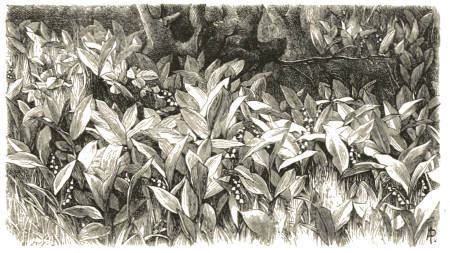
The Lily of the Valley in a copse.
Few things are more delightful to anybody who cares about hardy plants than naturalising the Lily of the Valley in pleasant spots about a country house. It is in every garden, of course, and very often so crowded and so starved that it seldom flowers well. A bare garden border is not so suitable for it as that in which it may be found in a thin wood, or in little openings in a copse, where it enjoys enough light, and gets shelter too. Frequently the fresh wood soil would be more welcome to it than the worn–out soil in a garden; also by planting it in various positions and soils, we may secure an important difference as regards blooming. In a cool woody place it would bloom ten days later than in an exposed warm garden border, and this difference could be increased by carefully selecting the position. Apart altogether from the wild garden and its charms, this difference in the time of blooming of the Lily of the Valley would be a great advantage to all who have to provide cut flowers, inasmuch as it would give them late bloom in plenty without trouble. However, giving reasons for the naturalisation of the Lily of the Valley is surely unnecessary. The only surprising[64] thing is that it has not been done to a large extent already, because it is so very easy and so very delightful. Recently a good many different varieties of Lily of the Valley—nearly as many as twenty—have been collected, and are beginning to be cultivated by some of our growers of herbaceous plants. The difference in these is not owing to soil or situation. When grown in the same place they manifest differences in length of spike and size of foliage; and also in time of blooming. In some the spike is short, and in others nearly one foot long. This important fact should, of course, be noted by any who would, in places where the Lily of the Valley does not grow wild, interest themselves in establishing it.
There are advantages in wood–culture for many hardy plants—the shelter, shade, and soil affording for some things conditions more suitable than our gardens. The warmth of the wood, too, is an advantage, the fallen leaves helping to protect the plants in all ways. In a hot country plants that love cool places could be grown in a wood where they would perish if exposed. Mr. G. F. Wilson has made himself a remarkably interesting and successful wild garden in a wood, from which he sent me in the autumn of last year (1880) a flowering stem of the American Swamp Lily (L. superbum) eleven feet high. No such result has ever been seen in any garden or border of the ordinary type. These Lilies of his grow in a woody bottom where rich dark soil has gathered, and where there is shelter and shade.
Placing every plant in one border with the same conditions as to soil and exposure was a great mistake. A great many beautiful plants haunt the woods, and we cannot change their nature easily. Even if we should grow them in open[65] places their bloom will not be so enduring as in the wood. A curious instance of the advantage of planting in a wood is at Bodorgan in Anglesey, where a much later bloom was gathered off a colony of the popular Hoteia japonica, owing to planting it in a cool wood. A little woodland planting may indeed be worth doing for the sake of a prolonged or later bloom, even from plants that thrive in sunny places.
The Orchard Wild Garden.
Although three years have elapsed since the illustrations of this book were commenced, I regret to issue it without a satisfactory one showing the beauty which may be obtained in the orchard from flowers in the grass or fences around. In our orchard counties—pity it is that all our counties are not worthy of the name within the possibilities of their position and climate—one may now and then see a cloud of Daffodils or a tuft of Summer Snowflake, enough to suggest what happy places they would be for many bulbous flowers in the grass.
A Wild Orchard.
A correspondent of the “Garden” writes:—
After reading in the “Garden” of November 16, about the Bullace there named, and the Cranberries, the idea struck me of adding unto our Orchard in Sussex “a wild Orchard,” with fruit trees such as follows, viz.—Quince, Medlar, Mulberry, Bullace, Crab, Pyrus Maulei, Barberries, Blackberries (the large kinds for preserving), Filberts, and in a suitable place, Cranberries. All these, besides the interest of cultivating them, would yield fruit for preserving, etc. For instance, we have old–fashioned receipts for making an excellent Bullace cheese, Crab jelly, Quince jelly, etc. I venture to trouble you with a view to asking if[66] you can suggest any other similar fruit–bearing trees or shrubs, as we should like to carry out our idea well. Our house is in Sussex, between Midhurst and Haslemere.—C. S. R.
[An excellent idea! There are many fruits which could be grown this way that people do not usually give space to, and this applies to the varieties of cultivated fruits, as well as species that are never cultivated. The natural order to which most of our fruit trees belong contains many other species, not without merit as fruits, scattered throughout the temperate regions of the northern world. These trees and shrubs happen also to be most beautiful of flowering trees and shrubs in spring, and are well worthy of culture on that account alone. In Japan, North America, and even the continent of Europe, one frequently sees fruits that are never seen in our gardens; such fruits will be quite at home in the wild orchard. For the sake of growing one family of fruiting bushes alone—the fruiting brambles of America and other countries—a considerable piece of ground might be profitably devoted. Even amongst the English wild Blackberries there is considerable variety and a good deal of unrecognised merit. Such plants can only be grown fairly where there is considerable space. If so much beauty and interest, and even good fruit, may be found in one neglected family, it suggests how interesting the subject is when considered in relation to the great number of our hardy fruit trees and shrubs. A good feature of such a garden would be plantations of such Apples and Pears as are most remarkable for the beauty of their flowers and fruit, some being much more striking in that respect than others.]
CHAPTER IX.
THE BROOK–SIDE, WATER–SIDE, AND BOG GARDENS.
ill67
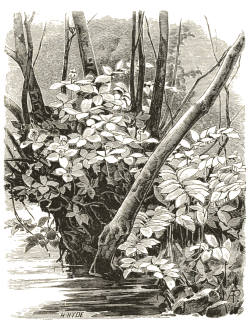
Solomon’s Seal and Herb Paris, in copse by streamlet.
Nearly all landscape gardeners seem to have put a higher value on the lake or fish–pond than on the brook as an ornament to the garden; but, while we allow that many places are enhanced in beauty and dignity, by a broad expanse of water, many pictures might be formed by taking advantage of a brook as it meanders through woody glade or meadow. No such beauty is afforded by a pond or lake, which gives us water in repose—imprisoned[68] water, in fact; and although we obtain breadth by confining water, still, in many cases, we prefer the brook, or water in motion, as it ripples between mossy rocks or flower–fringed banks. The brook–margin, too, offers opportunities to lovers of hardy flowers which few other situations can rival. Hitherto we have only used in and near such places aquatic or bog plants, and of these usually a very meagre selection; but the improvement of the brook–side will be most readily effected by planting the banks with hardy flowers, making it a wild garden, in fact. A great number of our finest herbaceous plants, from Irises to Globe–flowers, thrive best in the moist soil found in such positions; numbers of hardy flowers, also, that do not in nature prefer such soil, would exist in perfect health in it. The wild garden illustrated by the water–side will give us some of the most charming garden pictures. Land plants would have this advantage over water ones, that we could fix their position, whereas water plants are apt to spread everywhere, and sometimes one kind exterminates the rest; therefore it might, in many cases, be better not to encourage the water or water–side vegetation, but to form little colonies of hardy flowers along the banks. The plants, of course, should be such as would grow freely among Grass and take care of themselves. If different types of vegetation were encouraged on each side of the water, the effect would be all the better. The common way of repeating a favourite plant at intervals would spoil all: groups of free hardy things, different in each place as one passed, would be best; Day Lilies; Phloxes, which love moisture; Irises, mainly the beardless kinds, which love wet places, but all the fine Germanica forms will do; Gunnera; Aster; American[69] swamp Lilies in peaty or boggy soil; the deep rose–coloured variety of the Loosestrife; Golden Rods; the taller and stouter Bell–flowers (Campanula); the Spider Wort (Tradescantia virginica), of which there are a good many forms, differing in colour; the Broad–leaved Saxifrages; the Compass plants (Silphium); Everlasting Peas; Monkshood; the Goats Rues (Galega); Baptisia; the free–flowering Yuccas; the hardiest flame–flowers (Tritoma); the stouter kinds of Yarrow (Achillea); the common perennial Lupin—these are some of many types of hardy flowers which would grow freely near the water–side[70] apart wholly from the plants that naturally frequent such places or which are usually placed there. With these hardy plants too, a variety of the nobler hardy ferns would thrive, as the Struthiopteris; the finer types of the Umbellate order (Ferula and others) would also come in well here. We will now consider the plants that naturally belong to such situations so to say.
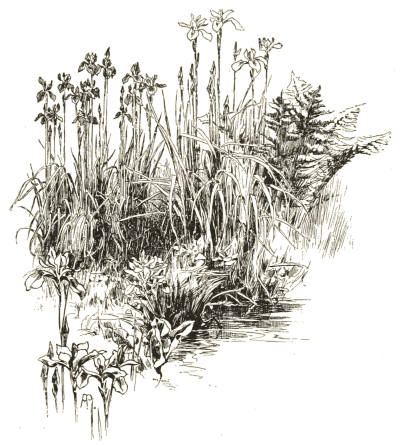
Colony of hardy exotic Flowers, naturalised by brook–side.
Water–plants of northern and temperate regions, associated with those of our own country, add much beauty to a garden if well selected and well grown. A great deal of variety may be added to the margins, and here and there to the surface, of ornamental water, by the use of a good collection of hardy aquatics arranged with taste; but this has not yet been fairly attempted. Usually we see the same monotonous vegetation all round the margin if the soil be rich; in some cases, where the bottom is of gravel, there is little or no vegetation, but an unbroken ugly line of washed earth between wind and water. In others, water–plants accumulate till they are only an eyesore—not submerged plants like Anacharis, but such as the Water Lilies when matted together. A well–developed plant or group of plants of the queenly Water Lily, with its large leaves and noble flowers, is an object not surpassed by any other in our gardens; but when it increases and runs over the whole of a piece of water—thickening together and being in consequence weakened—and water–fowl cannot make their way through it, then even this plant loses its charms. No garden water, however, should be without a few fine plants or groups of the Water Lily. Where the bottom does not allow of the free development of the plant, earth might be accumulated in the spot where it was desired to encourage the growth of the Nymphæa. Thus arranged it would not spread too much. But it is not difficult to prevent the plant from spreading; indeed I have known isolated plants, and groups of it, remain of almost the same size for years. The Yellow Water Lily, Nuphar lutea, though not so beautiful as the preceding, is well worthy of a place; and also the little N. pumila, a variety or sub–species found in the lakes of the north of Scotland.
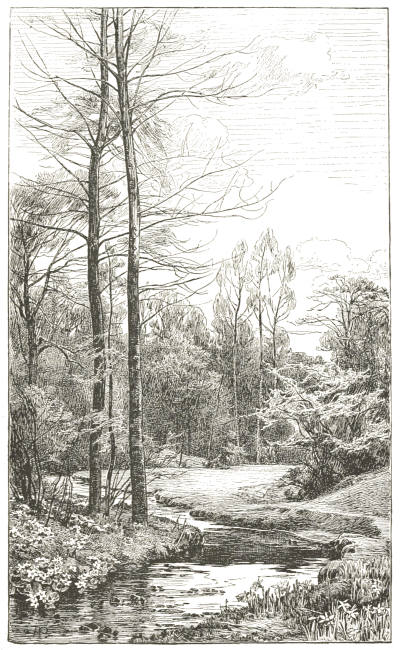
Valley in Somersetshire, with Narcissi, Marsh Marigolds, and Primroses.
Then there is the fine and large N. advena, a native of America, which pushes its leaves boldly above the water, and is very vigorous in habit. It is very plentiful in the Manchester Botanic Garden, and will be found to some extent in most gardens of the same kind. The American White Water Lily (Nymphæa odorata) is a noble species, which would prove quite hardy in Britain. It is a pity this noble aquatic plant is not more frequently seen, as it is quite as fine as our own Water Lily. Rose–coloured varieties are spoken of, but are not yet in cultivation here.
One of the prettiest effects I have ever observed was afforded by a sheet of Villarsia nymphæoides belting round the margin of a lake near a woody recess, and before it, more towards the deep water, a group of Water Lilies. The Villarsia is a charming little water–plant, with its Nymphæa–like leaves and numerous golden–yellow flowers, which furnish a beautiful effect on fine days, under a bright sun. It is not very commonly distributed as a native plant, though, where found, generally very plentiful.
Not rare—growing, in fact, in nearly all districts of Britain—but beautiful and singular, is the Buckbean or[72] Marsh Trefoil (Menyanthes trifoliata), with its flowers deeply fringed on the inside with white filaments, and the round unopened buds blushing on the top with a rosy red like that of an Apple–blossom. It will grow in a bog or any moist place, or by the margin of any water. For grace, no water–plant can well surpass Equisetum Telmateia, which, in deep soil, in shady and sheltered places near water, often grows several feet high, the long, close–set, slender branches depending from each whorl in a singularly graceful manner. It will grow on the margins of lakes and streams, especially among water–side bushes, or in boggy spots in the shade.
For a bold and picturesque plant on the margin of water, nothing equals the great Water Dock (Rumex Hydrolapathum), which is rather generally dispersed over the British Isles; it has leaves quite sub–tropical in aspect and size, becoming of a lurid red in the autumn. It forms a grand mass of foliage on rich muddy banks, and, unlike many water–plants, has the good quality of not spreading too much. The Cat’s–tail (Typha) must not be omitted, but it should not be allowed too much liberty. The narrow–leaved one (T. angustifolia) is more graceful than the common one (T. latifolia). Carex pendula is excellent for the margins of water, its elegant drooping spikes being quite distinct in their way. It is rather common in England, more so than Carex pseudocyperus, which grows well in a foot or two of water or on the margin of a muddy pond. Carex paniculata forms a strong and thick stem, sometimes 3 ft. or 4 ft. high, somewhat like a tree Fern, and with luxuriant masses of drooping leaves, and on that account is transferred to moist places in gardens, and cultivated by some, though generally these large specimens[73] are difficult to remove and soon perish. Scirpus lacustris (the Bulrush) is too distinct a plant to be omitted, as its stems, sometimes attaining a height of more than 7 ft. and even 8 ft., look very imposing; and Cyperus longus is also a desirable plant, reminding one of the aspect of the Papyrus when in flower. It is found in some of the southern counties of England. Poa aquatica might also be used. Cladium Mariscus is another distinct and rather scarce British aquatic which is worth a place.ill73
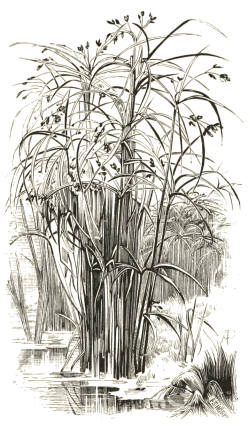
Cyperus Longus.
If one chose to enumerate the plants that grow in British and European waters, a very long list might be made, but those which possess no distinct character or no beauty of flower would be useless, for it is only by a judicious selection of the very best kinds that gardening of this description can give satisfaction; therefore, omitting a host of inconspicuous water–weeds, we will endeavour to indicate others of real worth for our present purpose.
Those who have seen the flowering Rush (Butomus umbellatus) in blossom, are not likely to omit it from a collection of water–plants, as it is conspicuous and distinct. It is a native of the greater part of Europe and Russian Asia, and is dispersed[74] over the central and southern parts of England and Ireland. Plant it not far from the margin, and it likes rich muddy soil. The common Arrow Head (Sagittaria), very frequent in England and Ireland, but not in Scotland, might be associated with this; but there is a very much finer double exotic kind, which is really a handsome plant, its flowers white, and resembling, but larger than, those of the old white Double Rocket. This used to be grown in abundance in the pleasure gardens at Rye House, Broxbourne, where it filled a sort of oblong basin, or wide ditch, and was very handsome in flower. It forms large egg–shaped tubers, or rather receptacles of farina, and in searching for these, ducks destroyed the plants occasionally. Calla palustris is a beautiful bog–plant, and I know nothing that produces a more pleasing effect over rich, soft, boggy ground. It will also grow by the side of water. Calla æthiopica, the well–known and beautiful Lily of the Nile, is hardy enough in some places if planted rather deep, and in nearly all it may be placed out for the summer; but, except in quiet waters, in the south of England and Ireland, it will not thrive. However, as it is a plant so generally cultivated, it may be tried without loss in favourable positions. Pontederia cordata is a stout, firm–rooting, and perfectly hardy water–herb, with erect and distinct habit, and blue flowers, not difficult to obtain from botanic garden or nursery. The Sweet–flag will be associated with the Water Iris (I. Pseudacorus), and a number of exotic Irises will thrive in wet ground, i.e. I. sibirica, ochreleuca, graminea, and many others. Aponogeton distachyon is a native of the Cape of Good Hope, a singularly pretty plant, which is hardy enough for our climate, and, from its sweetness and curious beauty, a most[75] desirable plant to cultivate. It frequently succeeds in water not choked by weeds or foulness, and wherever there are springs that tend to keep the water a little warmer than usual it seems to thrive in any part of the country. The Water Ranunculuses, which sheet over our pools in spring and early summer with such silvery beauty, are not worth an attempt at cultivation, so rambling are they; and the same applies to not a few other things of interest. Orontium aquaticum is a scarce and handsome aquatic for a choice collection, and as beautiful as any is the Water Violet (Hottonia palustris). It occurs most frequently in the eastern and central districts of England and Ireland. The best example of it that I have seen was on an expanse of soft mud near Lea Bridge, in Essex, where it covered the surface with a sheet of dark fresh green, and must have looked better in that position than when in water, though doubtless the place was occasionally flooded. A suitable companion for the Marsh Marigold (Caltha) and its varieties is the very large and showy Ranunculus Lingua, which grows in rich ground to a height of three feet or more.
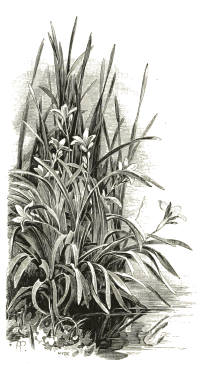
Day Lily by margin of water.
If with this water–garden we combine the wild garden of land plants—herbaceous, trailers, etc.—some of the loveliest effects possible in gardens will be produced. The margins of lakes and streams are happily not upturned by the spade in winter; and hereabouts, just away from the water–line, almost any vigorous and really hardy flower of the thousands now in our gardens may be grown and will afterwards take care of itself. The Globe–flowers alone would form beautiful effects in such positions, and would endure as long as the Grass. Near the various Irises that love the water–side might be planted those that thrive in moist ground, and they are many, including the most beautiful kinds. Among recently introduced plants the singular Californian Saxifraga peltata is likely to prove a noble one for the water–side, its natural habitat being beside mountain watercourses, dry in the autumn when it is at rest; both flowers and foliage are effective, and the growth very vigorous when in moist ground. It would require a very long list to enumerate all the plants that would grow near the margins of water, and apart from the aquatics proper; but enough has been said to prove that, given a strip of ground beside a stream or lake, a garden of[77] the most delightful kind could be formed. The juxtaposition of plants inhabiting different situations—water–plants, water–side plants, and land–plants thriving in moist ground—would prevent what would, in many cases, be so undesirable—a general admixture of the whole. Two distinct classes of effects could be obtained, the beauty of the flowers seen close at hand, and that of the more conspicuous kinds in the distance, or from the other side of the water of a stream or lakelet.
An interesting point in favour of the wild garden is the succession of effects which it may afford, and which are suggested by the illustrations on the next pages, both showing a succession of life on the same spot of ground. In gardens in early summer at present the whole of the portion devoted to flower–gardening is dug up raw as a ploughed field, just when the earth is naturally most thickly strewn with flowers. A very little consideration and observation will suffice to make it clear that a succession of effects may be secured without this violent disfigurement of our gardens in the fairest days of early summer. These are not the days for digging or planting either, and the system that necessitates them is pernicious in its effects on our gardens.
It is equally an enemy of all peace or rest for the gardener, who, having trenched, dug, enriched, planted, and sown, through the autumn, winter, and spring, might certainly begin to look for the fruits and flowers of his labour, when he has to face the most trying effort of all—the planting of the flower–garden in May and June with a host of flowers too tender to be committed to the earth at an earlier season.
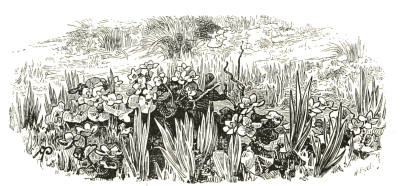
Marsh Marigold and Iris in early spring. (See p. 77.)
The bog–garden is a home for the numerous children of the wild that will not thrive on our harsh, bare, and dry garden borders, but must be cushioned on moss, and associated with their own relatives in moist peat soil. Many beautiful plants, like the Wind Gentian and Creeping Harebell, grow on our own bogs and marshes, much as these are now encroached upon. But even those acquainted with the beauty of the plants of our own bogs have, as a rule, but a feeble notion of the multitude of charming plants, natives of northern and temperate countries, whose home is the open marsh or boggy wood. In our own country, we have been so long encroaching upon the bogs and wastes that some of us come to regard them as exceptional tracts all over the world. But when one travels in new countries in northern climes, one soon learns what a vast extent of the world’s surface was at one time covered with bogs. In North America day after day, even by the margins of the railroads, one sees the vivid blooms of the Cardinal–flower springing erect from the wet peaty hollows. Far under the shady woods stretch the black bog–pools, the ground between being so shaky that you move a few steps with difficulty. One wonders how the trees exist with their roots in such a bath. And where the forest vegetation disappears the American Pitcher–plant (Sarracenia),[79] Golden Club (Orontium), Water Arum (Calla palustris), and a host of other handsome and interesting bog–plants cover the ground for hundreds of acres, with perhaps an occasional slender bush of Laurel Magnolia (Magnolia glauca) among them. In some parts of Canada, where the painfully long and straight roads are often made through woody swamps, and where the few scattered and poor habitations offer little to cheer the traveller, he will, if a lover of plants, find conservatories of beauty in the ditches and pools of black water beside the road, fringed with the sweet–scented Buttonbush, with a profusion of stately ferns, and often filled with masses of the pretty Sagittarias.
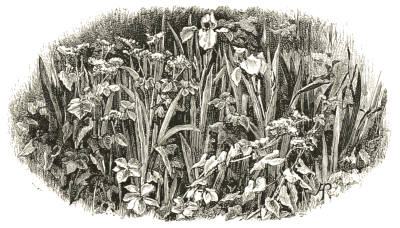
The same spot as in opposite sketch, with aftergrowth of Iris, Meadow Sweet, and Bindweed. (See p. 77.)
Southwards and seawards, the bog–flowers become tropical in size and brilliancy, as in the splendid kinds of herbaceous Hibiscus, while far north, and west and south along the mountains, the beautiful and showy Mocassin–flower (Cypripedium spectabile) grows the queen of the peat bog. Then in California, all along the Sierras, there are a number of delicate little annual plants growing in small mountain bogs[80] long after the plains have become quite parched, and annual vegetation has quite disappeared from them. But who shall record the beauty and interest of the flowers of the wide–spreading marsh–lands of this globe of ours, from those of the vast wet woods of America, dark and brown, and hidden from the sunbeams, to those of the breezy uplands of the high Alps, far above the woods, where the little bogs teem with Nature’s most brilliant flowers, joyous in the sun? No one worthily; for many mountain–swamp regions are as yet as little known to us as those of the Himalaya, with their giant Primroses and many strange and lovely flowers. One thing, however, we may gather from our small experiences—that many plants commonly termed “alpine,” and found on high mountains, are true bog–plants. This must be clear to anyone who has seen our pretty Bird’s–eye Primrose in the wet mountain–side bogs of Westmoreland, or the Bavarian Gentian in the spongy soil by alpine rivulets, or the Gentianella (Gentiana acaulis) in the snow ooze.
Bogs are neither found or desired in or near our gardens now–a–days, but, wherever they are, there are many handsome flowers from other countries that will thrive in them as freely as in their native wastes.
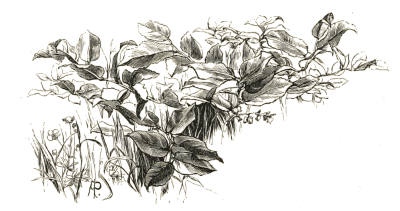
Partridge Berry (Gualtheria).
CHAPTER X.
ROSES FOR THE WILD GARDEN, AND FOR HEDGEROWS, FENCES, AND GROUPS.
The wild Roses of the world, had we no other plants, would alone make beautiful wild gardens. The unequalled grace of the Wild Rose is as remarkable as the beauty of bloom for which the Rose is grown in gardens. The culture is mostly of a kind which tends to conceal or suppress the grace of shoot and foliage of the Rose. Therefore the wild garden may do good work in bringing before the many who love gardens, but have fewer chances of seeing the Roses in their native haunts, the native grace of the well–loved Rose, which even in its obesity, and trained into the form of a mop, still charms us. The Rev. H. N. Ellacombe writes:—
I have here a very large and thick Box bush, in the centre of which there has been for many years an Ayrshire Rose. The long branches covered with flowers, and resting on the deep green cushion, have a very beautiful effect. Other Roses may be used in the same way. The Musk Rose of Shakespeare and Bacon would be particularly well suited for this, and would climb up to a great height. Rosa scandens or sempervirens, Rosa multiflora, and perhaps some others, might be grown in the same way; and it would be worth while to experiment with other garden forms, such as Aimée Vibert, purple Boursault, etc. If grown against a tree of thin foliage, such as a[82] Robinia, they would grow quicker and flower sooner; but this is not necessary, for even if grown near a thick–foliaged tree they will soon bring their branches to the outside for the light. But besides climbing Roses, there is another way in which Roses may be combined with trees to great advantage, viz. by planting some of the taller–growing bushes in rough grassy places. These would grow from 6 feet to 10 feet high, and would flower well in such a position. For such a purpose the old Dutch Apple Rose (Rosa villosa var. pomifera) would be very suitable, and so would R. cinnamomea, R. fraxinifolia, R. gallica, R. rubifolia, and the common monthly China. And if growers would rear the perpetual and other Roses by autumnal cuttings instead of by budding, they might have hundreds and thousands of fine Roses which would do well planted in the woods and plantations.
Another correspondent, Mr. Greenwood Pim, writes referring to the preceding note:—
I have two large exotic Hawthorns—round–headed standards, growing close together, so that their edges touch, forming, as it were, two gentle hills with a valley between, and sloping down to within about 6 ft. of the lawn. Of these one is Cratægus Crus–galli; the other C. tanacetifolia. Behind, and partly through these, climbs a very old Noisette Rose—all that now remains of an arched trellis—producing a vast number of bunches of white flowers, six or eight together, and about 1½ in. or 2 in. across. The old gnarled stem of the Rose is scarcely noticeable amongst those of the Thorns till it reaches the top of them, whence it descends between the trees in a regular torrent of blossom, in addition to occupying the topmost boughs of the Cockspur Thorn. The general effect is almost that of a large patch of snow between two bright green hills—a combination very common in the higher districts of Switzerland. A smaller plant of the same Rose has recently been trained up a large Arbor–vitæ which, from moving, has lost its lower branches for some 4 ft. or 5 ft., and has its stem clothed with Ivy. It is now festooned with snowy flowers hanging down from and against the dark green of the Arbor–vitæ and Ivy, forming a charming contrast. It seems a great pity that we do not oftener thus wed one tree to another—a stout and strong to a slender and clinging one, as Virgil in the “Georgics” talks of wedding the Vine to the Elm, as is, I believe, done to this day in Italy.ill83
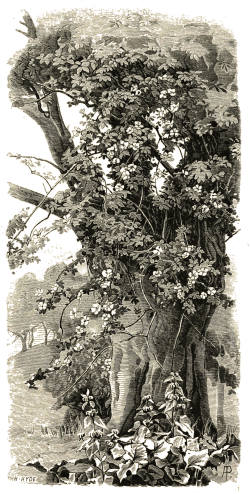
Wild Rose growing on a Pollard Ash in Orchardleigh Park, Somerset.
“We have,” says a correspondent, “a pretty extensive collection of Roses, but one of the most attractive specimens on the place is an old double white Ayrshire Rose, growing in a group of common Laurel in the shrubberies. We cannot tell how old the plant may be, but it has probably been in its present situation for thirty years, struggling the best way it could to keep its place among[84] the tall–growing Laurels, sometimes sending out a shoot of white flowers on this side and sometimes on that side of the clump of bushes, and sometimes scrambling up to the tops of the tallest limbs and draping them with its blossoms throughout June and July. Nearly three years ago we had the Laurels headed down to within six feet of the ground, leaving the straggling limbs of the Rose which were found amongst them, and since then it has grown and thriven amazingly, and now fairly threatens to gain the mastery. We had the curiosity to measure the plant the other day, and found it rather over seventy feet in circumference. Within this space the plant forms an irregular undulating mound, nearly in all parts so densely covered with Roses that not so much as a hand’s breadth is left vacant anywhere, and the Laurel branches are quite hidden, and in fact are now dying, smothered by the Rose. A finer example of luxuriant development we never saw. The plant has been a perfect sheet of bloom for a month or more, and there are thousands of buds yet to expand, and hundreds of bunches of buds have been cut just at the opening stage—when they are neater and whiter than a Gardenia—to send away. The tree has never received the least attention or assistance with the exception of the removal of the Laurel tops before mentioned, to let the light into it. It is growing in a tolerably deep and strong dry loam, and this, together with head room, seems to be all it requires. We record this example simply to show of what the Rose is capable without much cultural assistance. No doubt, in order to produce fine individual blooms certain restricted culture is necessary; but almost any variety of Rose will make a good–sized natural bush of itself, and as for the climbing or pillar Roses, the less they are touched the better. Of course we are not alluding to the Rosery proper, but of Roses in their more natural aspect, as when planted to hide fences, cover rockeries, or as striking objects on lawns. Except against walls, and in similar situations, there is no occasion to prune climbing Roses. Left to themselves, they make by far the grandest display, and to insure this it is only necessary to provide them with a good, deep, strong soil at the beginning, and to let them have a fair amount of light on all sides. Whether planting be carried out with the object above described, or for the purpose of covering naked tree stumps or limbs, or for draping any unsightly object whatever, liberal treatment in the first instance is the main thing. A good soil makes all the difference in time and in the permanent vigour of the tree, and were we desirous of having a great Rose tree (whether it be a common Ayrshire or a Gloire de Dijon, that we expected to produce thousands of blooms in a few years), we should, if the soil were not naturally strong and deep, provide a well–drained pit and fill it with two or three good cartloads of sound loam and manure; thus treated, the result is certain, provided an unrestricted growth be permitted.”
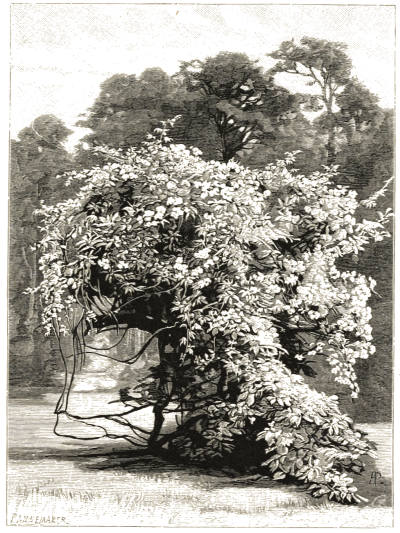
White Climbing Rose scrambling over old Catalpa Tree.
Roses on grass are a pleasant feature of the wild garden. No matter what the habit of the rose, provided it be free and hardy, and growing on its own roots, planting on the grass will suit it well. So treated, the more vigorous climbers would form thickets of flowers, and graceful vigorous shoots. They will do on level grass, and be still more picturesque on banks or slopes.
The following description, by Mr. E. Andre, of Roses in[86] the Riviera is suggestive of what we may obtain in our own climate later, by using the free kinds on their own roots, or on stocks equally hardy and not less vigorous, as in the case of the Banksian Roses mentioned below:—
On my last excursion from Marseilles to Genoa, I was greatly struck, as any one seeing them for the first time would be, with the magnificence of the Roses all along the Mediterranean shores. The Rose hedges, and the espalier Roses, especially, offer an indescribably gorgeous sight. Under the genial influence of the warm sun of Provence, from the Corniche to the extremity of the Riviera di Ponente, that is as far as the Gulf of Genoa, and protected to the north by the mountains, which gradually slope down to the sea–coast, Roses attain the size of Pæonies, and develop a depth and brilliancy of colour and fragrance of unusual intensity. But this is in part due to another cause, or rather two other causes, which lead to the same result, the main point being the choice of suitable subjects for stocks to graft upon. These stocks are, Rosa Banksiæ and Rosa indica major. The Banksian Rose presents three varieties, namely, White Banksian, producing a profusion of small white flowers, scarcely so large as those of the double–flowered Cherry, and of a most delicious fragrance; Yellow Banksian, with still larger clusters of small nankeen–yellow scentless flowers; Chinese Thorny Banksian, flowers less numerous and about three times as large as in the two preceding, and of the most grateful odour. These three forms attain an unsurpassable vigour in this region. In two years one plant will cover an immense wall, the gable of a house, or climb to the top of a tall tree, from which its branches hang like flowery cascades, embalming the air around with a rich perfume during the months of April and May. Now, if these be taken for stocks upon which to bud some of the choicer Teas, Noisettes, and Bourbons, the growth of the latter will be prodigious. The stock should be two years old, having well ripened, though still smooth, wood. In this way such varieties as Gloire de Dijon, Maréchal Niel, Lamarque, Safrano, Chromatella, Aimée Vibert, le Pactole, and all the Teas, attain such dimensions as to be no longer recognisable.
Rosa indica major is almost naturalised throughout the whole of this region. It possesses the additional claim to favour of flowering nearly all the winter, forming beautiful hedges of dark green shining foliage, from which thousands of clusters of lovely flowers rise, of a[87] tender delicate transparent pink, or almost pure white, with a brighter tinge in the centre and at the tips of the petals. This Rose is an evergreen, and makes an excellent stock for grafting or budding. It is either planted in nursery beds, where it quickly throws up a stem suitable for standards in the same way as we employ the Dog Rose, or in hedges, and left to its naturally luxuriant growth to produce its own charming flowers in rich profusion, or rows of cuttings are put in where it is intended to leave them, and subsequently budded with some of the varieties of the diverse tribes we have named.
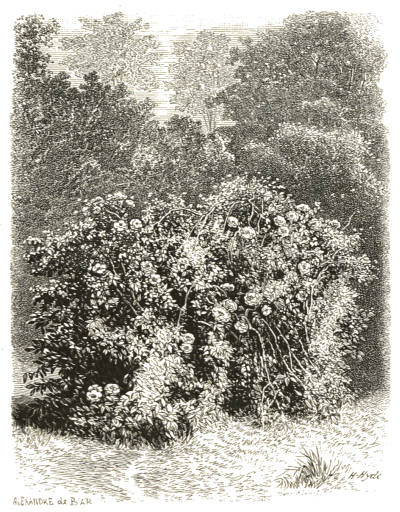
Climbing Rose isolated on grass.
CHAPTER XI.
WILD GARDENING ON WALLS OR RUINS.
ill88
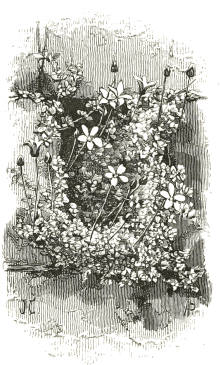
Arenaria balearica, in a hole in wall at Great Tew.
There are many hundred species of mountain and rock plants which will thrive much better on an old wall, a ruin, a sunk fence, a sloping bank of stone, with earth behind, than they do in the most carefully prepared border, and therefore their culture may be fittingly considered here, particularly, as once established in such positions they increase and take care of themselves unaided. Indeed, many an alpine plant which may have perished in its place in the garden, would thrive on any old wall near at hand, as, for example, the pretty Pyrenean Erinus, the silvery Saxifrages of the Alps, pinks like the Cheddar Pink, established on the walls[89] at Oxford, many Stonecrops and allied plants, the Aubrietia and Arabis.
A most interesting example of wall gardening is shown on the opposite page. In the gardens at Great Tew, in Oxfordshire, this exquisite little alpine plant, which usually roots over the moist surface of stones, established itself high up on a wall in a small recess, where half a brick had been displaced. The illustration tells the rest. It is suggestive, as so many things are, of the numerous plants that may be grown on walls and such unpromising surfaces.
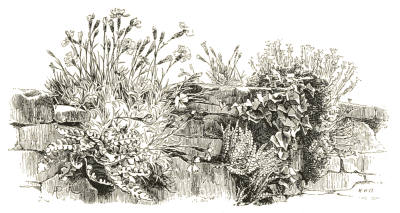
Cheddar Pink, Saxifrage, and Ferns, on cottage wall at Mells.
A mossy old wall, or an old ruin, would afford a position for many rock–plants which no specially prepared situation could rival; but even on well–preserved walls we can establish some little beauties, which year after year will abundantly repay for the slight trouble of planting or sowing them. Those who have observed how dwarf plants grow on the tops of mountains, or on elevated stony ground, must have seen in what unpromising positions many flourish in perfect health—fine tufts sometimes springing from an[90] almost imperceptible chink in an arid rock or boulder. They are often stunted and diminutive in such places, but always more long–lived than when grown vigorously upon the ground. Now, numbers of alpine plants perish if planted in the ordinary soil of our gardens, and many do so where much pains is taken to attend to their wants. This results from over–moisture at the root in winter, the plant being rendered more susceptible of injury by our moist green winters inducing it to make a lingering growth. But it is interesting and useful to know that, by placing many of these delicate plants where their roots can secure a comparatively dry and well–drained medium, they remain in perfect health. Many plants from latitudes a little farther south than our own, and from alpine regions, may find on walls, rocks, and ruins, that dwarf, ripe, sturdy growth, stony firmness of root medium, and dryness in winter, which go to form the very conditions that will grow them in a climate entirely different from their own.
In many parts of the country it may be said with truth that opportunities for this phase of gardening do not exist; but in various districts, such as the Wye and other valleys, there are miles of rock and rough wall–surface, where the scattering of a few pinches of Arabis, Aubrietia, Erinus, Acanthus, Saxifrage, Violas, Stonecrops, and Houseleeks, would give rise to a garden of rock blossoms that would need no care from the gardener. Growing such splendid alpine plants as the true Saxifraga longifolia of the Pyrenees on the straight surface of a wall is quite practicable. I have seen the rarest and largest of the silvery section grown well on the face of a dry wall: therefore there need be no doubt as to growing the more common and hardy kinds.
A few seeds of the Cheddar Pink, for example, sown in a mossy or earthy chink, or even covered with a dust of fine soil, would soon take root, living for years in a dwarf and perfectly healthful state. The seedling roots vigorously into the chinks, and gets a hold which it rarely relaxes. A list of many of the plants which will grow on walls will be found among the selections near the end of the book.
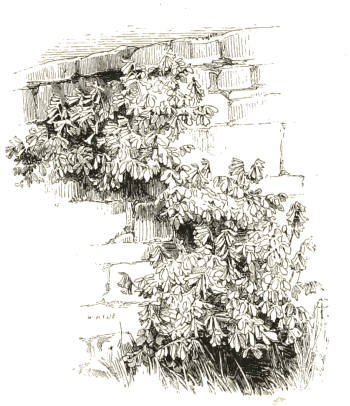
The Yellow Fumitory on wall (Corydalis lutea).
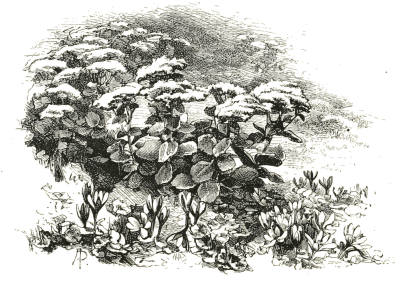
Large Japan Sedum (S. spectabile) and Autumn Crocuses in the Wild Garden.
CHAPTER XII.
SOME RESULTS.
In addition to Longleat, and other cases previously mentioned, a few of the results obtained, where the system was tried, and so far as known to me, may not be without interest. How much a wild garden intelligently and tastefully carried out may effect for a country seat is fairly well shown in a garden in Oxfordshire. Here is one of the earliest, and probably one of the largest wild gardens existing, and which, visiting it on the 27th May, I found full of novel charms. No old–fashioned garden yields its beauty so early in the year, or over a more prolonged season, than the wild garden, as there is abundant evidence here; but our impressions shall be those of the day only. It may serve to throw light on the possibilities of garden[93] embellishment in one way at a season when there is a great blank in many gardens—the time of “bedding out.” The maker of this had no favourable or inviting site with which to deal; no great variety of surface, which makes attempts in this direction so much easier and happier; no variety of soil, which might enable plants of widely different natural habitats to be grown; only a neglected plantation, with rather a poor gravelly soil and a gentle slope in one part, and little variety of surface beyond a few gravel banks thrown up long before. The garden is, for the most part, arranged on each side of a Grass drive among rather open ground, few trees on the one hand and rather shady ground on the other. The most beautiful aspect at the end of May of a singularly ungenial spring, which had not allowed the Pæonies to unfold, was that of the German Irises, with their great Orchid–like blossoms seen everywhere through the wood, clear above the Grass and other herbage, stately and noble flowers that, like the Daffodils, fear no weather, yet with rich and delicate hues that could not be surpassed by tropical flowers. If this wild garden only should teach this effective way of using the various beautiful and vigorous kinds of Iris now included in our garden flora, it would do good service. The Irises are perfectly at home in the wood and among the Grass and wild flowers. By–and–by, when they go out of flower, they will not be in the way as in a “mixed border,” tempting one to remove them, but grow and rest quietly among the grass until the varied blossoms of another year again repay the trouble of substituting these noble hardy flowers for some of the familiar weeds and wild plants that inhabit our plantations.ill94
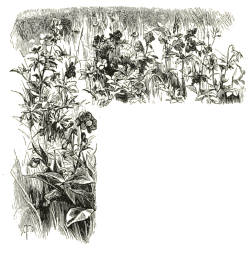
Crane’s Bill wild, in grass.
In the wild garden the fairest of our own wild flowers may be happily associated with their relatives from other countries. Here the sturdy Bell–flowered Scilla (S. campanulata) grows wild with our own Bluebell (S. nutans); the white and pink forms also of the last–named look beautiful here associated with the common well–known form. The earlier Scillas are of course past; they are admirably suited for the wild garden, especially S. bifolia, which thrives freely in woods. The Lily of the Valley did not inhabit the wood before; therefore it was pleasant to thin out some of its over–matted tufts and carry them to the wild garden, where they are now in fullest beauty. It is associated with its tall and stately relation the Solomon’s Seal. The Solomon’s Seal, which is usually effective when issuing forth from fringes of shrubberies, is here best arching high over the Woodruff and other sweet woodland flowers, among which it seems a giant, with every leaf, and stem, and blossom lines of beauty. The additional vigour and beauty shown by this plant when in rich soil well repays one for selecting suitable spots for it. The greater Celandine (Chelidonium majus) and its double form are very pretty here with their tufts of golden flowers; they grow freely and take all needful care of themselves. The same may be said of the Honesty, the common forms of Columbine, and Allium Moly, an old–fashioned plant,[95] and one of the many subjects at home in the wild garden, and which are better left out of the garden proper. The myriads of Crocus leaves dying off without the indignity of being tied into bundles as is common in gardens, the dense growth of Aconite and Snowdrop leaves, of coloured and common Primroses and Cowslips, suggest the beauty of this wild garden in spring. The yet unfolded buds on the many tufts and groups of the numerous herbaceous Pæonies, promise noble effects early in June; so do the tufts of the splendid Eastern Poppy (Papaver orientale) and the Lilies, and Sweet Williams, and Adam’s Needles, and many other subjects, that will show their blossoms above or among the summer Grass in due time. Among the best of the Borageworts here at present, are the Caucasian Comfrey (Symphytum caucasicum), an admirable wood or copse plant, and red–purple or Bohemian Comfrey (S. bohemicum), which is very handsome here. And what lovely effects from the Forget–me–nots—the wood Forget–me–not, and the Early Forget–me–not (M. dissitiflora) are here! where their soft little clouds of blue in the Grass are much prettier than tufts of the same kind surrounded by the brown earth in a prim border. Here the pushing of the delicate Grass blades through the blue mass and the indefinite way in which the fringes of the tufts mingle with the surrounding vegetation are very beautiful.
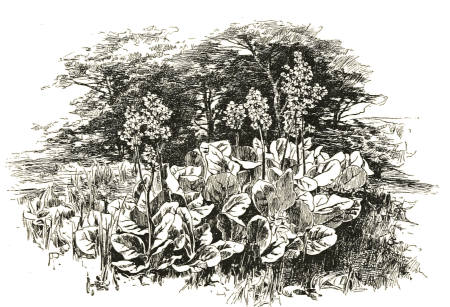
Large–leafed Saxifrage in the Wild Garden.
The only noticeable variation of surface is that of some gravel banks, which are properly covered with Stonecrops, Saxifrages, and the like, which would, as a rule, have a poor chance in the Grass. Surfaces that naturally support a very sparse and dwarf vegetation are valuable in a garden, as they permit of the culture of a series of free–growing alpine and[96] rock plants that would not be able to hold their own among Grass and ordinary weeds and wild flowers. One of the happiest features of this wild garden results from the way in which dead trees have been adorned. Once dead, some of the smaller branches are lopped off, and one or more climbers planted at the base of the tree. Here a Clematis, a climbing Rose, a new kind of Ivy, a wild Vine, or a Virginian Creeper, have all they require, a firm support on which they may arrange themselves after their own natural habit, without being mutilated, or without trouble to the planter, and fresh ground free to themselves. What an admirable way, too, of growing the many and varied species of Clematis! as beautiful as varieties with flowers as large as saucers. Even when an old tree falls and tosses up a mass of soil and roots the wild gardener is ready with some subject from his mixed border to adorn the projection, and he may allow some choice Bramble or wild Vine to scramble over the prostrate stem. A collection of Ivies grown on old tree–stems would be much more satisfactory than on a wall, and not liable to robe each other at the roots, and interfere with each other in the air. Ferns are at home in the wild garden; all the strong hardy kinds may be grown in it, and look better in it among the flowers than in the “hardy Fernery” properly so called. Even more graceful than the Ferns, and in some cases more useful, because they send up their plume–like leaves very early in the year, are the giant Fennels (Ferula), which grow well here, and hold their own easily among the strongest plants. The common Fennel is also here, but it seeds so freely that it becomes a troublesome weed, and shows a tendency to overrun plants of greater[97] value. This reminds us of certain subjects that should be introduced with caution into all but the remotest parts of the wild garden. Such plants as Heracleum, Willow Herb, and many others, that overcome all obstacles, and not only win but destroy all their fellows in the struggle for life, should only be planted in outlying positions, islands, hedges, small bits of isolated wood or copse, where their effects might be visible for a season, and where they might ramble without destroying. In short, they never should be planted where it is desired to encourage a variety of beautiful subjects. Rabbits—dreaded vermin to the wild gardener—are kept out here effectually by means of wire fencing. The presence of these pests prevents all success in the wild garden. The encouragement of creatures that feed on slugs is desirable, as these are the most potent cause of mischief to hardy flowers.[98] To succeed with the wild garden, one should have a good collection of hardy flowers from which it can be supplied. Here one has been formed, consisting of about 1100 species, mostly arranged in borders. From these, from time to time, over–vigorous and over–abundant kinds may be taken to the wilderness. In a large collection one frequently finds species most suited for full liberty in woods. The many subjects good in all positions, may increase in these borders till plentiful enough for planting out in some quantity in the wild garden. The wild garden here has been wholly formed by the owner, who planted with his own hands the various subjects that now adorn it throughout the year. It has been done within four or five years, and therefore many of the climbers have not as yet attained full growth.
Tew Park will long be interesting, from the fact that it was there J. C. Loudon practised agriculture before he began writing the works which were such a marked addition to the horticultural literature of England. The Grove there is a plantation of fine trees, bordering a wide sweep of grass, which varies in width. This grove, unlike much of the rest of the ground, does not vary in surface, or but very little, so that one of the greatest aids is absent. Originally this now pleasant grove was a dense wood, with Gout–weed mainly on the ground, and troublesome flies in the air. A few years ago the formation of a wild garden was determined upon, and the first operation was the thinning of the wood; light and moving air were let into it, and weak or overcrowded trees removed. This, so far, was a gain, quite apart from the flowers that were in good time to replace the few common weeds that occupied the ground. Of these the unattractive Gout–weed was the most abundant, and the first thing to do was to dig it up. It was found that by deeply digging the ground, and sowing the wood Forget–me–not in its place, this weed disappeared. Who would not exchange foul weeds for Lilies of the Valley and Wood Forget–me–nots! The effect of broad sheets of this Wood Forget–me–not (Myosotis sylvatica) beyond, and seen above the long waving Grass gradually receding under the trees, was very beautiful; now (June) its beauty is not so marked as earlier, when the colour was fuller, from the plants being more compact; but one charm of the wild garden is that the very changes of plants from what may be thought their most perfect state, may be in itself the source of a new pleasure instead of a warning, such as so often occurs in the garden, that we must cut them down or replace them.
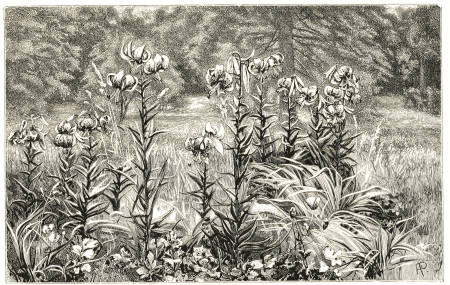
Tiger Lilies in Wild Garden at Great Tew.
Not to mow is almost a necessity in the wild garden: considering that there is frequently in large gardens much more mown surface than is necessary, many will not regret this need. Here the Grass is designedly left unmown in many places, and thereby much labour is saved. Of course it may be cut when ripe, and most of the spring flowers have past and their leaves are out of danger; even in parts where no flowers are planted the Grass is left till long enough to cut as meadow. Except where actually required as a carpet, Grass may often be allowed to grow even in the pleasure ground; quite as good an effect is afforded by the unmown as the mown Grass—indeed, better when the long Grass is full of flowers. Three–fourths of the most lovely flowers of cold and temperate regions are companions of the Grass—like Grasses in hardiness, like Grasses in summer life and winter rest, like them[100] even in stature. Whatever plants may seem best to associate with in gardens, an immense number—more than two thousand species of those now cultivated—would thrive to perfection among our meadow Grasses, as they do on the Grassy breast of the mountain in many lands. Some, like the tall Irises or Columbines, will show their heads clear above the delicate bloom of the Grass; others, like the Cerastiums, will open their cups below it, in this way multiplying the variety of effects that may be obtained. The varieties of Columbine in the Grass were perhaps the prettiest flowers at the time of my visit. The white, purplish, and delicately–variegated forms of this charming old plant, just seen above the tops of the long Grass, growing singly, in little groups, or in spreading colonies, were sufficient in themselves to form a wild garden for June. Established among the Grass, they will henceforward, like it, take care of themselves. The rosy, heart–shaped blooms of the Dielytra spectabilis are recognised at some distance through the Grass, and, so grown, furnish a bright and peculiarly pretty effect. Tree Pæonies succeed admirably, and their great heads of flower quite light up this charming wilderness. Plants of the Goat’s Beard Spiræa (S. Aruncus) are very stately and graceful, even now, before their flowering, being quite 6 ft. high. In a few weeks, when the numerous flowers are open, they will present quite another aspect. In the wild garden, apart from the naturalisation of free–growing exotics, the establishment of rare British flowers is one of the most interesting occupations; and here, under a Pine tree, the modest, trailing Linnæa borealis of the northern Fir–woods is beginning to spread. The Foxglove was not originally found in the[101] neighbourhood; now the ordinary kind and the various other forms of this fine wild flower adorn the woods. In this way also the Lily of the Valley has been introduced and is spreading rapidly. Many climbing Roses and various other climbers have been planted at the bases of trees and stumps, but, though thriving, the plantation is as yet too young to show the good effect that these will eventually produce. There is no finer picture at present to be seen in gardens than a free–growing flowering creeper, enjoying its own wild way over an old tree or stump, and sending down a rain of flower–laden shoots. A Clematis montana here, originally trained on a wall, sent up some of its shoots through a tree close at hand, where, fortunately, they have been allowed to remain, and now the long shoots hang from the tree full of flowers. The large plumes of the nobler hardy Ferns are seen here and[102] there through the trees and Grass, and well they look—better here among the Grass and flowers, partially shaded by trees, than in the hardy Fernery, which is so often a failure, and when a success, often “too much of a muchness,” so to say. The wild garden of the future will be also the true home of all the more important hardy Ferns. The rivals of the Ferns in beauty of foliage, the Ferulas, and various other umbelliferous plants with beautifully cut foliage, have also their homes in the wild garden. The Welsh Poppy thrives, as might be expected, admirably in the grove, its rich yellow cups just showing above the meadow.
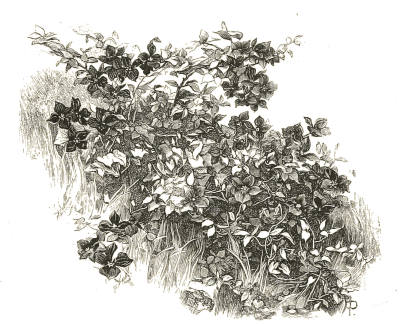
Large–flowered Clematis.
In another part of the grounds there is a raised walk quite away from trees, open and dry, with sloping banks on each side. This may be called a sun–walk, and here quite a different type of vegetation is grown; Scotch Roses, Brooms, Sun Roses, Rock Roses, etc. It is quite recently formed, and will probably soon accommodate a more numerous and interesting flora. Such an open sunny walk, with dry banks near, is a capital position in which to carry out various phases of the wild garden. Peculiarly suitable, however, in such a position is a good illustration of the vegetation of the hot, rocky, and gravelly hill–sides of the Mediterranean region, and this is quite easily represented, for the various leguminous plants and dwarf Pea–flowered shrubs, such as the Spanish Broom, many of the beautiful Rock Roses (Cistus), the Sun Roses (Helianthemum), and the Lavenders, will, with a host of companions, for the most part thrive quite as well on a sunny sandy bank in England as in Italy or Greece. In the wild garden it is easy to arrange aspects of vegetation having a geographical interest, and a portion of such a sunny bank as[103] I allude to might be worthily furnished with the various aromatic plants (nearly all hardy) which one meets with on the wild hill–sides of Southern France, and which include Thyme, Balm, Mint, Rosemary, Lavender, and various other old garden favourites.
True taste in the garden is unhappily much rarer than many people suppose. No amount of expense, rich collections, good cultivation, large gardens, and plenty of glass, will suffice; all these and much more it is not difficult to see, but a few acres of garden showing a real love of the beautiful in Nature, as it can be illustrated in gardens, is rare, and when it is seen it is often rather the result of accident than design. This is partly owing to the fact that the kind of knowledge one wants in order to form a really beautiful garden is very uncommon. No man can do so with few materials. It is necessary to have some knowledge of the enormous wealth of beauty which the world contains for the adornment of gardens; and yet this knowledge must not have a leaning, or but very partially, towards the Dryasdust character. The disposition to “dry” and name everything, to concern oneself entirely with nomenclature and classification, is not in accordance with a true gardening spirit—it is the life we want. The garden of the late Mr. Hewittson, at Weybridge, contained some of the most delightful bits of garden scenery which I have ever seen. Below the house, on the slope over the water of Oatlands Park, and below the usual lawn beds, trees, etc., there is a piece of heathy ground which, when we saw it, was charming beyond any power of the pencil to show. The ground was partially clad with common Heaths with little irregular green paths through them, and abundantly[104] naturalised in the warm sandy soil were the Sun Roses, which are shown in the foreground of the plate. Here and there among the Heaths, creeping about in a perfectly natural–looking fashion, too, was the Gentian blue Gromwell (Lithospermum prostratum), with other hardy plants suited to the situation. Among these naturalised groups were the large Evening Primroses and Alstrœmeria aurea, the whole being well relieved by bold bushes of flowering shrubs, so tastefully grouped and arranged as not to show a trace of formality. Such plants as these are not set out singly and without preparation, but carefully planted in beds of such naturally irregular outline, that when the plants become established they seem native children of the soil, as much as the Bracken and Heath around. It is remarkable how all this is done without in the least detracting from the most perfect order and keeping. Closely–shaven glades and wide Grass belts wind about among such objects, while all trees that require special care and attention show by their health and size that they find all they require in this beautiful garden. It is more free from needless or offensive geometrical–twirling, barren expanse of gravelled surface, and all kinds of puerilities—old–fashioned and new–fangled—than any garden I have seen for years.
The following, from a correspondent, shows what may be done with few advantages as to space or situation:—
We have a dell with a small stream of spring water running through it. When I first came to Brockhurst I found this stream carried underground by a tile culvert, and the valley sides covered with Rhododendrons, the soil between carefully raked and kept free from weeds, so that it was only during springtime that flowers relieved the sombre effect of this primness. After five years this has all been changed into what I think you would call a wild garden, and we have cheerfulness and beauty all the year round.
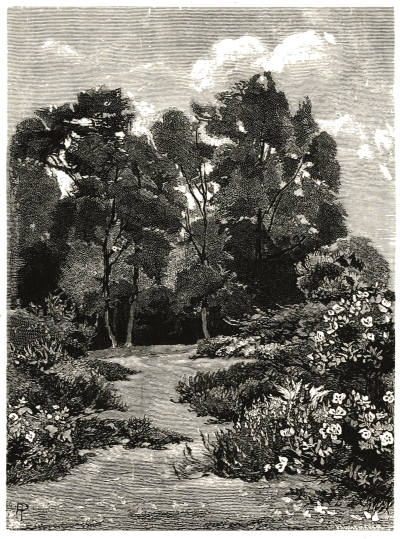
Sun Roses (Cistus) and other exotic hardy plants among heather, on sandy slope.
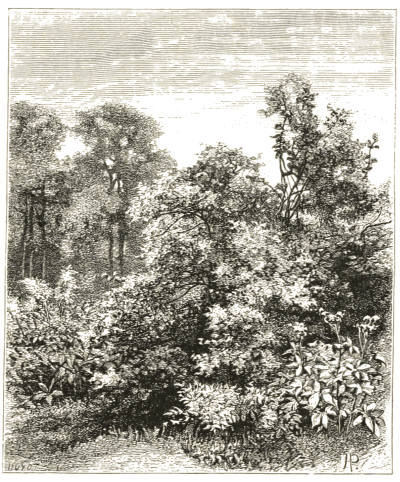
Wood and herbaceous Meadow–sweets grouped together in Mr. Hewittson’s garden.
In the first place the brooklet was brought to the surface, and its course fringed with marsh plants, such as Marsh Marigolds, Forget–me–nots, Celandines, Irises, Primroses, and Ranunculuses, together with Osmundas, Hart’s–tongues, and other Ferns. Many large–growing Carexes and ornamental Rushes are also here. Little flats were formed and filled with peat, in which Cypripediums, Trilliums, Orchises, Solomon’s Seal, and many rare bog plants find a home. In the valley we have planted bulbs by thousands—Crocuses, Snowdrops, Daffodils, Narcissi, etc. The Rhododendrons were thinned and interspersed with Azaleas, Aucubas, and other handsome–foliaged shrubs, to give brightness to the spring flowering, and rich colour to the foliage in autumn. In the spaces between we introduced wild Hyacinths everywhere, and[106] in patches amongst these the Red Campion, together with every other pretty wild flower we could obtain—Forget–me–nots, Globe–flowers, Columbines, Anemones, Primroses, Cowslips, Polyanthuses, Campanulas, Golden Rods, etc. All the bulbs which have bloomed in the greenhouses are planted out in these spaces, so that there are now large clumps of choice sorts of Crocus, Tulip, Narcissus, and Hyacinth. We have also planted bulbs very extensively, and as they have been allowed to grow on undisturbed we have now large patches of Daffodils, Narcissi, and other spring flowers in great beauty and exuberance. When we trim the garden all the spare plants are brought here, where they form a reserve, and it is thus gradually getting stocked, and all the bare ground covered with foliage and flowers. Lastly, for autumn blooming we raised large quantities of Foxgloves in every colour, and the larger Campanulas, and these were pricked out everywhere, so that we have a glorious show of Foxglove flowers to close the year worth all the trouble. A wild garden of this sort is a very useful reserve ground, where many a plant survives after it has been lost in the borders. Such spare seedlings as the Aquilegias, Campanulas, Primulas, Trolliuses, and other hardy plants can here find space until wanted elsewhere, and one can frequently find blooms for bouquets in the dell when the garden flowers are over. The Lily of the Valley and Sweet Violet also flourish here, creeping over heaps of stones, and flower more freely than they do in more open situations. Visitors often say that the dell beats all the rest of the garden for beauty, and it certainly gives less trouble in the attainment.
Brockhurst, Didsbury. In Garden.
Wm. Brockbank.
THE WILD GARDEN IN AMERICA.[2]
Probably many of your readers will ask, “What is a wild garden?” When I came to London, about fifteen years ago, “flower–gardening” had but one mode of expression only, viz. “bedding out,” and that in its harshest form—ribbons, borders, and solid masses of flowers of one colour and one height. The old hardy flowers had been completely swept away; the various and once popular race of so–called florist’s flowers were rarely or never seen. As a consequence, gardens were indescribably monotonous to any person with the faintest notion of the inexhaustible charms of the plant world. This kind of flower–gardening has the same relation to true art in a garden which the daubs of colour[107] on an Indian’s blanket have to the best pictures. In fighting, some years later, in the various journals open to me, the battle of nature and variety against this saddening and blank monotony, I was occasionally met by a ridicule of the old–fashioned mixed border which the bedding plants had supplanted. Now, a well–arranged and varied mixed border may be made one of the most beautiful of gardens; but to so form it requires some knowledge of plants, as well as good taste. Nevertheless, the objection was just as concerned the great majority of mixed borders; they were ragged, unmeaning, and even monotonous.
I next began to consider the various ways in which hardy plants might be grown wholly apart from either way (the bedding plants or that of the mixed border), and the wild garden, or garden formed in the wilderness, grove, shrubbery, copse, or rougher parts of the pleasure garden, was a pet idea which I afterwards threw into the form of a book with this name. In nearly all our gardens we have a great deal of surface wholly wasted—wide spaces in the shrubbery frequently dug over in the winter, plantations, grass–walks, hedgerows, rough banks, slopes, etc., which hitherto have grown only grass and weeds, and on these a rich garden flora may be grown. Hundreds of the more vigorous and handsome herbaceous plants that exist will thrive in these places and do further good in exterminating weeds and preventing the need of digging. Every kind of surface may be embellished by a person with any slight knowledge of hardy plants—ditch–banks, gravel–pits, old trees, hedge–banks, rough, grassy places that are never mown, copses, woods, lanes, rocky or stony ground.
The tendency has always been to suppose that a plant from another country than our own was a subject requiring much attention, not thinking that the conditions that occur in such places as mentioned above, are, as a rule, quite as favourable as those that obtain in nature throughout the great northern regions of Europe, Asia, and America. Here some common plants of the woods of the Eastern States are considered rarities and coddled accordingly to their destruction. It is quite a phenomenon to see a flower on the little Yellow Dog’s–Tooth Violet, which I remember seeing in quantity among the grass in your noble Central Park. When one has but a few specimens of a plant, it is best no doubt to carefully watch them. But an exposed and carefully dug garden border is the worst place to grow many wood and copse plants (I mean plants that grow naturally in such places), and in many uncultivated spots here the American Dog’s–Tooth Violet would flower quite as freely as at home. Your[108] beautiful little May–flower, Epigæa repens, we have never succeeded in growing in our best American nurseries, as they are called, which grow your Rhododendrons and other flowering shrubs so well. If a number of young plants of this were put out in a sandy fir–wood, under the shrubs and pines, as they grow in New Jersey, we should succeed at once. Your beautiful Trillium grandiflorum is usually seen here in a poor state; but I have seen a plant in a shady position in a shrubbery, in rich, moist soil, quite two feet through and two feet high.
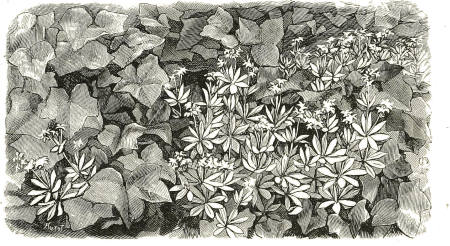
Woodruft and Ivy.
I mention these things to show that the wild garden may even have advantages from the point of view of cultivation. Another advantage is the facilities it affords us for enjoying representations of the vegetation of other countries. Here, for example, the poorest soil in the most neglected copse will grow a mixture of golden rods and asters, which will give us an aspect of vegetation everywhere seen in American woods in autumn. This to you may appear a very commonplace delight; but as we have nothing at all like it, it is welcome. Besides, we in this way get the golden rods and coarser asters out of the garden proper, in which they used to overrun the choicer plants, and where they did much to disgrace the mixed border. So, in like manner, you may, in New England or New Jersey, make wild gardens of such of our English flowers as you love. For example, the now numerous and very handsome varieties of our Primroses, Polyanthuses, and Oxlips would probably succeed better with you in moist places, in woods, or partially shaded positions, than in the open garden. There[109] can be no doubt in which position they would look best. But let us suppose for a moment that there was no other object for the wild garden in America than growing the many lovely wild flowers that inhabit the land, it is sufficient. Here some of your wildlings are the darlings of our rock–garden growers, though we are far from possessing all the bright flowers and graceful trailers that adorn the bogs and woods and heaths of the Eastern States. It would be most wise, in case of possessing a little bit of wood or copse, adorned naturally with the trailing Partridge Berry, and the rosy Lady’s Slipper (Cypripedium acaule), which I noticed growing so plentifully, to preserve the spot as a wild garden, and add to it such home and foreign, free and handsome hardy plants, as one could obtain.
It is impossible in this letter to speak of the various kinds of wild gardens, but the opportunity which the system offers for embellishing cool shady places is one which should make it interesting to the people to whose language belongs the term “shade trees.” Usually flower beds and borders are in the full sun—a very proper arrangement in a cool country. But even in our climate, there are in the warm months many days in which the woodland shade is sought in preference to the open lawn, and when the fully–exposed garden is deserted. Therefore, it is clearly desirable that we have flowers in shady as well as sunny places. Many plants, too, love the shade, and we only require to plant the most suitable of these to enjoy a charming wild garden. It need not be pointed out to Americans that a vast number of herbaceous plants naturally inhabit woods. In America, where shade is such a necessity, the wild garden in the shade will be the most delightful retreat near the country house. In it many of the plants common in the gardens of all northern countries will, without wearisome attention, flower in the spring.
For the early summer months flowers of a somewhat later period will be selected, as, for example, the later Irises—lovely hardy flowers, the tall Asphodel A. ramosus, the Day Lilies (Hemerocallis), the Solomon’s Seal and some of its allies, the Veronicas, tall Phloxes, the great Scarlet Poppy (Papaver bracteatum), Symphytums in variety;—these are all free–growing and admirable plants for the wild wood–garden. Mulleins (Verbascum), Salvias, Harebells (Campanula), Willow herbs, tall Lupines, Geraniums, Spurges, Meadow Rues, Columbines, Delphiniums, and the latest wind flowers (Anemone).
Later still, and in the sunny days, would come the various beautiful everlasting peas, various plants of the Mallow tribe, the Poke[110] Weeds, broad–leaved Sea Lavender, and other vigorous kinds, the Globe Thistles, Acanthuses, the free–flowering Yuccas, such as Y. flaccida and Y. filamentosa, the common Artichoke, with its noble flowers; and in autumn, a host of the Golden Rods and Michaelmas Daisies. These are so common in America that adding them to the wild garden would probably be considered a needless labour; but the substitution of the various really beautiful species of aster for those commonly found and of inferior beauty would well repay. In case it were thought desirable in making a wild garden in a shady position to grow plants that do not attain perfection in such positions, they might be grown in the more open parts at hand, and sufficiently near to be seen in the picture.
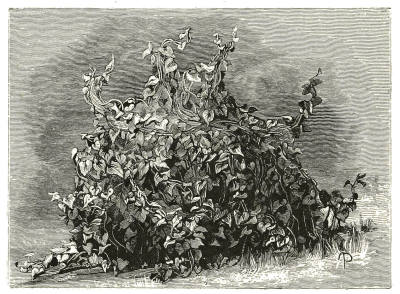
CHAPTER XIII.
A PLAN FOR THE EMBELLISHMENT OF THE SHRUBBERY
BORDERS IN LONDON PARKS.
ill111
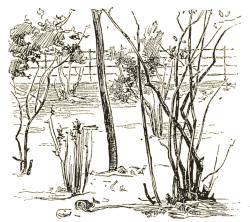
Dug and mutilated Shrubbery in St. James’s Park. Sketched in winter of 1879.
In the winter season, or indeed at any other season, one of the most melancholy things to be seen in our parks and gardens are the long, bare, naked shrubberies, extending, as along the Bayswater Road, more or less for a mile in a place; the soil greasy, black, seamed with the mutilated roots of the poor shrubs and trees; which are none the better, but very much the worse, for the cruel annual attention of digging up their young roots without returning any adequate nourishment or good to the soil. Culturally, the whole thing is suicidal, both for trees and plants. The mere fact of men having to pass through one[112] of those shrubberies every autumn, and, as they fancy, “prune” and otherwise attend to unfortunate shrubs and low trees, leads to this, and especially to the shrubs taking the appearance of inverted besoms. Thus a double wrong is done, and at great waste of labour. Any interesting life that might be in the ground is destroyed, and the whole appearance of the shrubbery is made hideous from the point of view of art; all good culture of flowering or evergreen shrubs destroyed or made impossible. This system is an orthodox one, that has descended to us from other days, the popular idea being that the right thing to do in autumn is to dig the shrubbery. The total abolition of this system, and the adoption of the one to be presently described, would lead to the happiest revolution ever effected in gardening, and be a perfectly easy, practicable means for the abolition of the inverted besoms, and the choke–muddle shrubbery, and these awful wastes of black soil and mutilated roots.
Two ideas should be fixed in the mind of the improver, the one being to allow all the beautiful shrubs to assume their natural shapes, either singly or in groups, with sufficient space between to allow of their fair development, so that the shrubbery might, in the flowering season, or indeed at all seasons, be the best kind of conservatory—a beautiful winter garden even, with the branches of most of the shrubs touching the ground, no mutilation whatever visible, and no hard dug line outside the shrubs. This last improvement could easily be effected by forming a natural fringe, so to say, by breaking up the usual hard edge from good planting; by letting, in fact, the edge be formed by well–furnished shrubs projected beyond the hard line, and running in and out as they do on a[113] hill copse, or as the box bushes sometimes do on a Sussex down. Here care, variety in selection, taste and skill in grouping, so as to allow different subjects, whether placed singly or in groups, or little groves, being in a position where they may grow well and be seen to advantage, would lead to the most charming results in the open–air garden. With sufficient preparation at first, such shrubberies would be the cause of very little trouble afterwards.
Now, such beauty could be obtained without any further aid from other plants; and in many cases it might be desirable to consider the trees and shrubs and their effect only, and let the turf spread in among them; but we have the privilege of adding to this beautiful tree and shrub life another world of beauty—the bulbs and herbaceous plants, and innumerable beautiful things which go to form the ground flora, so to say, of northern and temperate countries, and which light up the world with loveliness in meadow or copse, or wood or alpine pasture in the flowering season. The surface which is dug and wasted in all our parks, and in numbers of our gardens, should be occupied with this varied life; not in the miserable old mixed border fashion, with each plant stuck up with a stick, but with the plants in groups and colonies between the shrubs. In the spaces where turf would not thrive, or where it might be troublesome to keep fresh, we should have irises, or narcissi, or lupines, or French willows, or Japan anemones, or any of scores of other lovely things which people cannot now find a place for in our stiff gardens. The soil which now does little work, and in which the tree–roots every year are mercilessly dug up, would support myriads of lovely plants. The necessity of[114] allowing abundant space to the shrubs and trees, both in the young and the adult stage, gives us some space to deal with, which may be occupied with weeds if we do not take care of it. The remedy, then, is to replace the weed by a beautiful flower, and to let some handsome hardy plant of the northern world occupy each little space; keeping it clean for us, and, at the same time, repaying us by abundant bloom, or fine foliage or habit. This system in the first place allows the shrubs themselves to cover the ground to a great extent. In the London parks now every shrub is cut under so as to allow the digger to get near it; and this leads to the most comical and villainous of shapes ever assumed by bushes. Even the lilac bushes, which we see so horribly stiff, will cover the ground with their branches if allowed room enough; therefore, to a great extent, we should have the branches themselves covering the ground instead of what we now see. But open spaces, little bays and avenues running in among the shrubs, are absolutely essential, if we want to fully enjoy what ought to be the beautiful inhabitants of our shrub garden. Such openings offer delightful retreats for hardy flowers, many of which thrive better in semi–shady spots than they do in the open, while the effect of the flowers is immeasurably enhanced by the foliage of the shrubs around. To carry out this plan well, one should have, if possible, a good selection of the shrubs to begin with, although the plainest shrubbery, which is not overgrown or overcrowded, may be embellished with hardy plants on the ground. The plan may be adopted in the case of new shrubberies being formed, or in the case of old ones; though the old ones are frequently so dried up and overcrowded that great alterations[115] would have to be made here and there. In the case of young shrubberies it is, of course, necessary at first to keep the surface open for a while until the shrubs have taken hold of the ground; then the interesting colonies to which we alluded may be planted.
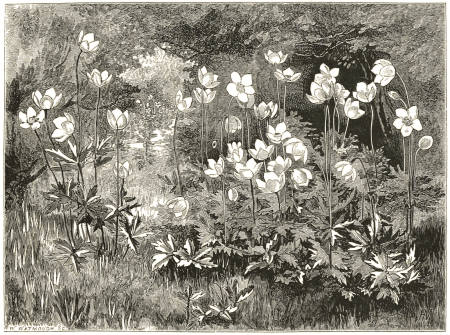
Colony of the Snowdrop–Anemone in Shrubbery not dug. Anemone taking the place of weeds or bare earth.
An essential thing is to abolish utterly the old dotting principle of the mixed border, as always ugly and always bad from a cultural point of view. Instead of sticking a number of things in one place, with many labels, and graduating them from the back to the front, so as to secure the stiffest imaginable kind of arrangement, the true way is to have in each space wide colonies or groups of one kind, or more than one[116] kind. Here is a little bay, for example, with the turf running into it, a handsome holly feathered to the turf forming one promontory, and a spreading evergreen barberry, with its fine leaves also touching the ground, forming the other. As the turf passes in between those two it begins to be colonised with little groups of the pheasant’s–eye Narcissus, and soon in the grass is changed into a waving meadow of these fair flowers and their long grayish leaves. They carry the eye in among the other shrubs, and perhaps carry it to some other colony of a totally different plant behind—an early and beautiful boragewort, say, with its bright blue flowers, also in a spreading colony. Some might say, Your flowers of narcissi only last a certain time; how are you going to replace them? The answer is, that they occupy, and beautifully embellish, a place that before was wholly naked, and worse than naked, and in this position we contend that our narcissi should be seen in all their stages of bud and bloom and decay without being hurried out of the world as soon as their fair bloom is over, as they are on the border or in the greenhouse. They are worth growing if we only secure this one beautiful aspect of vegetation where before all was worse than lost. We also secure plenty of cut flowers without troubling the ordinary resources of the garden.
We might then pass on to another, of the German iris, occupying not only a patch, but a whole clump; for these enormous London parks of ours have acres and acres on every side of this greasy dug earth which ought to sparkle with flowers; and, therefore, a very fine plant might be seen to a large extent. And how much better for the gardener or cultivator to have to deal with one in one[117] place than be tormented with a hundred little “dots” of flowers—alpine, rock, wood, copse, or meadow plants—all mixed up in that usually wretched soup called the “mixed border”! No plants that require staking ought to be used in the way we are speaking of. Day lilies, for example, are good plants. In some bold opening what a fine effect we could get by having a spreading colony of these therein; scores of plants might be named, that want no sticking, for such places. Each plant having a sufficient space and forming its own colony, there is much less doubt in case of alterations as to what should be done. In fact, in the case of an intelligent cultivator, there should be no doubt. Observe the advantage of this plan. Instead of seeing the same plants everywhere, we should pass on from narcissi to iris, from iris to bluebell, and thus meet with a different kind of vegetation in each part of the park or garden, instead of the eternal monotony of privet and long dreary line of “golden–feather” everywhere. The same kind of variety, as suggested for the flowers, should be seen among the shrubs. The sad planter’s mixture—privet, laurel, etc.—taking all the colour and all the life and charm out of the shrubbery, should be avoided; so, too, the oppressive botanical business, with everything labelled, and plants classified out of doors as they are in an herbarium. They should be put where they would look well and grow best. Well carried out, such a system would involve labour, and, above all things, taste at first; but it would eventually resolve itself into the judicious removal of interloping weeds. The labour that is now given to dig and mutilate once a year and keep clean at other times of the year would easily, on the plan proposed, suffice for a much[118] larger area. More intelligence would certainly be required. Any ignorant man can dig around and mutilate a shrub and chop up a white lily if he meets it! But any person taught to distinguish between our coarse native weeds and the beautiful plants we want to establish, passing round now and then, would keep all safe.
On a large scale, in the London parks, such a plan would be impossible to carry out without a nursery garden; that is to say, the things wanted should be in such abundance, that making the features of the kind we suggest would be easy to the superintendent. The acres and acres of black surface should themselves afford here and there a little ground where the many hardy plants adapted for this kind of gardening might be placed and increased. This, supposing that a real want of the public gardens of London—a large and well–managed nursery in the pure air—is never carried out: the wastefulness of buying everything they want—even the commonest things—is a costly drawback to our London public gardens. At the very least we should have 100 acres of nursery gardens for the planting and replanting of the London parks. So, too, there ought to be intelligent labour to carry out this artistic planting; and with the now–awakened taste for some variety in the garden, one cannot doubt that a few years will give us a race of intelligent young men, who know a little of the plants that grow in northern countries, and whose mental vision is not begun and ended by the ribbon border.
The treatment of the margin of the shrubbery is a very important point here. At present it is stiff—the shrubs cut in or the trees cut in, and an unsightly border running[119] straight along, perhaps with a tile edging. Well, the right way is to have a broken margin, to let the shrubs run in and out themselves, and let them form the margin; let them come to the ground in fact, not stiffly, and here and there growing right outside the ordinary boundary, in a little group. Throw away altogether the crowded masses of starved privet and pruned laurel, and let the turf pass right under a group of fine trees where such are found. This turf itself might be dotted in spring with snowdrops and early flowers; nothing, in fact, would be easier than for any intelligent person, who knew and cared for trees and shrubs, to change the monotonous wall of shrubbery into the most delightful of open–air gardens; abounding in beautiful life, from the red tassels on the topmost maples to flowers in the grass for children.

Colony of the Summer Snowflake, on margin of shrubbery.
CHAPTER XIV.
THE PRINCIPAL TYPES OF HARDY EXOTIC FLOWERING PLANTS FOR THE WILD GARDEN.
Wherever there is room, these plants should be at first grown in nursery beds to ensure a good supply. The number of nursery collections of hardy plants being now more numerous than they were a few years ago, getting the plants is not so difficult as it once was. The sources of supply are these nurseries; seed houses, who have lists of hardy plant seeds—many kinds may be easily raised from seed; botanic gardens, in which many plants are grown that hitherto have not found a place in our gardens, and were not fitted for any mode of culture except that herein suggested; orchards and cottage gardens in pleasant country places may supply desirable things from time to time; and those who travel may bring seeds or roots of plants they meet with in cool, temperate, or mountain regions. Few plants, not free of growth and hardy in the British Islands without any attention after planting, are included here:—
Bear’s Breech, Acanthus.—Vigorous perennials with noble foliage, mostly from Southern Europe. Long cast out of gardens, they are now beginning to receive more of the attention they deserve. In no position will they look better than carelessly planted here and there on the margin of a shrubbery or thicket, where the leaves of the Acanthus contrast well with those of the ordinary shrubs or herbaceous[121] vegetation. Though quite hardy in all soils, they flower most freely in free loamy soils. Not varying very much in character, all obtainable hardy species would group well together. The most vigorous kind at present in cultivation is one called A. latifolius, almost evergreen, and a fine plant when well established. Few plants are more fitted for adorning wild and semi–wild places, as they grow and increase without care, and are for foliage or bloom unsurpassed by any of the numerous plants that have been so long neglected through their not being available in any popular system of “flower gardening.”ill121
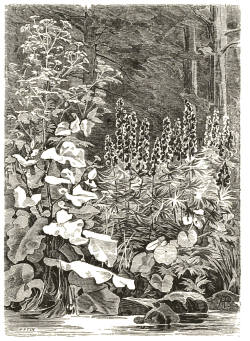
The Monkshood, naturalised by wet ditch in wood.
Monkshood, Aconitum.—These are tall, handsome perennials, with very poisonous roots, which make it dangerous to plant them in or near gardens. Being usually very vigorous in constitution, they spread freely, and hold their own amongst the strongest herbaceous plants and weeds; masses of them seen in flower in copses or near hedgerows afford a very fine effect. There are many species, all nearly of equal value for the wild garden. Coming from the plains and mountains of Siberia and Northern Europe and America, they are among the hardiest of plants. When spreading groups of Aconites are in bloom in copses or open spaces in shrubberies, their effect is far finer than when the plants are tied into bundles in trim borders. The old blue–and–white kind is charming in half–shady spots, attaining stately dimensions in good soil. The species grow in any soil, but are often somewhat stunted in growth on clay.
Bugle, Ajuga.—Not a very numerous family so far as represented in gardens, but some of the species are valuable for the wild garden, notably Ajuga genevensis, which thrives freely in ordinary soils in open and half–shady places among dwarf vegetation, and affords beautiful tufts and carpets of blue. It spreads rapidly and is hardy everywhere. The plants mostly come from the cool uplands and hills of the temperate regions of Europe and Asia.
Yarrow, Achillea.—A numerous family of hardy plants spread through Northern Asia, Italy, Greece, Turkey, Hungary, etc., but more in Southern than in Central or Northern Europe. In the Alps and Pyrenees numerous species are found. The Golden Yarrows (A. Eupatorium and A. filipendulina) are stately herbaceous plants, with broad handsome corymbs of brilliantly showy flowers, attaining a height of 3 feet or 4 feet, and growing freely in any soil. These are well worthy of naturalisation. Various other Achilleas would grow quite as well in copses and rough places as the common Yarrow, but we know of none more distinct and brilliant than the preceding. The vigorous white–flowering kinds are superb for shrubberies, where their numerous white heads of flowers produce a singularly pleasing effect under the trees in summer. With few exceptions these plants have never been grown out of botanic gardens, many of them being thought too coarse for the mixed border. They are, nevertheless, remarkably beautiful both in flower and foliage, and many effects never before seen in gardens may be obtained by massing them under trees in shrubberies or copses, as a rule allowing one species to establish itself in each place and assume an easy natural boundary of its own. The small Alpine species would be interesting plants for stony or bare rocky places.
Allium.—A most extensive genus of plants scattered in abundance throughout the northern temperate and alpine regions of Europe and Asia, and also in America. Some of the species are very beautiful, so much so as to claim for them a place in gardens notwithstanding their disagreeable odour. It is in the wild garden only, however, that this family can find a fitting home; there species that do not seem attractive enough for the garden proper would afford novel effects at certain seasons. One of the most desirable effects to produce in the wild garden would be that of the beautiful white Narcissus–like Allium of the south of Europe (A. neapolitanum). The sheets of this in the Lemon orchards of Provence will be remembered with pleasure by many travellers. It would thrive in warm and sandy soils: there is an allied species (A. ciliatum) which does well in any soil, affords a[123] similar effect, and produces myriads of star–like white flowers. Numerous singular effects may be produced from species less showy and more curious and vigorous, as for example the old yellow A. Moly.
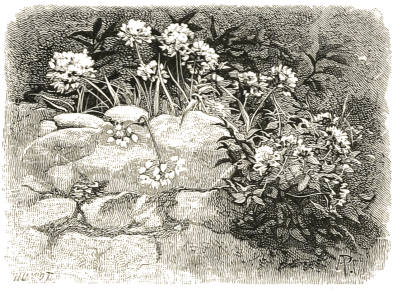
The white Narcissus–like Allium, in the orchards of Provence; type of family receiving little place in gardens which may be beautiful for a season in wild places.
Alstrœmeria.—All who care for hardy flowers must admire the beauty of Alstrœmeria aurantiaca, especially when it spreads into bold healthy tufts, and when there is a great variety in the height of the flowering stems. A valuable quality of the plant is, that in any light soil it spreads freely, and it is quite hardy. For dry places between shrubs, for dry or sandy banks (either wooded or bare), copses, or heathy places, this plant is admirable. I have noticed it thriving in the shade of fir trees. It is interesting as being a South American plant, thriving in any open soil.
Marsh Mallow, Althæa.—These are plants rarely seen out of botanic gardens now–a–days, and yet, from their vigour and showy flowers, they may afford unique effects in the wild garden. The common Hollyhock is an Althæa, and in its single form is typical of the vigorous habit and the numerous showy flowers of other rampant species, such as A. ficifolia. A group of these plants would be very effective seen from a wood walk, no kind of garden arrangement being large enough for their extraordinary vigour. It is not a numerous genus, but there are at least a dozen species, principally found on the shores and islands of the Mediterranean, and also in Western Asia.
Alyssum.—In spring every little shoot of the wide tufts and flakes[124] of these plants sends up a little fountain of small golden flowers. For bare, stony, or rocky banks, poor sandy ground, and ruins, they are admirable. Alyssum Wiersbecki and A. saxatile are strong enough to take care of themselves on the margins of shrubberies, etc., where the vegetation is not very coarse, but they are more valuable for rocky or stony places, or old ruins, and thrive freely on cottage garden walls in some districts; some of the less grown species would be welcome in such places. There are many species, natives of Germany, Russia, France, Italy, Corsica, Sicily, Hungary, and Dalmatia; Asia, principally Siberia, the Altai Mountains, Georgia, Persia, and the entire basin of the Caspian, is rich in them.
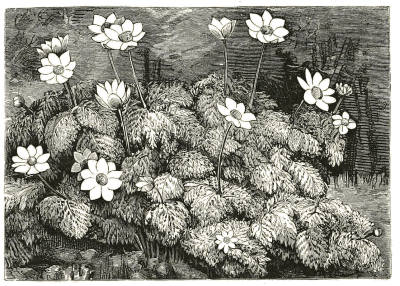
The Alpine Windflower (Anemone alpina).
Windflower, Anemone.—A numerous race of dwarf herbs that contribute largely to the most beautiful effects of the mountain, wood, and pasture vegetation of all northern and temperate climes. The flowers vary from intense scarlet to the softest blue; most of the exotic kinds would thrive as well in our woodlands and meadows as they do in their own. There is hardly a position they may not adorn—warm, sunny, bare banks, on which the Grecian A. blanda might open its large blue flowers in winter; the tangled copse, where the Japan Windflower and its varieties might make a bold show in autumn; and the shady wood, where the Apennine Windflower would contrast charmingly with the Wood Anemone so abundantly scattered in our[125] own woods. The Hepaticas should be considered as belonging to the same genus, not forgetting the Hungarian one, A. angulosa. The Hepaticas thrive best and are seen best in half–woody places, where the spring sun may cheer them by passing through the branches, which afterwards become leafy and shade them from the scorching heats of summer.
St. Bruno’s Lily, Anthericum.—One of the most lovely aspects of vegetation in the alpine meadows of Europe is that afforded by the delicate white flowers of the St. Bruno’s Lily in the Grass in early summer, looking like miniature white Lilies. All who have seen it would no doubt like to enjoy the same in their turfy lawns or Grassy places, and there should be no difficulty in establishing it. The large–flowered or major variety might be tried with advantage in this way, and the smaller–flowered kinds, A. Liliago and its varieties, are equally suitable. They are not so likely to find favour in gardens as the larger kind, and therefore the wild garden is the home for them, and in it many will admire their graceful habit and numerous flowers. All the species best worth growing are natives of the alpine meadows of Europe.
Alkanet, Anchusa.—Tall and handsome herbaceous plants, with numerous flowers of a fine blue, admirable for dotting about in open places in sunny glades in woods or copses. They mostly come from Southern Europe and Western Asia. A. italica and A. capensis are among the most useful. The English Anchusa sempervirens, rare in some places, is an excellent wild garden plant.
Snapdragon, Antirrhinum.—The common Snapdragon and its beautifully spotted varieties are easily naturalised on old walls and ruins by sowing the seed in old or mossy chinks. Antirrhinum Asarinum, rupestre, and molle do well treated in the same way. Probably many other species would be found good in like places. About two dozen species are known, but comparatively few of these are in cultivation. They mostly come from the shores of the Mediterranean.
Columbine, Aquilegia.—Favourite herbaceous plants, generally of various shades of blue and purple, white, and sometimes bright orange. The varieties of the common kind (A. vulgaris), which are very numerous, are those most likely to be naturalised. In elevated and moist districts some of the beautiful Rocky Mountain kinds would be worth a trial in bare places. In places where wild gardens have been formed the effect of Columbines in the Grass has been one of the most beautiful that have been obtained. The flowers group themselves in all sorts of pretty ways, showing just above the long Grass, and possessing great variety of colour. The vigorous and handsome A.[126] chrysantha of Western America is the most hardy and enduring of the American kinds. The species are of a truly northern and alpine family, most abundant in Siberia.ill126
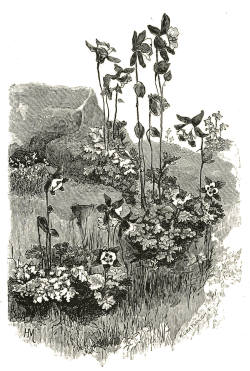
Siberian Columbine in rocky place.
Wall Cress, Arabis.—Dwarf alpine plants, spreading in habit, and generally producing myriads of white flowers, exceedingly suitable for the decoration of sandy or rocky ground, where the vegetation is very dwarf. With them may be associated Cardamine trifolia and Thlaspi latifolium, which resemble the Arabises in habit and flowers. All these are particularly suited for association with the purple Aubrietias, or yellow Alyssums, and in bare and rocky or gravelly places, old walls, sunk fences, etc.
Sandwort, Arenaria.—A most important family of plants for the wild garden, though perhaps less so for lowland gardens where more vigorous types flourish. There are, however, certain species that are vigorous and indispensable, such as A. montana and A. graminifolia. The smaller alpine species are charming for rocky places, and the little creeping A. balearica has quite a peculiar value, inasmuch as moist rocks or stones suffice for its support. It covers such surfaces with a close carpet of green, dotted with numerous star–like flowers. Some of the smaller species, such as Arenaria cæspitosa (Sagina glabra var.), better known as Spergula pilifera, might be grown in the gravel, and even used to convert bare and sandy places into carpets of Mossy turf. In certain[127] positions in large gardens it would be an improvement to allow the very walks or drives to become covered with very dwarf plants—plants which could be walked upon with little injury. The surface would be dry enough, being drained below, and would be more agreeable to the feet. Removing any coarse weeds that established themselves would be much easier than the continual hoeing and scraping required to keep the walk bare. Of course this only refers to walks in rough or picturesque places—the wild garden and the like—in which formal bare walks are somewhat out of place.ill127
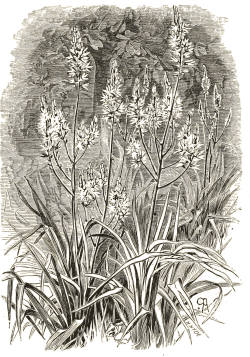
Tall Asphodel in copse.
Asphodel, Asphodelus.—The Asphodels are among the plants that have never been popular in the mixed border, nor are they likely to be so, the habit of the species being somewhat coarse and the flowering period not long, and yet they are of a stately and distinct order of beauty, which well deserves to be represented in open spaces, in shrubberies, or on their outer fringes. The plants are mostly natives of the countries round the Mediterranean, and thrive freely in ordinary soils.
Lords and Ladies, Arum.—Mostly a tropical and sub–tropical family, some of which grow as far north as southern Europe. These are quite hardy in our gardens. The Italian Arum is well worthy of a place in the wild garden, from its fine foliage in winter. It should be placed in sheltered half–shady places where it would not suffer much from storms. The old Dragon plant (A. Dracontium) grows freely enough about the foot of rocks or walls in sandy, or dry, peaty[128] places. The nearly allied Arum Lily (Calla æthiopica) is quite hardy as a water and water–side plant in the southern counties of England and Ireland.
Silkweed, Asclepias.—Usually vigorous perennials, with very curious and ornamental flowers, common in fields and on river banks in North America and Canada, where they sometimes become troublesome weeds. Of the species in cultivation, A. Cornuti and A. Douglasi could be naturalised easily in rich deep soil in wild places. The showy and dwarfer Asclepias tuberosa requires very warm sand soils to flower as well as in its own dry hills and fields. A good many of the hardy species are not introduced; for such the place is the wild garden. Some of them are water–side plants, such as A. incarnata, the Swamp Silkweed of the United States.
Starwort, Aster.—A very large family of usually vigorous, often showy, and sometimes beautiful perennials, mostly with bluish or white flowers, chiefly natives of North America. Many of these, of an inferior order of beauty, used to be planted in our mixed borders, which they very much helped to bring into discredit, and they form a very good example of a class of plants for which the true place is the copse, or rough and half–cared–for places in shrubberies and copses, and by wood–walks, where they will grow as freely as any native weeds, and in many cases prove highly attractive in late summer and autumn. Such kinds as A. pyrensæus, Amellus, and turbinellus, are amongst the most ornamental perennials we have. With the Asters may be grouped the Galatellas, the Vernonias, and also the handsome and rather dwarf Erigeron speciosus, which, however, not being so tall, could not fight its way among such coarse vegetation as that in which the Asters may be grown. Associated with the Golden Rods (Solidago)—also common plants of the American woods and copses—the best of the Asters or Michaelmas Daisies will form a very interesting aspect of vegetation. It is that one sees in American woods in late summer and autumn when the Golden Rods and Asters are seen in bloom together. It is one of numerous aspects of the vegetation of other countries which the “wild garden” will make possible in gardens. To produce such effects the plants must, of course, be planted in some quantity in one part of a rather open wood, and not repeated all over the place or mixed up with many other things. Nearly 200 species are known, about 150 of which form part of the rich vegetation of North America. These fine plants inhabit that great continent, from Mexico—where a few are found—to the United States and Canada, where they abound, and even up to the regions altogether arctic of that quarter of the world.
Milk Vetch, Astragalus.—An enormously numerous family of beautiful hardy plants, represented to but a very slight extent in our gardens, though hundreds of them are hardy, and many of them among the most pleasing of the many Pea flowers which adorn the hills and mountains of the northern world in Asia, Europe, and America. They are mostly suited for rocky or gravelly situations, or bare banks, though some of the taller species, like A. galegiformis, are stout enough to take care of themselves among the larger perennials. This plant is valuable for its handsome port and foliage, though its flowering qualities are not such as recommend it for the garden proper. The numerous species from the Mediterranean shores and islands could be successfully introduced on banks and slopes in our chalk districts and in rocky places. A. ponticus, a tall kind, and A. monspessulanus, a dwarf one, are both worth growing.
Masterwort, Astrantia.—This is an elegant genus, of which few species are known, five being European—found in Italy, Carinthia, Greece, and the centre of Europe—others from Northern Asia. They are among the few umbellates with attractive and distinct flowers, and yet they are rarely seen in gardens. In the wild garden they are quite at home among the Grass and medium–sized herbaceous plants, and partial shade prolongs their quaint beauty. In fact they are far more at home in the thin wood or copse than in the open exposed mixed border.
Blue Rock Cress, Aubrietia.—Dwarf Alpine plants, with purplish flowers, quite distinct in aspect and hue from anything else grown in our gardens, and never perishing from any cause, except being overrun by coarser subjects. They are admirable for association with the Alyssums and Arabises in any position where the vegetation is very dwarf, or in rocky bare places. There are several species and varieties, all almost equally suitable, but not differing much in aspect or stature from each other. The Aubrietias come chiefly from the mountains of Greece, Asia Minor, and neighbouring countries. Wherever there is an old wall, or a sunk fence, or a bare bank, evergreen curtains may be formed of these plants, and in spring they will be sheeted with purple flowers, no matter how harsh the weather.
Great Birthwort, Aristolochia Sipho.—A noble plant for covering arbours, banks, stumps of old trees, etc., also wigwam–like bowers, formed with branches of trees. It is American, and will grow as high as thirty feet, A. tomentosa is distinct and not so large in leaf. These will scarcely be grown for their flowers; but for covering stumps or trees they are valuable, and afford a distinct type of foliage.
Virginian Creepers, Ampelopsis.—Although this chapter is mostly devoted to herbaceous plants, the Virginian Creeper and its allies are so useful for forming curtains in rocky places, ravines, or over old trees, that they deserve mention here. These plants are not very distant relations of the vine—the wild American vines which are worthy of a place in our groves, garlanding trees as they do in a grand way. Some noble in colour of leaf are grown in nurseries—U. Humboldti being remarkable both for colour and size of leaf.
Bamboo, Bambusa.—In many parts of England, Ireland, and Wales, various kinds of Bamboos are perfectly hardy, and not only hardy, but thrive freely. In cold, dry, and inland districts, it is true, they grow with difficulty—all the greater reason for making the best use of them where they grow freely. Their beauty is the more precious from their being wholly distinct in habit from any other plants or shrubs that we grow. The delicate feathering of the young, tall, and slender shoots, the charming arching of the stems, have often been fertile in suggestion to the Japanese artist, and often adorn his best work. They may be enjoyed with all the charms of life in many gardens. The wild garden, where the climate is suitable, is the best home for Bamboos. They are so tall and so enduring at the roots that they will take care of themselves among the tallest and strongest plants or bushes, and the partial shelter of the thin wood or copse preserves their abundant leaves from violent and cold winds. Along by quiet Grass walks, in sheltered dells, in little bogs, in the shrubbery, or in little lawns opened in woods for the formation of wild gardens, the Bamboo will be at home. The commonest kind is that generally known as Arundinaria falcata (sometimes called Bambusa gracilis); but others, such as Bambusa Metake, B. Simmonsi, and B. viridis–glaucescens, are of equal or greater value. They all delight in rich, light, and moist soils.
Baptisia.—A strong Lupin–like plant seldom grown in gardens, but beautiful when in bloom for its long blue racemes of pea flowers, growing three to four feet high; it will hold its own in strong soil.
Borage, Borago.—A genus seldom seen out of Botanic gardens, where they form part of the usual distressing arrangements honoured with the name of “scientific.” Among the best kinds for our purpose are B. cretica and B. orientalis, even the well–known annual kind will be found a pretty plant, naturalised and useful for covering mounds.
Bell–flower, Campanula.—Beautiful and generally blue–flowered[131] herbs, varying from a few inches to 4 ft. in height, and abundantly scattered in northern and temperate countries. Many kinds are in cultivation. All the medium–sized and large kinds thrive very well in rough places, woods, copses, or shrubberies, among grasses and other herbaceous plants; while those smaller in size than our own harebell (C. rotundifolia) are quite at home, and very pretty, on any arid or bare surfaces, such as sandy banks, chalk pits, and even high up on old walls, ruins, etc. In such positions the seeds have only to be scattered. C. rapunculoides and C. lamiifolia do finely in shrubberies or copses, as, indeed, do all the tall–growing kinds. Where there are white varieties they should be secured; many people will begin to see the great beauty of this family for the first time when they see them growing among the grass or herbs. The effect is far more beautiful than can be obtained in the garden proper.
Red Valerian, Centranthus ruber.—This showy and pleasing plant is only seen in highest perfection on elevated banks, rubbish–heaps, or old walls, in which positions it endures much longer than on the level ground, and becomes a long–lived perennial with a shrubby base. On the long bridge across the Nore at Col. Tighe’s place, Woodstock, Kilkenny, it grows in abundance, forming a long line on the wall above the arches; of course it could be easily grown on ruins, while it is invaluable for banks of all kinds, chalk pits, etc., and also for the level ground, except in heavy cold soils. Some of the larger Valerianas would grow freely in rough places, but none of them are so distinct as the preceding.
Knap–weed, Centaurea.—Vigorous perennial or annual herbaceous plants, seldom so pretty as autumn–sown plants of our corn bluebottle (C. Cyanus). They are scarcely important enough for borders; hence the wild wood is the place for them. Among the most suitable kinds may be mentioned macrocephala, montana, babylonica, and uniflora, the last more suitable for banks, etc.
Mouse–ear, Cerastium.—Dwarf spreading perennials, bearing a profusion of white flowers. Half a dozen or more of the kinds have silvery leaves, which, with their flowers, give them an attractive character. Most of these are used as bedding plants, but, as they will grow in any position where they are not choked by coarser plants, they may be employed with good effect in the wild garden.
Wallflower, Cheiranthus.—The varieties of the common wallflower afford quite a store of beauty in themselves for the embellishment of rocky places, old walls, etc. Probably other species of[132] Cheiranthus will be found to grow on ruins quite as well, but at present we are not quite sure of these. The clear yellow Erysimum ochroleucum is very like a wallflower in type, and thrives well in dry sandy places. With these might be associated Vesicaria utriculata.ill132
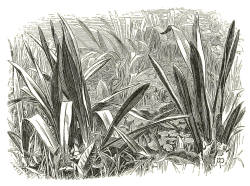
The foliage of the Meadow Saffron in Spring.
Meadow Saffron, Colchicum.—In addition to the meadow saffron, plentifully dotted over the moist fields in various parts of England, there are several other species which could be readily naturalised in almost any soil and position. They would be particularly desirable where subjects that flower in autumn would be sought; and they are charming, seen in tufts or colonies on the lawn or in the pleasure–ground.
Crocus.—One or two Crocuses are naturalised in England already, and there is scarcely one of them that will not succeed thus if properly placed. They should not be placed where coarse vegetation would choke them up or prevent the sun getting to their flowers and leaves. Some of the delicately–tinted varieties of vernus are well worth dotting about in grassy places and on sunny slopes, if only to accompany the snowdrop. C. Imperati is a valuable early–flowering kind, and the autumnal flowering ones are particularly desirable; but we must not particularise where all are good. “In the plantations here,” writes a correspondent, “on each side of a long avenue, we have the common Crocus in every shade of purple (there are scarcely any yellow ones) growing literally in hundreds of thousands. We have no record of when the roots were originally planted (and the oldest people about the estate say they have always been the same as far as their recollection goes); but they grow so thickly that it is quite impossible to step where they are without treading on two or three flowers. The effect produced by them in spring is magnificent, but unfortunately, their beauty is but short–lived. I have transplanted a good many roots to the wild garden, to the great[133] improvement of the size of the individual blooms; they are so matted together in the shrubberies I have mentioned, and have remained so long in the same place, that the flowers are small.”ill133
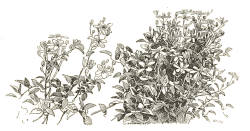
The White–flowered European Clematis (C. erecta).
Virgin’s Bower, Clematis.—Mostly climbing or trailing plants, free, often luxuriant, sometimes rampant, in habit, with bluish, violet, purple, white, or yellow flowers, produced most profusely, and sometimes deliciously fragrant. They are most suited for covering stumps, planting on rocky places, among low shrubs in copses, for draping over the faces of rocks, sunny banks, or the brows of sunk fences, covering objectionable railings, rough bowers, chalk pits, hedges, etc., and occasionally for isolating in large tufts in open spaces where their effect could be seen from a distance. Not particular as to soil, the stronger kinds will grow in any ground, but the large–flowered new hybrids will thrive best in warm, rich, deep soil.
C. Viorna, C. flammula, montana, campaniflora, Viticella, and cirrhosa, must not be omitted from a selection of the wild kinds. The new garden hybrids will also be useful.
Dwarf Cornel, Cornus canadensis.—This charming little bushy plant, singularly beautiful from its white bracts, is a very attractive subject for naturalisation in moist, sandy, or peaty spots, in which our native heaths, Mitchella repens, Linnæa borealis, and the Butterworts would be likely to thrive. It would also grow well in moist woods, where the herbaceous vegetation is dwarf.
Mocassin Flower, Cypripedium spectabile.—The noblest of hardy orchids, found far north in America, and thriving perfectly in England and Ireland in deep rich or vegetable soil. Wherever the soil is not naturally peat or rich vegetable matter this fine plant will succeed on the margins of beds of rhododendrons, etc. It should be sheltered by surrounding bushes, and be in a moist position. Others of the genus, and various other hardy orchids, are worthy of naturalisation; but the mocassin flower is the best as well as the most easily tried at present.
Sowbread, Cyclamen.—It was the sight of a grove nearly covered[134] with Cyclamen hederæfolium, near Montargis, in France, that first turned my attention to the “Wild Garden.” Both C. hederæfolium and C. europæum may be naturalised with the greatest ease on light, loamy, or other warm and open soil. C. vernum, C. Coum, and C. repandum, are also well worthy of trial. Nothing can be more agreeable to the lover of hardy plants than endeavouring to naturalise these charming flowers, now rarely seen out of the greenhouse. The best positions would be among dwarf shrubs, etc., that would afford slight shelter, on banks or sunny open spots in copses or woods. Bare or dug borders they abhor, and a sunny warm exposure should be chosen. In the case of C. hederæfolium (and perhaps some of the others) ground under trees, bare, or with a very scant vegetation of herbs, etc., would do quite well if the soil were free and warm. There is scarcely a country seat in England in which the hardy Cyclamens, now almost entirely neglected by the gardener, could not be naturalised.
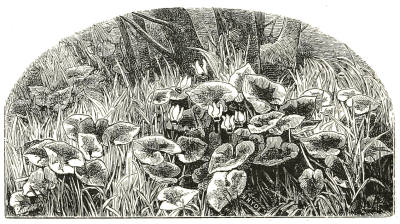
Cyclamens in the wild garden; from nature.
The Giant Sea–kale, Crambe.—“C. cordifolia is a very fine perennial, but its place is on the turf in rich soil. It has enormous leaves, and small whitish flowers in panicles. Here it is one of the finest ornaments in a wild garden of about five acres, associated with Rheums, Ferulas, Gunneras, Centaurea babylonica, Arundo Donax, Acanthus, and others.”
Bindweed, Calystegia.—Climbing plants, with handsome white or rosy flowers, often too vigorous in constitution to be agreeable in gardens, as is the case with our common bindweed. C. dahurica, somewhat larger than the common kind, is very handsome when allowed[135] to trail through shrubs, in rough places, or over stumps, rustic bridges, etc., and doubtless sundry other species will in time be found equally useful.
The pretty little Rosy Bindweed that one meets often upon the shores of the Mediterranean is here depicted at home in an English garden, creeping up the leaves of an Iris in Mr. Wilson’s garden at Heatherbank, Weybridge Heath. It is a great privilege we have of being able to grow the fair flowers of so many regions in our own, and without caring for them in the sense, and with the troubles that attend other living creatures in menageries, aviaries, etc. This is an advantage that we do not evidently consider when we put a few plants in lines and circles only, oblivious of the infinite beauty and variety of the rest. This beautiful pink Bindweed is the representative, so to speak, of our own Rosy Field Bindweed in the south, but nevertheless it is perfectly hardy and free in our own soils. Its botanical name is Convolvulus althæoides.ill135
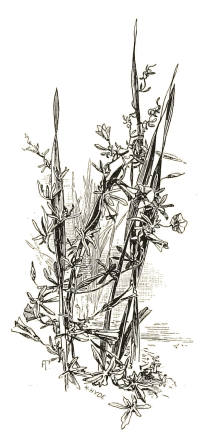
A South European Bindweed creeping up the stems of an Iris in an English garden.
Marsh Calla, Calla palustris.—A creeping Arum–like plant, with white flowers showing above a carpet of glossy leaves, admirable for naturalisation in muddy places, moist bogs, on the margins of ponds, etc.
Rosy Coronilla, Coronilla varia.—Europe. On grassy banks, stony heaps, rough rocky ground, spreading over slopes or any like positions. A very fine plant for naturalisation, thriving in any soil.
Giant Scabious, Cephalaria.—Allied to Scabious but seldom grown. They are worth a place in the wild garden for their fine vigour alone, and the numerous pale yellow flowers will be admired by those who do not limit their admiration to showy colours.
Coral–wort, Dentaria.—Very showy perennials, the purplish or white flowers of which present somewhat of the appearance of a stockflower, quite distinct both in habit and bloom, and very rarely seen[136] in our gardens; they will be found to thrive well and look well in peat soil beneath rhododendrons, and towards the margins of clumps of American shrubs.
Leopard’s Bane, Doronicum.—Stout, medium–sized, or dwarf perennials, with hardy and vigorous constitutions, and very showy flowers; well suited for naturalisation among herbaceous vegetation, in any position where the beauty of their early bloom can be enjoyed.
American Cowslip, Dodecatheon.—All who care for hardy flowers admire the beautiful American cowslip (D. Meadia), found in rich woods in Pennsylvania, Ohio, to Wisconsin and south–westward, in America. This would be a charming plant to naturalise on rich and light sandy loams, among dwarf herbs, low shrubs, etc., in sheltered and sunny spots. Jeffrey’s American cowslip (D. Jeffreyanum), a vigorous–growing kind, is also well worth a trial in this way, though as yet it is hardly plentiful enough to be spared for this purpose.
Fumitory, Fumaria, Dielytra.—Plants with graceful leaves and gay flowers suited for association with dwarf subjects on open banks, except D. spectabilis, which in deep peat or other rich soil will grow a yard high. The simple–looking little Fumaria bulbosa is one of the dwarf subjects which thrive very well under the branches of specimen deciduous trees, and Corydalis lutea thrives in every position from the top of an old castle to the bottom of a well shaft. I saw Dielytra eximia naturalised in Buckhurst Park, in a shrubbery, the position shady. Its effect was most charming, the plumy tufts being dotted all over with flowers. Had I before wished to naturalise this, I should have put it on open slopes, or among dwarf plants, but it thrives and spreads about with the greatest freedom in shady spots. The blossoms, instead of being of the usual crimson hue, were of a peculiar delicate pale rose, no doubt owing to the shade; and, as they gracefully drooped over the elegantly–cut leaves, they looked like snowdrops of a faint rosy hue.
Delphinium, Perennial species.—Tall and beautiful herbaceous plants, with flowers of many exquisite shades of blue and purple. There are now numerous varieties. They are well suited for rich soil in glades, copses, thin shrubberies, or among masses of dwarf shrubs, above which their fine spikes of bloom might here and there arise.
One of the prettiest effects which I have ever seen among naturalised plants was a colony of tall Larkspurs (Delphiniums). Portions of old roots of several species and varieties had been chopped off where a bed of these plants was being dug in the autumn. For convenience sake the refuse had been thrown into the neighbouring[137] shrubbery, far in among the shrubs and tall trees. Here they grew in certain half–open little spaces, which were so far removed from the margin that they were not dug and were not seen. When I saw the Larkspurs in flower they were certainly the loveliest things that one could see. They were more beautiful than they are in borders or beds, not growing in such close stiff tufts, and mingling with and relieved by the trees above and the shrubs around. Little more need be said to any one who knows and cares about such plants, and has an opportunity of planting in such neglected places. This case points out pretty clearly that one might make wild gardens from the mere parings and thinnings of the beds and borders in autumn, in any place where there is a collection of good hardy plants. The cut on p. 28 does scant justice to the scene, which, perhaps, it is not in the power of wood engraving to illustrate.
Pink, Dianthus.—A numerous race of beautiful dwarf mountain plants, with flowers mostly of various shades of rose, sometimes sporting into other colours in cultivation. The finer mountain kinds would be likely to thrive only on bare stony or rocky ground, and amidst very dwarf vegetation. The bright D. neglectus would thrive in any ordinary soil. Some of the kinds in the way of our own D. cæsius grow well on old walls and ruins, as do the single carnations and pinks; indeed, it is probable that many kinds of pink would thrive on ruins and old walls better far than on the ground.
Foxglove, Digitalis.—It need not be said here that our own stately Foxglove should be encouraged in the wild garden, particularly in districts where it does not naturally grow wild; I allude to it here to point out that there are a number of exotic species for which a place might be found in the wild garden—some of them are not very satisfactory otherwise. The most showy hardy flowers of midsummer are the Foxglove and the French willow (Epilobium angustifolium), and in wild or rough places in shrubberies, etc., their effect is beautiful. In such half shady places the Foxglove thrives best; and, as the French willow is much too rampant a plant for the garden proper, the proper place for it too is in the wild garden. It is a most showy plant, and masses of it may be seen great distances off. The delicately and curiously spotted varieties of the Foxglove should be sown as well as the ordinary wild form.
Hemp Agrimony, Eupatorium.—Vigorous perennials, with white or purple fringed flowers. Some of the American kinds might well be associated with our own wild one—the white kinds, like[138] aromaticum and ageratoides, being very beautiful and distinct, and well worthy of a place in the best parts of the wild garden.
Sea Holly, Eryngium.—Very distinct and noble–looking perennials, with ornamental and usually spiny leaves, and flowers in heads, sometimes surrounded by a bluish involucrum, and supported on stems of a fine amethystine blue. They would be very attractive on margins of shrubberies and near wood–walks, thrive in ordinary free soil, and will take care of themselves among tall grasses and all but the most vigorous herbs.
Heath, Erica, Menziesia.—Our own heathy places are pretty rich in this type, but the brilliant Erica carnea is so distinct and attractive that it well deserves naturalisation among them. The beautiful St. Daboec’s heath (Menziesia polifolia) deserves a trial in the same way, as, though found in the west of Ireland, it is to the majority of English gardens an exotic plant. It will grow almost anywhere in peaty soil.
Barren–wort, Epimedium.—Interesting and very distinct, but comparatively little known perennials, with pretty and usually delicately tinted flowers, and singular and ornamental foliage. They are most suitable for peaty or free moist soils, in sheltered positions, among low shrubs on rocky banks, etc., and near the eye. The variety called E. pinnatum elegans, when in deep peat soil, forms tufts of leaves nearly a yard high, and in spring is adorned with long racemes of pleasing yellow flowers, so that it is well worthy of naturalisation where the soil is suitable.ill138
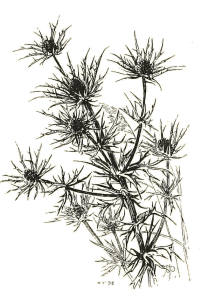
A Sea Holly; Eryngium.
Globe Thistle, Echinops.—Large and distinct perennials of fine port, from 3 feet to 6 feet high, with spiny leaves and numerous flowers in spherical heads. These will thrive well in almost any position, and hold their ground amid the coarsest vegetation. Being of a “type” quite distinct from that of our indigenous vegetation, they are more than usually suited for naturalisation. Echinops exaltatus and E. ruthenicus, are among the best kinds, the last the best in colour.
May–flower, Epigæa repens.—A small creeping shrub, with pretty and deliciously fragrant flowers, which appear soon after the melting[139] of the snow in N. America, and are there as welcome as the hawthorn with us. In its native country it inhabits woods, mostly in the shade of pines; and usually, wherever I saw it, it seemed to form a carpet under three or four layers of vegetation, so to speak—that is to say, it was beneath pines, medium–sized trees, tall bushes, and dwarf scrub about 18 in. high, while the plant itself was not more than one or two inches high. In our gardens this plant is very rarely seen, and even in the great American plant nurseries, where it used to grow it has disappeared. This is no wonder, when it is considered how very different are the conditions which it enjoys in gardens compared with those which I have above described. Without doubt it can be naturalised easily in pine woods on a sandy soil.
Dog’s–tooth Violet, Erythronium.—A few days ago I saw a number of irregular clumps of these here and there on a gently sloping bank of turf, and, in front of clumps of evergreens, they looked quite charming, and their dark spotted leaves showed up to much better effect on the fresh green Grass than they do in borders. They were all of the red variety, and required a few of the white form among them to make the picture perfect.
So writes a correspondent in Ireland. This beautiful plant, some years ago rarely seen in our gardens, adorns many a dreary slope in the Southern Alps, and there should be no great difficulty in the way of adding its charms to the wild garden in peaty or sandy spots, rather bare or under deciduous vegetation.
The Winter Aconite, Eranthis hyemalis.—Classed among British plants but really naturalised. Its golden buttons peeping through the moss and grass in snowdrop time form one of the prettiest aspects of our garden vegetation in spring. It will grow anywhere, and is one of the plants that thrive under the spreading branches of summer–leafing trees, as it blooms and perfects its leaves before the buds open on the beech. On many lawns, spring gardens might be formed by planting some spring flowering plants that finish their growth before the trees are in leaf. Another advantage of such positions is, that the foliage of the tree prevents any coarser plants taking possession of the ground, and therefore these little spring plants have the ground to themselves, and wander into natural little groups in the moss and grass, sometimes covering the surface with a sheet of blossoms.
Funkia.—I have spoken of the conditions in the wild garden being more suitable to many plants than those which obtain in what[140] might seem choice positions in borders, many of the plants attaining greater beauty and remaining longer in bloom in the shade and shelter of shrubby places than when fully exposed. As an instance of this, I saw Funkia cœrulea the other day, showing a size and beauty in a shady drive at Beauport, near Battle, which I never saw it attain under other circumstances. The plant was over a yard high, and bore many stately stems hung with blue flowers. The Funkias are exceedingly valuable plants for the wild garden, not being liable to accidents which are fatal to Lilies and other plants exposed to the attacks of slugs and rabbits.
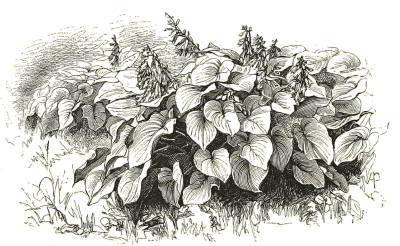
Groups of Funkia Sieboldi.
Snakes–head, Fritillaria.—The beautiful British snakes–head (F. Meleagris) grows wild, as most people know, in meadows in various parts of England, and we should like to see it as well established in the grassy hollows of many a country seat. Various other Fritillarias not so pretty as this, and of a peculiar livid dark hue, which is not like to make them popular in gardens, such as F. tristis, would be worthy of a position also; while the Crown Imperial would do on the fringes of shrubberies.
Giant Fennel, Ferula.—Noble herbaceous plants belonging to the parsley order, with much and exquisitely divided leaves; when well developed forming magnificent tufts of verdure, reminding one of the most finely–cut ferns, but far larger. The leaves appear very early in spring, and disappear at the end of summer, and the best use that can be made of the plants is to plant them here and there in places occupied by spring and early summer flowers, among which[141] they would produce a very fine effect. With the Ferulas might be grouped another handsome umbelliferous plant (Molopospermum cicutarium); and no doubt, when we know the ornamental qualities of the order better, we shall find sundry other charming plants of similar character.
Ferns.—No plants may be naturalised more successfully and with a more charming effect than ferns. The royal ferns, of which the bold foliage is reflected in the marsh waters of Northern America, will do well in the many places where our own royal fern thrives. The graceful maidenhair fern of the rich woods of the Eastern States and the Canadas will thrive perfectly in any cool, shady, narrow lane, or dyke, or in a shady wood. The small ferns that find a home on arid alpine cliffs may be established on old walls and ruins. Cheilanthes odora, which grows so freely on the sunny sides of walls in Southern France, would be well worth trying in similar positions in the south of England, the spores to be sown in mossy chinks of the walls. The climbing fern Lygodium palmatum, which goes as far north as cold Massachusetts, would twine its graceful stems up the undershrubs in an English wood too. In fact, there is no fern of the numbers that inhabit the northern regions of Europe, Asia, and America, that may not be tried with confidence in various positions, preferring for the greater number such positions as we know our native kinds to thrive best in. One could form a rich and stately type of wood–haunting fern vegetation without employing one of our native kinds at all, though, of course, generally the best way will be to associate all so far as their habits and sizes will permit. Treat them boldly; put strong kinds out in glades; imagine colonies of Daffodils among the Oak and Beech Ferns, fringed by early Aconite, in the spots overshadowed by the branches of deciduous trees. Then, again, many of these Ferns, the more delicate of them, could be used as the most graceful of carpets for bold beds or groups of flowering plants. They would form part, and a very important part, of what we have written of as evergreen herbaceous plants, and might well be associated with them in true winter gardens.ill141
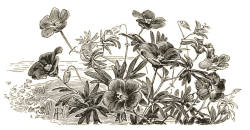
A hardy Geranium.
Geranium, Geranium, Erodium.—Handsome and[142] rather dwarf perennials, mostly with bluish, pinkish, or deep rose flowers, admirable for naturalisation. Some of the better kinds of the hardy geraniums, such as G. ibericum, are the very plants to take care of themselves on wild banks and similar places. With them might be associated the fine Erodium Manescavi; and where there are very bare places, on which they would not be overrun by coarser plants, the smaller Erodiums, such as E. romanum, might be tried with advantage.
Goat’s Rue, Galega.—Tall and vigorous but graceful perennials, with very numerous and handsome flowers, pink, blue, or white. G. officinalis and its white variety are among the very best of all tall border flowers, and they are equally useful for planting in rough and wild places, as is also the blue G. orientalis and G. biloba. They are all free growers.ill142
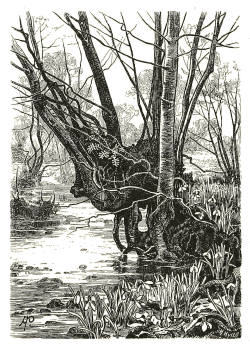
Snowdrops, wild, by streamlet in valley.
Gypsophila, Gypsophila and Tunica.—Vigorous but neat perennials, very hardy, and producing myriads of flowers, mostly small, and of a pale pinkish hue. They are best suited for rocky or sandy ground, or even old ruins, or any position where they will not be smothered by coarser vegetation. Similar in character is the pretty little Tunica saxifraga, which grows on the tops of old walls, etc., in Southern Europe, and will thrive on bare places on the level ground with us.
Gentian, Gentiana.—Dwarf, and usually evergreen, alpine or high–pasture plants, with large and numerous flowers, mostly handsome, and frequently of the most vivid and beautiful blue. The large G. acaulis[143] (Gentianella) would grow as freely in moist places on any of our own mountains as it does on its native hills; as, indeed, it would in all moist loams, where it could not be choked by coarse and taller subjects. The tall willow Gentian (G. asclepiadea) is a handsome plant, which, in the mountain woods of Switzerland, may be seen blooming among long grass in shade of trees, and this fact is suggestive as to its use in this country.
Snowdrops, Galanthus.—The charms of our own Snowdrop when naturalised in the grass are well known to all, but many of the new kinds have claims also in that respect, such as Elwesi and G. plicatus. It is surprising how comparatively few people take advantage of the facility with which the Snowdrop grows in grass, so as to have it in pretty groups and colonies by grass–walks or drives. The accompanying illustration, which shows it on the margin of a streamlet in a Somersetshire valley, shows that it is not particular as to situation. It suggests the many places it may adorn other than the garden border.
Cow Parsnips, Heracleum.—Giant herbaceous plants, mostly from Northern Asia, with huge divided leaves, and umbels (sometimes a foot across) of white or whitish flowers. They are very suitable for rough places on the banks of rivers or artificial water, islands, or in any position in which a very vigorous and bold type of foliage may be desired. In arranging them it should be borne in mind that their foliage dies down and disappears in the end of summer. When established they sow themselves, so that seedling plants in abundance may be picked up around them. In all cases it is important that their seed should be sown immediately after being gathered. But it is also important not to allow them to monopolise the ground, as then they become objectionable. To this end it may, in certain positions, be desirable to prevent them seeding.
Day Lily, Hemerocallis.—Vigorous plants of the lily order, with long leaves and graceful habit, and large and showy red–orange or yellow flowers, sometimes scented as delicately as the primrose. There are two types, one large and strong like flava and fulva, the other short and somewhat fragile like graminea. The larger kinds are superb plants for naturalisation, growing in any soil, and taking care of themselves among coarse herbaceous plants or brambles.
Christmas Rose, Helleborus.—Stout but dwarf perennials, with showy blooms appearing in winter and spring when flowers are rare, and with handsome leathery and glossy leaves. They thrive in almost[144] any position or soil; but to get the full benefit of their early–blooming tendency it is desirable to place them on sunny grassy banks in tufts or groups, and not far from the eye, as they are usually of unobtrusive colours. They form beautiful ornaments near wild wood walks, where the spring sun can reach them. There are various kinds useful for naturalisation.ill144
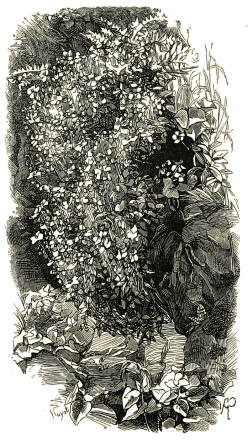
Sun Rose on limestone rocks.
Sun Rose, Helianthemum.—Dwarf spreading shrubs, bearing myriads of flowers in a variety of showy colours. The most tasteful and satisfactory way of employing these in our gardens is to naturalise them on banks or slopes in the half–wild parts of our pleasure–grounds, mostly in sandy or warm soil. They are best suited for chalk districts or rocky ones, where they thrive most luxuriantly, and make a very brilliant display. There are many varieties, mostly differing in the hue of the flowers.
Perennial Sunflower, Helianthus, Rudbeckia, Silphium.—Stout and usually very tall perennials, with showy yellow flowers, the best known of which is Helianthus multiflorus fl. pl., of which plenty may be seen in Euston Square and other places in London. As a rule these are all better fitted for rough places than for gardens, where, like many other plants mentioned in these pages, they will tend to form a vigorous herbaceous covert. H. rigidus is a brilliantly showy plant, running very freely at the root, and an excellent subject for naturalisation. H. giganteus, common in thickets and swamps in America, and growing as high as 10 ft., is also desirable. The showy and larger American Rudbeckias, such as laciniata, triloba, and also the small but showy hirta, virtually belong to the same type. All these plants, and many others of the tall yellow–flowered composites that[145] one sees conspicuous among herbaceous vegetation in America, would produce very showy effects in autumn, and might perhaps more particularly interest those who only visit their country seats at that time of year. The Silphiums, especially the compass plant (S. laciniatum), and the cup plant (S. perfoliatum), are allied in general aspect and character to the Helianthuses, and are suitable for the same purposes.
St. John’s Wort, Hypericum.—The well–known St. John’s wort has already in many places made good its claim as a wilderness plant, and there is scarcely one of its numerous congeners which will not thrive in wild and rough places, in any soil. They have all the same bright yellow flowers as the St. John’s wort, and are nearly all taller. Some of the newer kinds have the handsome large flowers of the St. John’s Wort. It should be noted that the common St. John’s Wort so exhausts the soil of moisture that it may be the cause of the death of trees, and should therefore be looked after. Many places have too much of it, as they have of the common Laurel.
Rocket, Hesperis.—The common single Rocket (Hesperis matronalis) is a showy useful plant in copse or shrubbery, and very easily raised from seed.
Evergreen Candytuft, Iberis.—Compact little evergreens, forming spreading bushes from 3 inches to 15 inches high, and sheeted with white flowers in spring and early summer. There are no plants more suitable for naturalisation in open or bare places, or, indeed, in any position where the vegetation is not strong enough to overrun them. They, however, attain greatest perfection when fully exposed to the sun, and are admirable for every kind of rocky or stony ground and banks.
Iris, Fleur de Lis.—These plants, once so well known in our gardens, rivalling (or rather exceeding) the lilies in beauty, are varied and numerous enough to make a wild garden by themselves. The many beautiful varieties of germanica will grow in almost any soil, and may be used with good effect in woods, copses, by wood walks, or near the margin of water. I. sibirica, rather a common kind, will grow in the water; and, as this is not generally known, it is worthy the notice of any one taking an interest in aquatics. It is probable that others of the beardless kinds will also do well with their roots below the water, and if so, they will one day much improve the rather poorly adorned margins of artificial waters. On the other hand, I. pumila, and the varieties of germanica, are often seen on the tops of old walls, on[146] thatched roofs, etc., on the Continent, flowering profusely. These facts tend to show how many different positions may be adorned by the irises.ill146
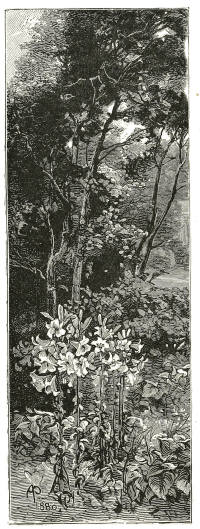
Common Lupine, Lupinus polyphyllus.—Amidst the tallest and handsomest herbaceous plants, grouped where they may be seen from grass drives or wood walks, or in any position or soil. Excellent for islets or river banks, in which, or in copses, it spreads freely. There are several varieties, all worthy of culture.
Honesty, Lunaria.—This, which approaches the Stocks in the aspect of its fine purplish violet flowers, is quite removed from them by the appearance of its curious seed–vessels. It is one of the most valuable of all plants for naturalisation, and may be said to form a type by itself. It shows itself freely in dryish ground or on chalk banks, and is one of the prettiest objects to be met with in early summer in wood or wild.
Lily, Lilium.—There are many hardy lilies that may be naturalised. The situations that these grow in, from the high meadows of Northern Italy, dotted with the orange lily, to the woody gorges of the Sierras in California, rich with tall and fragrant kinds, are such as make their culture in copses, woods, rough grassy places, etc., a certainty. In woods where there is a rich deposit of vegetable matter the great American Lilium superbum, and no doubt some of the recently–discovered Californian lilies, will do well. The European lilies, dotted in the grass in the rough unmown glades, would not grow nearly so large as they do in the rich borders of our cottage gardens;[147] but the effect of the single large blooms of the orange lily just level with the tops of the grass, in early summer, where it grows wild, is at least as beautiful as any aspect it has hitherto presented in gardens. Along the bed of small rivulets, in the bottom of narrow gorges densely shaded by great Thujas, Arbutus trees sixty and even eighty feet high, and handsome large–leaved evergreen oaks on the Sierras, I saw in autumn numbers of lily stems seven, eight, and nine feet high, so one could imagine what pictures they formed in early summer; therefore deep dykes and narrow shady lanes would afford congenial homes for various fine species. No mode of cultivating lilies in gardens is equal to that of dotting them through beds of rhododendrons and other American plants usually planted in peat; the soil of these, usually and very unwisely left to the rhododendrons alone, being peculiarly suited to the majority of the lily tribe. As for the wild garden, Mr. G. F. Wilson sent me a stem of Lilium superbum last year (1880) grown in a rich woody bottom, 11½ feet high!
Snowflake, Leucojum.—I have rarely seen anything more beautiful than a colony of the summer Snowflake on the margin of a tuft of rhododendrons in the gardens at Longleat. Some of the flowers were on stems nearly 3 feet high, the partial shelter of the bushes and good soil causing the plants to be unusually vigorous. Both the spring and summer Snowflakes (L. vernum and L. æstivum) are valuable plants for wild grassy places.
Gentian Lithosperm, Lithospermum prostratum.—A very distinct, prostrate, hairy, half–shrubby plant, with a profusion of flowers of as fine a blue as any gentian. Thrives vigorously in any deep sandy soil, and in such well deserves naturalisation among low rock plants, etc., in sunny positions. Probably other species of the genus will be found suitable for the same purpose.
Lychnis.—Handsome medium–sized perennials, with showy blooms, mostly of a brilliant rose or scarlet colour. If the type was only represented by the rose campion it would be a valuable one. This is a beautiful object in dry soils, on which it does not perish in winter. They are most fitted for association with dwarf or medium–sized perennials, in open places and in rich soil.
Honeysuckle, Lonicera.—Such favourites as these must not be omitted. Any kind of climbing Honeysuckle will find a happy home in the wild garden, either rambling over stumps or hedgerows, or even planted by themselves on banks.
Pea, Lathyrus.—Much having been lately written concerning the[148] wild garden and its suitable occupants, I venture to suggest Lathyrus pyrenaicus as an addition to the list. Most cultivators of flowers are aware of the rambling habits of the greater number of plants of the Leguminous tribe, but in that particular L. pyrenaicus eclipses them all. It produces an immense quantity of bright orange–coloured blossoms, but the principal difficulty connected with its thorough development is the selection of an appropriate place for it, for a well–established plant of this species will ramble over, and by its density of growth prevent every plant and shrub that comes within its reach from thriving; indeed, it is a greater rambler than the Hop, the Bindweed, or the Bryony, and is decidedly more handsome. Tying up or training such a plant is out of the question; but there are many rough places in the wild garden where it would be quite at home and form an attractive feature. Every kind of Everlasting Pea is excellent for the wild garden, either for scrambling over hedgerows, stumps, or growing among the grass.—J. W.ill148
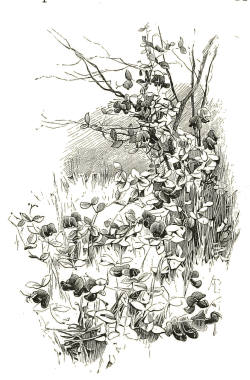
Everlasting Pea, creeping up stem in shrubbery.
Monkey–flower, Mimulus.—“Wandering one day in the neighbourhood of “Gruigfoot,” a queer–shaped hill in Linlithgowshire, my eye was attracted by a small burn whose banks were literally jewelled throughout its visible course with an unfamiliar yellow flower. A nearer approach showed me that it was the garden Mimulus (Monkey–flower), the seed of which must have escaped from some neighbouring cottage garden, and established itself here, in the coldest part of the British Isles. I took the hint, and have naturalised it by the banks of a small stream which runs at the foot of my garden, and I strongly recommend your readers to do the same. It mingles charmingly with the blue Forget–me–not, and is equally hardy.”—S. in Garden.
Grape Hyacinth, Muscari.—These free and hardy little bulbs[149] are easily naturalised and very handsome, with their little spikes of flowers of many shades of blue.
Forget–me–not, Myosotis.—There is one exotic species, M. dissitiflora, not inferior in beauty to any of our handsomest native kinds, and which is well worthy of naturalisation everywhere, thriving best on moist and sandy soil.ill149
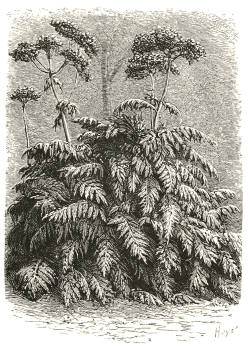
Type of fine–leaved umbellate plants seldom grown in gardens.
Molopospermum cicutarium.—There is a deep green and fern–like beauty displayed profusely by some of the Umbelliferous family, but I have rarely met with one so remarkably attractive as this species. It is a very ornamental plant, with large, deeply–divided leaves of a lively green colour, forming a dense irregular bush. The flowers, which are insignificant and of a yellowish–white colour, are borne in small roundish umbels. Many of the class, while very elegant, perish quickly, get shabby indeed by the end of June, and are therefore out of place in the flower garden; but this is firm in character, of a fine rich green, stout yet spreading in habit, growing more than 3 feet high, and making altogether a most pleasing bush. It is perfectly hardy, and easily increased by seed or division, but rare as yet. It loves a deep moist soil, but will thrive in any good garden soil. It is a fine subject for isolation or grouping with other hardy and graceful–leaved Umbelliferous plants.
Stock, Matthiola.—Showy flowers, mostly fragrant, peculiarly well suited for old ruins, chalk pits, stony banks, etc. Some of the annual[150] kinds are pretty, and some of the varieties common in gardens assume a bush–like character when grown in the positions above named. With the Stocks may be associated the single rocket (Hesperis matronalis), which thrives freely in shrubberies and copses.
Bee Balm, Monarda.—Large and very showy herbaceous plants, with scarlet or purple flowers, conspicuously beautiful in American and Canadian woods, and capital subjects for naturalisation in woods, copses, etc., or anywhere among medium–sized vegetation, thriving best in light or well–drained soils.ill150
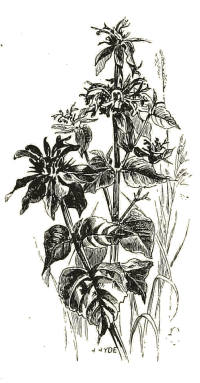
The Bee Balm, Monarda. American wood plant.
Mallow, Malva, Althœa, Malope, Kitaibelia, Callirhoe, Sida.—Plants of several distinct genera may be included under this type, and from each very showy and useful things may be obtained. They are for the most part subjects which are somewhat too coarse, when closely examined, to be planted in gardens generally; but among the taller vegetation in wild shrubberies, copses, glades in woods, etc., they will furnish a magnificent effect. Some of the Malvas are very showy, vigorous–growing plants, mostly with rosy flowers, and would associate well with our own handsome M. moschata. The Althæas, close allies of the common single hollyhock, are very vigorous and fine for this purpose, as are also the Sidas and Kitaibelia vitifolia. The Malopes are among the best of the annual subjects for naturalisation. The Callirhoes are dwarf, handsome trailers, more brilliant than the others, and the only ones of the type that should be planted on bare banks or amidst dwarf vegetation, as all the others are of the most rampant character.
Mulgedium Plumieri.—A herbaceous plant of fine and distinct port, bearing purplish–blue blossoms, rather uncommon among its kind. Till recently it was generally only seen in botanic gardens, but it has, nevertheless, many merits as a wild garden plant, and for growing in small groups or single specimens in quiet green corners of pleasure–grounds or shrubberies. It does best in rather rich ground, and in such a position will reward all who plant it, being a really hardy and long–lived perennial. The foliage is sometimes over a yard long, and the flower–stems attain a height of over six feet in good soil.
Water Lily, Nymphœa and Nuphar.—Two noble North American plants well deserve naturalisation in our waters, associated with our own beautiful white and yellow water lilies—the large Nuphar advena, which thrusts its great leaves well out of the water in many parts of North America, and the sweet–scented Nymphæa odorata, which floats in crowds on many of the pine–bordered lakes and lakelets of New England, to a non–botanical observer seeming very like our own water lily.
Daffodil, Narcissus.—Most people have seen the common daffodil in a semi–wild state in our woods and copses. Apart from varieties, there are more than a score distinct species of daffodil that could be naturalised quite as easily as this in all parts of these islands. We need hardly suggest how charming these would be, flowering in early spring and summer in the rougher parts of pleasure grounds, or along wood–walks, or any like position.
Bitter Vetch, Orobus.—Banks, grassy unmown margins of wood–walks, rocks, fringes of shrubberies, and like places, with deep and sandy loam, well drained, will grow the beautiful spring Bitter Vetch or any of its varieties or allies perfectly.
Evening Primrose, Enothera.—Among the largest–flowered and handsomest of all known types of herbaceous vegetation. The yellow species, and varieties like and allied to the common Evening Primrose (Œ. biennis), may be readily naturalised in any position, from a rubbish–heap to a nice, open, sunny copse; while such prostrate ones as Œ. marginata and Œ. macrocarpa will prove very fine among dwarf herbs on banks or in open sunny places, in light or calcareous soil. These noble and delicately–scented flowers are very easily grown and very beautiful in any position. They, however, from their height and boldness, and the freedom with which they grow in almost any soil, are peculiarly suited for the wild garden, for shrubberies, copses, and the like, sowing themselves freely.
Cotton Thistle, Onopordon.—Large thistles, with very handsome hoary and silvery leaves, and purplish flowers on fiercely–armed stems. No plants are more noble in port than these, and they thrive freely in rough open places, rubbish–heaps, etc., and usually come up freely from self–sown seeds.
Star of Bethlehem, Ornithogalum.—Various handsome hardy species of this genus will thrive as well as the common Star of Bethlehem in any sunny, grassy places.
Creeping Forget–me–not, Omphalodes.—The creeping Forget–me–not,[152] Omphalodes verna, is one of the prettiest plants to be naturalised in woods, copses, or shrubberies, running about with the greatest freedom in moist soil. It is more compact in habit and lives longer on good soils than the Forget–me–nots, and should be naturalised round every country place.
Wood Sorrel, Oxalis.—Dwarf plants with clover–like leaflets and pretty rosy or yellow flowers. At least two of the species in cultivation, viz. O. Bowieana and O. floribunda, might be naturalised on sandy soils amidst vegetation not more than 5 inches or 6 inches high; and the family is so numerous that probably other members of it will be found equally free growing.
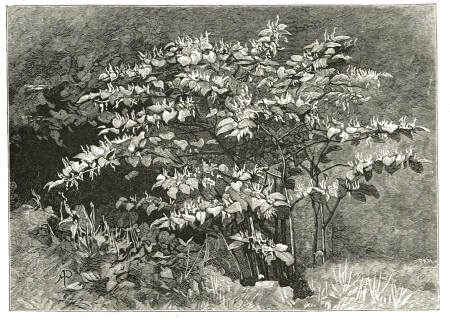
The Great Japan Knotweed (Polygonum cuspidatum).
(Showing the plant in flower.)
Polygonum cuspidatum.—If, instead of the formal character of much of our gardening, plants of bold types similar to the above were introduced along the sides of woodland walks and shrubbery borders, how much more enjoyable such places would be, as at almost every step there would be something fresh to attract notice and gratify the eye, instead of which such parts are generally bare, or given up to weeds and monotonous rubbish.
Pæony.—Vigorous herbaceous plants, with large and splendid flowers of various shades of crimson, rosy–crimson, and white, well calculated for producing the finest effects in the wild garden. There are many species and varieties, the flowers of some of the varieties being very sweet–scented, double, and among the largest flowers we know of. Fringes of shrubberies, open glades in woods or copses, and indeed almost any wild place, may be adorned by them; and they may also be advantageously grouped or isolated on the grass in the rougher parts of the pleasure–ground. I never felt the beauty of the fine colour of Pæonies till I saw a group of the double scarlet kind flowering in the long Grass in Oxfordshire. The owner had placed an irregular group of this plant in an unmown glade, quite away from the garden proper; and yet, seen from the lawn and garden, the effect was most brilliant, as may be imagined from the way in which such high colours tell in the distance. To be able to produce such effects in the early summer for six weeks or so is a great gain from a landscape point of view, apart from the immediate beauty of the flowers when seen close at hand.ill153
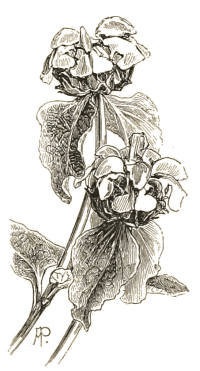
Phlomis.—Type of handsome Labiates; admirably suited for the wild garden. (See p. 154.)
Poppy, Papaver, in var.—The huge and flaming Papaver orientale, P. bracteatum, and P. lateritium, are the most important of this type. They will thrive and live long in almost any position, but the proper place for them is in open spots among strong herbaceous plants. For the wild garden or wilderness the Welsh Poppy (Meconopsis cambrica) is one of the best plants. It is a cheerful plant at all seasons; perched on some old dry wall its masses of foliage are very fresh, but when loaded with a profusion of large yellow blossoms the plant is strikingly handsome; it is a determined coloniser, ready to hold its own under the most adverse circumstances. Its home is the wall, the rock, and the ruin. It even surpasses the Wallflower in adapting itself to strange out–of–the–way places; it will spring up in the gravel walk under one’s feet, and seems quite happy among the boulders in the courtyard. It looks down on one from crevices in brick walls, from chinks where one could scarcely introduce a knife–blade, and after all it delights most in shady places. No plant can be better adapted for naturalising on rough stony banks, old quarries, gravel pits, dead walls, and similar places, and[154] its large handsome flowers will lend a charm to the most uninteresting situations.
Phlomis.—Showy and stately herbaceous or half–shrubby plants, with a profusion of handsome yellow or purplish flowers. Excellent for naturalisation in warm open woods, copses, banks, etc., growing well in ordinary soil.ill154

The tall Ox–eye Daisy (Pyrethrum serotinum).
Virginian Poke, Phytolacca decandra.—A tall, robust perennial, within conspicuous flowers and long dense spikes of purplish berries. It will grow anywhere and in any soil; but is most imposing in rich deep ones. The berries are relished by birds. It is fine for association with the largest and stoutest herbaceous plants in rough and half–wild places.
Physostegia.—Tall, erect, and beautiful herbaceous plants, mostly with delicate rosy flowers; natives of North America, thriving in any soil. They are among the most pleasing things for planting in half–wild places, where they will not spread rampantly, nor perish quickly.
Lungwort, Pulmonaria.—Dwarf plants of the borage family, with showy blue or pinkish blossoms. Easily naturalised in woods or copses, in which position the common blue one must be familiar to many in the woods of England and France. The varieties are common in cottage gardens; they grow in any soil.
The tall Ox–eye daisy, Pyrethrum serotinum.—This fine autumn flowering plant, for years left in the almost exclusive possession of the Botanic Gardens, is one of the handsomest things we have. It grows 5 or 6 feet high, and flowers late in the year, when flowers are scarce. It is very picturesque in habit.
Bramble, Rubus.—Although we have nearly fifty kinds or reputed kinds of bramble native in Britain, some of the exotic species, entirely distinct from our own, are well worthy of naturalisation among low shrubs and tall herbaceous plants. One of the most charming plants we know for naturalising in shady woods is the large, white–flowered Rubus Nutkanus, with which might be tastefully associated the deep rose–coloured Rubus odoratus, and the early spring–flowering R. spectabilis; while the very striking white–stemmed R. biflorus is a grand object for warm slopes, sunny sides of chalk and gravel pits, etc.
The Great Reed; Arundo Donax.—This noble reed I do not like to omit here, it is so beautiful in the southern counties of England, though in cold soils and hard winters it may perish. Where the hardier Bamboos find a place this will be welcome, though in our country it is only in the warmer parts that it attains the dignity of port it possesses in the south of Europe.ill155

The Great Reed of Southern Europe (Arundo Donax).
Rhubarb, Rheum.—There are several species of rhubarb in cultivation in addition to those commonly grown in gardens. They are much alike in port and in the size of their leaves, R. palmatum and Emodi being the most distinct. The rhubarbs are fine things for association with large–leaved herbaceous plants in deep soils.
Rose, Rosa.—As in the case of brambles, we have many more kinds of wild roses in England than is commonly supposed, but of course nobody ever thinks of planting such things in gardens or shrubberies, where such gems as privet[156] usually make up the underwood. There are scores of the roses of northern and temperate countries which would thrive as well in our woodlands; but as these are not to be obtained in our nurseries, it is useless to mention them. Any species of rose from a northern country might be tried; whilst of roses commonly cultivated the climbing races—such as the Boursault, Ayrshire, and Sempervirens—are the most likely to be satisfactory. The Damask, Alba gallica, and hybrid China, being hardy and free, would do, as would Felicité Perpetuelle, Banksiæflora, the Garland roses, Austrian briar, berberifolia, and microphylla rubra plena. Pruning, or any other attention after planting, should of course not be thought of in connection with these. We have seen masses of wild roses the effect of which was finer than anything we have ever seen in a rosery. Rosa Brunoniana is a very fine free and hardy species from India.
Sea Lavender, Statice.—Vigorous perennials, with a profusion of bluish lavender–coloured bloom, thriving freely on all ordinary garden soils. S. latifolia, and some of the stronger kinds, thrive in any position among the medium–sized herbaceous plants.
Spiræa, Spiræa.—Handsome and usually vigorous herbaceous plants, with white or rosy flowers, and generally ornamental foliage. Such beautiful kinds as venusta and palmata it is most desirable to try in wild places among the stouter and medium–sized perennials, where sufficiently plentiful to be spared for this purpose. S. Aruncus is, perhaps, the finest plant for the wild garden. Mr. Ellam planted out some spare stock of S. japonica in a wood at Bodorgan, and with the happiest effect. The plants grow and flower freely, the flowers appearing a fortnight later in the moist cool wood than on plants of the same kind on a north garden border; therefore they prolong the season of this favourite flower. They are planted in an irregular group, as such things should generally be, the effect being much better than that obtained by the common dotting plan.
Golden Rod, Solidago.—Tall and vigorous perennials with yellow flowers, showy when in bloom, and attractive when seen in America in autumn, mingled with the blue and lilac Asters of that country, but rarely ornamental as grown in gardens. These, like the Asters, used to be grown to excess in the old borders; but the only position they are fit for is in rough wild places, where in many cases it would be easy, with their aid and that of the Asters, to form that mixture of Golden Rod and Michaelmas daisies which is one of the prettiest effects of American vegetation in autumn.
Catch–fly, Silene.—Dwarf or spreading plants, allied to the pinks, and generally with white or rosy flowers. The choice mountain kinds, such as S. Lagascæ, alpestris, Schafta, etc., are among the most charming subjects that can be naturalised on rocky places or banks, associated with very dwarf subjects. Such fine annual or biennial kinds as S. Armeria or S. pendula are among the best for this purpose, and might be easily established by scattering a few seeds in such places.
Bloodwort, Sanguinaria canadensis.—This little plant, which abounds in the woods of Canada and North America, and which is very rarely indeed seen well grown in our gardens, will thrive under the branches of deciduous trees as well as the winter aconite, and in spring will produce an effect as beautiful as singular.
Squill, Scilla.—Several kinds of Scilla, closely allied to the common bluebell, would do quite as well in our woods as that well–known native plant, notably S. campanulata, S. bifolia, S. sibirica, etc. Bifolia and sibirica would be better on sunny banks or sheltered fringes of shrubberies with a good aspect. The tall kinds would do in woods or copses like the bluebell. With the dwarfer squills might be associated the grape hyacinth and the amethyst hyacinth (Hyacinthus amethystinus).
Comfrey, Symphytum.—Herbaceous plants of the borage order, usually vigorous, and with handsome blue flowers. One of the handsomest spring flowers is Symphytum caucasicum, and it is also one of the easiest things to naturalise, running about with the greatest freedom in shrubby or any wild places. Coarse kinds, like S. asperrimum (unfit for garden culture), thrive apace among the largest plants in wild places, and there look quite beautiful when in flower.
Scabious, Scabiosa, Cephalaria, Knautia.—Sometimes handsome and usually free–growing herbaceous plants, bluish, purplish, or yellowish in tone. Among these may be seen, in botanic and other gardens, plants suited for naturalisation, but scarcely worthy of a place in the garden. The fine S. caucasica would thrive amidst coarse vegetation in good soil, as would the Knautias.
Stonecrop, Sedum.—Minute and usually prostrate plants, mostly with white, yellow, or rosy flowers, and occurring in multitudes on most of the mountain chains of northern and temperate countries. There are few of these interesting and sometimes very pretty plants that would not grow on the top of an old wall, or thatched house, or stony bank, or bare ground, as well as our common Stonecrop. All grow in any soil, are as easily increased as any weed, and grow anywhere[158] if they are not too much overshadowed by trees and coarse vegetation. Such kinds as S. spurium, S. pulchellum, kamtschaticum, and S. spectabile are among the most ornamental. The last, being a stout herbaceous plant, would be worth associating with such in wild places. There are nearly 100 species of stonecrop in cultivation in Britain.
Saxifrage, Saxifraga.—A very extensive genus of plants, abundantly distributed on mountains in northern countries. For our present purpose they may be broadly thrown into five sections—the mossy section, represented in Britain by S. hypnoides; the silvery section, represented by S. Aizoon; the London Pride section, by the Kerry saxifrages; the Megasea section, by the large cabbage–leaved S. crassifolia; and the oppositifolia section, distinguished by its rosy–purple flowers. With the exception of the Megasea and oppositifolia sections, which have rosy flowers, most of the saxifrages have white blossoms spotted with red; a few are yellow, and all are very hardy, and the easiest to grow of all alpine flowers. The mossy, silvery, and purple saxifrages may be naturalised with the greatest ease on bare rocky or mountainous grounds, amidst dwarf vegetation; but, as the places in which this kind of ground occurs are comparatively few, the Megaseas, and the Kerry saxifrages, are probably the most generally useful, as they can fight their way amongst coarse grass and other common herbs. There are probably nearly 150 species in cultivation in the botanic gardens of England, though in many private gardens they are very little known.
Houseleek, Sempervivum.—Very dwarf and succulent plants, with their fleshy leaves arranged in dense rosettes, and mostly with curious but seldom conspicuous flowers, abounding in mountainous regions, and very hardy. The greater number of these grow quite as freely as the common Houseleek in any arid soil, and in any position where the vegetation is not taller than themselves, such as on bare sandy banks, gravelly heaps, etc. There are about fifty hardy kinds in cultivation in the gardens in this country.
Meadow Rue, Thalictrum.—Tall and vigorous herbaceous plants, mostly without any beauty of flower when closely examined, but often affording a pleasing distant effect when seen in masses, and hence desirable for this mode of gardening, though seldom suitable for a position in the garden proper. They grow in any soil, and should be placed among rank herbs and coarse vegetation, not in the foreground, which might be occupied by more brilliant subjects. There are many kinds not differing much in aspect; some of the smaller ones[159] in the way of our own British T. minus, deserve a place among dwarf vegetation for the elegance of their leaves. With these last may be associated the Italian Isopyrum thalictroides, which is handsome in flower and elegant in leaf.
Spiderwort, Tradescantia virginica.—A handsome and distinct North American perennial, with purple, blue, or white flowers, attaining a height of 1½ feet or 2 feet. An admirable subject for naturalisation on almost any soil, thriving perfectly on the wettest and coldest, and therefore suited for many places where other perennials would make little progress.
Wood Lily, Trillium.—Very singular and beautiful American wood plants, of which T. grandiflorum is worthy of special attention, thriving in shady places in moist rich soils, in woods and copses, where some vegetable soil has gathered.ill159
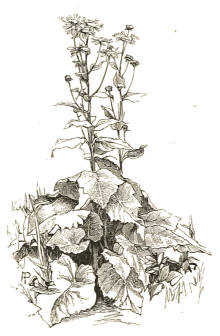
Telekia. Type of the Larger Composites excluded from gardens proper.
Globe Flower, Trollius.—Beautiful plants of vigorous habit, with large handsome flowers, of a fine golden colour, like those of the buttercups, but turning inwards so as to form an almost round blossom, quite distinct in aspect. Few subjects are more worthy of a position in grassy glades where the soil is rich, although they will grow in ordinary soil. There are several distinct kinds suitable, though there is little difference in their appearance.
Tulip, Tulipa.—Various kinds of Tulips might be naturalised with advantage by wood walks and in the rougher parts of the pleasure grounds. In such positions they would not attain such a size as the richly–fed garden flowers, but that would make them none the less attractive to those who care about the wild garden.
Telekia, Telekia cordifolia.—A vigorous herbaceous plant, suited for association with Echinops, Rheum, and subjects grown for their foliage and character. It is very free in growth, and has large foliage and sunflower–like flowers.
Flame–Flower, Tritoma.—Flame Flowers are occasionally planted in excess, so as to neutralise the good effect they might otherwise produce, and they, like many other flowers, have suffered from being, like soldiers, put in straight lines and in other geometrical formations. It is only where a fine plant or group of plants is seen in some green glade that the true beauty of the Flame Flower is seen, especially at some little distance off. Although not exactly belonging to the very free–growing and extremely hardy genera of plants recommended for the wild garden, they are so free in many soils that they might with confidence be recommended for that purpose, and our sketch shows a picturesque group of them planted in this way. It would be delightful if people having country seats would study more the effects to be realised from certain types of plants. For instance, a well and tastefully placed group of these Flame Flowers would for a long time in autumn be a most effective feature in the landscape of a country seat; and there are various other plants to which the same remark applies, though perhaps to none better than these in the later months of the year.
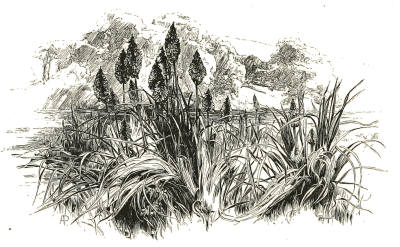
Group of Tritoma, in grass.
Showy Indian Cress, Tropæolum speciosum.—Against terrace walls, among shrubs, and on slopes, on banks, or bushy rockwork near the hardy fernery; in deep, rich, and light soil. This is a brilliant plant, well worth any trouble to establish. Many fail to establish it in[161] the garden proper, but moist, shady, and bushy places, will suit it better.ill161
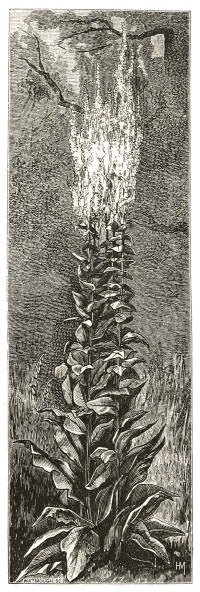
A tall Mullein.
Mullein, Verbascum.—Verbascum vernale is a noble plant, which has been slowly spreading in our collections of hardy plants for some years past, and it is a plant of peculiar merit. I first saw it in the Garden of Plants, and brought home some roots which gave rise to the stock now in our gardens. Its peculiarities, or rather its merits, are that it is a true perennial species—at least on the warm soils, and in this respect quite unlike other Mulleins which are sometimes seen in our gardens, and oftener in our hedgerows. It also has the advantage of great height, growing, as in the specimen shown in our illustration, to a height of about 10 feet, or even more. Then there are the large and green leaves, which come up rather early and are extremely effective. Finally, the colour is good and the quantity of yellow flowers with purplish filaments that are borne on one of these great branching panicles is something enormous. The use of such a plant cannot be difficult to define, it being so good in form and so distinct in habit. For the back part of a mixed border, for grouping with other plants of remarkable size or form of foliage, or for placing here and there in open spaces among shrubs, it is well suited. A bold group of it, arranged on the Grass by itself, in deep, light, and well–dressed soil, would be effective in a picturesque garden. It is also known in gardens by the name of Verbascum Chaixii, which name, we believe, was given to it at Kew.
Periwinkle, Vinca.—Trailing plants, with glossy foliage and handsome blue flowers, well known in gardens. They are admirable plants for naturalisation, growing in any position, shady or sunny.[162] There are variously–coloured and very pretty varieties of V. minor, while the variegated forms of both species are handsome, and may be naturalised like the green kinds.
Speedwell, Veronica.—Herbaceous plants, usually rather tall (1½ feet to 3 feet), in some cases dwarf and neat alpine plants with blue flowers in various shades; are among the hardiest of plants, and will grow in any soil. All the taller kinds are admirably suited for naturalisation among long grass and other herbaceous vegetation. A great number that are in cultivation in borders are only fit for this purpose. The dwarf kinds are equally suitable for bare places, or among other dwarf plants.
Violet, Viola.—A numerous race of dwarf and interesting plants, thriving freely in our climate, in half–shady places, rocky spots or banks, fringes of shrubberies, or almost any position. The very handsome bird’s–foot violet of N. America (V. pedata) would thrive in sandy level places or on rocky banks. In this family occur a good many kinds, such as V. canadensis, which, not being fragrant, or not possessing sufficient charms to ensure their general cultivation in gardens, are peculiarly suited for this sort of gardening. Our own sweet violet should be abundantly naturalised wherever it does not occur in a wild state.
Adam’s–Needle, Yucca.—Although these scarcely come into this selection, yet their fine habit and their hardiness give them a charm for us even in a wild garden. A legitimate aim, on the part of any one carrying out this to any extent, would be to try and develop a sub–tropical aspect of vegetation in certain places. In such a case the Yuccas could not be dispensed with. The free–flowering kinds (Y. flaccida and Y. filamentosa) should not be omitted, as they are more likely to spread and increase than the larger ones; all such plants are better held together in groups.
CHAPTER XV.
SELECTIONS OF HARDY EXOTIC PLANTS FOR VARIOUS POSITIONS
IN THE WILD GARDEN.
ill163
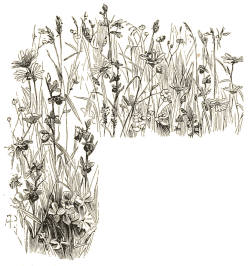
Ophrys in grass.
As it is desirable to know how to procure as well as how to select the best kinds, a few words on the first subject may not be amiss here.
A very important point is the getting of a stock of plants to begin with. In country or other places where many good old border flowers remain in the cottage gardens, many species may be collected therein. A series of nursery beds should be formed in some by–place in which such subjects could be increased to any desired degree. Free–growing spring–flowers like Aubrietia, Alyssum, and Iberis, may be multiplied to any extent by division or cuttings. Numbers of kinds may be raised from seed sown rather thinly in drills, in nursery beds in the open air. The catalogues should be searched every Spring for suitable subjects. The best time for sowing is the Spring, but any time during the Summer will do. Many perennials and bulbs must be bought in nurseries and increased as well as may be in nursery beds. As to soil, etc., the best way is to avoid the trouble of preparing it except for specially interesting plants. The great point is to adapt the plant to the soil—in peaty places to place plants that thrive in peat, in clay soils those that thrive in clays, and so on. Among coarse vegetation the best way is to dig the ground deeply before planting, so[164] as to allow the planted subjects to become well established. The ground is so dried, and exhausted and impoverished in some woodland places with coarse weeds, that so much preparation is necessary.
A selection of Plants for Naturalisation in places devoid of any but dwarf vegetation, on bare banks, etc., and in poorish soil.
Dielytra eximia.
” formosa.
Cheiranthus alpinus.
Arabis albida.
Aubrietia, in var.
Alyssum saxatile.
Odontarrhena carsinum.
Iberis corifolia.
” sempervirens.
” correæfolia.
Thlaspi latifolium.
Æthionema coridifolium.
Helianthemum, in var.
Viola cornuta.
” cucullata.
Gypsophila repens.
Tunica Saxifraga.
Saponaria ocymoides.
Silene alpestris.
” Schafta.
Cerastium Biebersteinii.
” grandiflorum.
” tomentosum.
Linum alpinum.
” arboreum.
” flavum.
Geranium Wallichianum.
” striatum.
” cinereum, and others.
Oxalis floribunda.
Genista sagittalis.
Anthyllis montana.
Astragalus monspessulanus.
Coronilla varia.
Hedysarum obscurum.
Vicia argentea.
Orobus vernus.
” lathyroides.
Waldsteinia trifolia.
Potentilla calabra.
Œnothera speciosa.
” missouriensis.
” taraxacifolia.
Sedum dentatum.
” kamtschaticum.
” Sieboldii.
” spectabile.
” spurium.
Sempervivum calcareum.
” hirtum.
” montanum.
” soboliferum.
” sedoides.
Saxifraga Aizoon.
” cordifolia.
” crassifolia.
” crustata.
” longifolia.
” Cotyledon.
” rosularis.
Astrantia major.
Dondia Epipactis.
Athamanta Matthioli.
Cornus canadensis.
Scabiosa caucasica.
Hieracium aurantiacum.
Doronicum caucasicum.
Aster alpinus.
Tussilago fragrans.
Achillea aurea.
Symphyandra pendula.
Campanula carpatica.
” fragilis.
” garganica.
” cæspitosa.
Gaultheria procumbens.
Vinca herbacea.
Gentiana acaulis.
Phlox stolonifera.
” subulata.
Lithospermum prostratum.
Pulmonaria grandiflora.
” mollis.
Myosotis dissitiflora.
Physalis Alkekengi.
Pentstemon procerus.
Veronica austriaca.
” candida.
” taurica.
Teucrium Chamædrys.
Ajuga genevensis.
Scutellaria alpina.
Prunella grandiflora.
Stachys lanata.
Zietenia lavandulæfolia.
Dodecatheon Meadia.
Acantholimon glumaceum.
Armeria cephalotes.
Plumbago Larpentæ.
Polygonum Brunonis.
” vaccinifolium.
Euphorbia Cyparissias.
Iris cristata.
“ graminea.
“ pumila.
“ reticulata.
“ nudicaulis.
Plants of vigorous habit for the Wild Garden.
Trollius altaicus.
” napellifolius, or any other kind.
Thalictrum aquilegifolium.
Delphinium, in var.
Aconitum, in var.
Pæonia, in great var.
Papaver orientale.
” bracteatum.
Macleya cordata.
Datisca cannabina.
Crambe cordifolia.
Althæa ficifolia.
” nudiflora.
” taurinensis.
Lavate a Olbia.
Galega officinalis.
[165] ” biloba.
Lathyrus latifolius.
” grandiflorus, and any others.
Lupinus polyphyllus.
Thermopsis barbata.
Spiræa Aruncus.
Astilbe rivularis.
” rubra.
Molopospermum cicutarium.
Ferula communis.
” glauca.
” tingitana.
” sulcata.
Statice latifolia.
Peucedanum involucratum.
” longifolium.
Heracleum flavescens.
” giganteum.
Dipsacus laciniatus.
Mulgedium Plumieri.
Alfredia cernua.
Onopordon tauricum.
Centaurea babylonica.
Echinops bannaticus.
” exaltatus.
” ruthenicus.
” purpureus.
Aster elegans.
” Novi Belgii.
” Novæ Angliæ.
” pyrenæus.
” ericoides, and any other good kinds.
Eupatorium purpureum.
Telekia cordifolia.
Helianthus angustifolius.
” multiflorus.
” orgyalis.
Harpalium rigidum.
Silphium perfoliatum.
Campanula, all the tall and strong growing kinds.
Asclepias Cornuti.
” Douglasii.
Verbascum Chaixii.
Physostegia imbricata.
” speciosa.
Acanthus latifolius.
” spinosus.
” spinosissimus.
Phytolacca decandra.
Polygonum Sieboldii.
Rheum Emodi.
” palmatum.
Achillea Eupatorium.
Bambusa falcata.
Veratrum album.
Yucca filamentosa.
” flaccida.
” recurva.
” gloriosa.
Peucedanum ruthenicum.
Astragalus ponticus.
Hardy Plants with fine foliage or graceful habit suitable for Naturalisation.
Acanthus, several species.
Asclepias syriaca.
Statice latifolia.
Polygonum cuspidatum.
” sachalinense.
Rheum Emodi, and other kinds.
Euphorbia Cyparissias.
Datisca cannabina.
Veratrum album.
Crambe cordifolia.
Althæa taurinensis.
Elymus arenarius.
Bambusa, several species.
Arundinaria falcata.
Yucca, several species.
Verbascum Chaixii.
Spiræa Aruncus.
Astilbe rivularis.
” rubra.
Eryngium, several species.
Ferula, several species.
Phytolacca decandra.
Centaurea babylonica.
Actæa, in var.
Cimicifuga racemosa.
Peucedanum ruthenicum.
Heracleum, several species.
Aralia japonica.
” edulis.
Macleaya cordata.
Panicum bulbosum.
” virgatum.
Dipsacus laciniatus.
Alfredia cernua.
Carlina acanthifolia.
Telekia cordifolia.
Echinops exaltatus.
” ruthenicus.
Helianthus orgyalis.
” multiflorus, and vars.
Silybum eburneum.
” Marianum.
Onopordon Acanthium.
” arabicum.
Plants for Hedge–banks and like Places.
Clematis in great var.
Thalictrum aquilegifolium.
Anemone japonica and vars.
Delphinium, in var.
Aconitum, in var.
Macleaya cordata.
Kitaibelia vitifolia.
Tropæolum speciosum.
Baptisia australis.
Coronilla varia.
Galega officinalis, both white and pink forms.
Galega biloba.
Astragalus ponticus.
Lathyrus grandiflorus.
” rotundifolius.
” latifolius.
” latifolius albus.
Lupinus polyphyllus.
Rubus biflorus.
Œnothera Lamarckiana.
Astilbe rivularis.
Ferula, in var.
Campanula, in great var.
Calystegia dahurica.
[166] ” pubescens.
Verbascum Chaixii.
Pentstemon barbatus.
Veronica, tall kinds in var.
Phlomis Russelliana.
” herba–venti.
Physostegia speciosa.
” virginica.
Acanthus spinosus.
Lilies, common kinds.
Narcissus, common kinds.
Scillas, in var.
Statice latifolia.
Phytolacca decandra.
Aristolochia Sipho.
Asparagus Broussoneti.
” officinalis.
Vitis, in var.
Honeysuckles, in var.
Leucojum, in var.
Fritillary, in var.
Trailers, Climbers, etc.
The selection of plants to cover bowers, trellises, railings, old trees, stumps, rootwork, etc., suitably, is important, particularly as the plants fitted for these purposes are equally useful for rough rockwork, precipitous banks, flanks of rustic bridges, river–banks, ruins, covering cottages or outhouses, and many other uses in garden, pleasure–ground, or wilderness.
Vitis æstivalis.
” amooriensis.
” cordifolia.
” heterophylla variegata
” Isabella.
” Labrusca.
” laciniosa.
” riparia.
” Sieboldii.
” vinifera apiifolia.
” vulpina.
Aristolochia Sipho.
” tomentosa.
Clematis, in great variety, both species and hybrids.
Calystegia dahurica.
” pubescens plena.
Wistaria sinensis.
Asparagus Broussoneti.
Periploca græca.
Hablitzia tamnoides.
Boussingaultia baselloides.
Menispermum canadense.
” virginicum.
Cissus orientalis.
” pubescens.
Ampelopsis bipinnata.
” cordata.
” hederacea.
” tricuspidata.
Jasminum nudiflorum.
” officinale.
” revolutum.
Passiflora cœrulea.
Lonicera Caprifolium.
” confusa.
” flava.
” japonica.
” Periclymenum.
Spring and early Summer Flowers for Naturalisation.
Anemone alpina.
” ” sulphurea.
” apennina.
” blanda.
” Coronaria.
” fulgens.
” Hepatica.
” ranunculoides.
” trifolia.
Ranunculus aconitifolius.
” amplexicaulis.
” montanus.
Helleborus niger.
” olympicus, and many other kinds.
Eranthis hyemalis.
Aquilegia vulgaris.
Pæonia, many kinds.
Epimedium pinnatum.
Papaver croceum.
” bracteatum.
” orientale.
Dielytra eximia.
” spectabilis.
Corydalis capnoides.
” lutea.
Cheiranthus alpinus.
” Cheiri.
Arabis.
Aubrietia, various.
Alyssum saxatile.
Iberis corifolia.
” sempervirens.
” correæfolia.
Viola cornuta.
Saponaria ocymoides.
Silene alpestris.
Arenaria montana.
Ononis fruticosa.
Vicia argentea.
Orobus flaccidus.
” cyaneus.
” lathyroides.
” variegatus.
” vernus.
Centranthus ruber.
Centaurea montana.
Doronicum caucasicum.
Thlaspi latifolium.
Hesperis matronalis.
Erica carnea.
Vinca major.
Gentiana acaulis.
Phlox reptans.
Pulmonaria grandiflora.
” mollis.
Symphytum bohemicum.
” caucasicum.
[167]Myosotis dissitiflora.
Omphalodes verna.
Verbascum Chaixii.
Dodecatheon Jeffreyi.
” Meadia.
Cyclamen europæum.
Cyclamen hederæfolium.
Primula, in var.
Iris amœna.
” cristata.
” De Bergii.
” flavescens.
” florentina.
” germanica.
” graminea.
” ochroleuca.
” pallida.
” sambucina.
” sub–biflora.
” variegata, and many other kinds.
Crocus aureus.
” speciosus.
” versicolor.
” susianus, and many others.
Narcissus angustifolius.
” Bulbocodium.
” bicolor.
” incomparabilis.
” major.
” montanus.
” odorus.
” poeticus & vars.
Galanthus, in var.
Leucojum pulchellum.
” vernum.
Paradisia Liliastrum.
Ornithogalum umbellatum.
Scilla amœna.
” bifolia.
” campanulata.
” patula.
” italica.
” sibirica.
Hyacinthus amethystinus.
Muscari botryoides.
” moschatum, and various others.
Allium neapolitanum.
” ciliatum.
Tulipa Gesneriana.
” suaveolens.
” scabriscapa and many others.
Fritillaria, in var.
Bulbocodium vernum.
Plants for Naturalisation beneath specimen Trees on Lawns, etc.
Where, as is frequently the case, the branches of trees, both evergreen and deciduous, sweep the turf—and this, as a rule, they should be allowed to do where they are planted in ornamental grounds—a great number of pretty spring flowers may be naturalised beneath the branches, where they thrive without attention. It is chiefly in the case of deciduous trees that this could be done; but even in the case of conifers and evergreens some graceful objects might be dotted beneath the outermost points of their lower branches. However, it is the specimen deciduous tree that offers us the best opportunities in this way. We know that a great number of our spring flowers and hardy bulbs mature their foliage and go to rest early in the year. They require light and sun in spring, which they obtain abundantly under the deciduous tree; they have time to flower and develop their leaves under it before the foliage of the tree appears; then, as the summer heats approach, they are gradually overshadowed by a cool canopy, and go to rest undisturbed; but, the leaves of the trees once fallen, they soon begin to appear again and cover the ground with beauty.
An example or two will perhaps explain the matter more fully. Take the case of, say, a spreading old specimen of any summer–leafing tree. Scatter a few tufts of the winter Aconite beneath it, and leave them alone. In a very few years they will have covered the ground; every year afterwards they will spread a golden carpet beneath the tree; and when it fades there will be no eyesore from decaying leaves[168] as there would be on a border—no necessity for replacing the plants with others; the tree puts forth its leaves, covering the ground till Autumn, and in early spring we again see our little friend in all the vigour of his glossy leaves and golden buttons. In this way this pretty spring flower may be seen to much greater advantage, in a much more pleasing position than in the ordinary way of putting it in patches and rings in beds or borders, and with a tithe of the trouble. There are many other subjects of which the same is true. We have only to imagine this done in a variety of cases to see to what a beautiful and novel result it would lead. Given the bright blue Apennine Anemone under one tree, the spring Snowflake under another, the delicate blue and pencilled Crocuses, and so on, we should have a spring garden of the most beautiful kind. The same plan could be carried out under the branches of a grove as well as of specimen trees. Very attractive mixed plantations might be made by dotting tall subjects like the large Jonquil (Narcissus odorus) among dwarf spreading plants like the Anemone, and also by mixing dwarf plants of various colours: diversely coloured varieties of the same species of Anemone, for example.
Omitting the various pretty British plants that would thrive in the positions indicated—these are not likely to be unknown to the reader interested in such matters—and confining the selection to dwarf, hardy, exotic flowers alone, the following are selected as among the most suitable for such arrangements as that just described, with some little attention as to the season of flowering and the kind of soil required by some rather uncommon species. A late–flowering kind, for example, should be planted under late–leafing trees, or towards the points of their branches, so that they might not be obscured by the leaves of the tree before perfecting their flowers.
Anemone angulosa.
” apennina.
” blanda.
” Coronaria.
” fulgens.
” Hepatica.
” stellata.
” sylvestris.
” trifolia.
Arum italicum.
Bulbocodium vernum.
Corydalis solida.
” tuberosa.
Crocus Imperati.
” biflorus.
” reticulatus.
” versicolor, and many others.
Cyclamen hederæfolium.
Eranthis hyemalis.
Erythronium Dens–canis.
Ficaria grandiflora.
Snowdrop, all the kinds.
Snowflake, all the kinds.
Iris reticulata.
Grape Hyacinths.
Grape Hyacinths Muscari,
any of the numerous kinds.
Narcissus, in var.
Puschkinia scilloides.
Sanguinaria canadensis.
Scilla bifolia.
” sibirica.
” campanulata.
Sisyrinchium grandiflorum.
Trillium grandiflorum (peat or leaf soil).
Tulipa, in var.
Plants for very moist rich Soils.
Althæa, in var.
Astilbe rivularis.
Aralia edulis.
” nudicaulis.
Artemisia, in var.
Asclepias Cornuti.
Asphodelus ramosus.
Aster, in var.
Baptisia exaltata.
Butomus umbellatus.
Calla palustris.
Caltha palustris fl. pl.
Campanula glomerata, and large kinds.
Convallaria multiflora.
Colchicum, in var.
Crinum capense.
Cypripedium spectabile.
Datisca cannabina.
Echinops, in var.
Elymus, in var.
Epilobium, in var.
Eupatorium, in var.
Ficaria grandiflora.
Galax aphylla.
Galega officinalis.
Gentiana asclepiadea.
Helianthus multiflorus,
single and double forms.
Helianthus orgyalis.
” rigidus.
Helonias bullata.
Hemerocallis, in var.
Heracleum, in var.
Iris ochreleuca.
Liatris, in var.
Lythrum (roseum superbum).
Mimulas, in var.
Molopospermum cicutarium.
Mulgedium Plumieri.
Narcissus, stronger kinds.
Œnothera, large kinds.
Omphalodes verna.
Onopordon, in var.
Phlomis herba–venti.
” Russelliana.
Physostegia speciosa.
Phytolacca decandra.
Rudbeckia hirta.
Ranunculus amplexicaulis.
” parnassifolius.
Sanguinaria canadensis.
Solidago, in var.
Spiræa Aruncus.
Statice latifolia.
Silphium, in var.
Swertia perennis.
Telekia speciosa.
Thalictrum, in var.
Trollius, in var.
Vaccinium, in var.
Veratrum, in var.
Plants suited for Peat Soil.
Alstrœmeria, in var.
Calluna, in var.
Chimaphila maculata.
Chrysobactron Hookeri.
Coptis trifoliata.
Cornus canadensis.
Cypripedium spectabile.
Dentaria laciniata.
Daphne Cneorum.
Dryas octopetala.
Epigæa repens.
Epimedium, in var.
Funkia Sieboldii.
” grandiflora.
Galax aphylla.
Gaultheria procumbens.
Gentians, in var.
Helonias bullata.
Iris nudicaulis, pumila, and vars.
Jeffersonia diphylla.
Linnæa borealis.
Podophyllum peltatum.
Podophyllum Eniodi.
Polygala Chamæbuxus.
Pyrola, in var.
Hardy Heaths, in var.
Ramondia pyrenaica.
Sisyrinchium grandiflorum.
Spigelia marilandica.
Trientalis europæa.
Trillium grandiflorum.
Lilies, in var.
Plants suited for Calcareous or Chalky Soil.
Adenophora, in var.
Æthionema, in var.
Anemone, in var.
Alyssum, in var.
Anthyllis montana.
Antirrhinum, in var.
Cistus, in var.
Cheiranthus, in var.
Campanula, in var.
Carduus eriophorus.
Cerastium, in var.
Coronilla, in var.
Dorycnium sericeum.
Dianthus, in var.
Echium, in var.
Erodium, in var.
Genista, in var.
Geum, in var.
Geranium, in var.
Gypsophila, in var.
Hedysarum, in var.
Helianthemum, in var.
Lunaria biennis.
Lupinus polyphyllus.
Onobrychis, in var.
Ononis, in var.
Ophrys, in var.
Othonna cheirifolia.
Phlomis, in var.
Prunella grandiflora.
Santolina, in var.
Saponaria ocymoides.
Saxifraga (the encrusted and the large–leaved kinds).
[170]Scabiosa, in var.
Sempervivum, in var.
Sedum, in var.
Symphytum, in var.
Thermopsis fabacea.
Thymus, in var.
Trachelium cœruleum.
Trifolium alpinum.
Triteleia uniflora.
Tunica Saxifraga.
Vesicaria utriculata.
Vicia, in var.
Vittadenia triloba.
Waldsteinia trifoliata.
” geoides.
Plants suited for Dry and Gravelly Soil.
Achillæa, in var.
Æthionema cordifolium.
Agrostemma coronaria.
Alyssum saxatile.
Antennaria dioica.
Anthyllis montana.
Antirrhinum rupestre.
Arabis albida.
Aubrietia, in var.
Armeria cephalotes.
Artemisia, in var.
Cerastium, in var.
Carlina acanthifolia.
Cheiranthus, in var.
Chrysopsis mariana.
Cistus, in var.
Corydalis, in var.
Dianthus, in var.
Dracocephalum, in var.
Dielytra eximia.
Dorycnium sericeum.
Echium, in var.
Erodium, in var.
Eryngium, in var.
Euphorbia Myrsinites.
Fumaria, in var.
Geranium, in var.
Gypsophila, in var.
Helianthemum, in var.
Helichrysum arenarium.
Hypericum, in var.
Iberis, in var.
Jasione perennis.
Lavandula spica.
Linaria, in var.
Linum, in var.
Lupinus polyphyllus.
Modiola geranioides.
Narcissus, in var.
Nepeta Mussinii.
Onobrychis, in var.
Ononis, in var.
Ornithogalum, in var.
Plumbago Larpentæ.
Polygonum vaccinifolium.
Santolina, in var.
Scabiosa, in var.
Sedum, in great var.
Sempervivum, in great var.
Saponaria ocymoides.
Stachys lanata.
Teucrium Chamædrys.
Thlaspi latifolium.
Thymus, in var.
Trachelium, in var.
Tussilago fragrans.
” Farfara variegata.
Verbascum, in var.
Vesicaria utriculata.
Selection of Plants for Growing on Old Walls, Ruins, or Rocky Slopes.
Achillea tomentosa.
Alyssum montanum saxatile (walls and ruins).
Antirrhinum rupestre.
” majus.
” Orontium.
Arenaria balearica.
” cæspitosa.
” ciliata.
” graminifolia.
” montana.
” verna.
Arabis albida.
” petræa.
Asperula cynanchica.
Campanula Barrelieri.
” rotundifolia.
” fragilis.
” fragilis lanuginosa.
” garganica.
” pumila.
” pumila alba.
Centranthus ruber.
” ” albus.
Centranthus ruber coccineus.
Cheiranthus alpinus.
” Cheiri.
” ” pleno.
Coronilla minima.
Corydalis lutea.
Cotyledon Umbilicus.
Dianthus cæsius.
” deltoides.
” monspessulanus.
” petræus.
Draba aizoides.
Erinus alpinus.
Erodium romanum.
” Reichardii.
Gypsophila muralis.
” prostrata.
Helianthemums.
Hutchinsia petræa.
Iberis.
Ionopsidium acaule.
Koniga maritima.
Linum alpinum.
Lychnis alpina.
Lychnis Flos Jovis.
” lapponica.
Malva campanulata.
Santolina lanata.
Saponaria ocymoides.
Saxifraga bryoides.
” caryophyllata.
” cæsia.
” crustata.
” cuscutæformis.
” diapensioides.
” Hostii.
” intacta.
” ligulata.
” longifolia.
” pectinata.
” pulchella.
” retusa.
” Rhei.
” rosularis.
” Rocheliana.
” sarmentosa.
Sedum acre.
” aureum.
[171] ” Aizoon.
Sedum album.
” anglicum.
” arenarium.
” brevifolium.
” californicum.
” cœruleum.
” dasyphyllum.
” elegans.
” Ewersii.
” farinosum.
” globiferum.
” Heuffelli.
” hirtum.
Sedum hispanicum.
” kamschaticum.
” montanum.
” multiceps.
” pilferum.
” pulchrum.
” sempervivoides.
Sempervivum arachnoideum.
” soboliferum.
” spurium.
” sexangulare.
” sexfidum.
Sempervivum tectorum.
Silene alpestris.
” rupestris.
” Schafta.
Symphiandra pendula.
Thlaspi alpestre.
Thymus citriodorus.
Trichomanes, and vars.
Tunica Saxifraga.
Umbilicus chrysanthus.
Veronica fruticulosa.
” saxatilis.
Vesicaria utriculata.
A Selection of Annual and Biennial Plants for Naturalisation.
Papaver somniferum.
Eschscholtzia californica.
Platystemon californicum.
Matthiola annua.
” bicornis.
Arabis arenosa.
Alyssum maritimum.
Iberis coronaria.
” umbellata.
Malcolmia maritima.
Erysimum Peroffskianum.
Gypsophila elegans.
Saponaria calabrica.
Silene Armeria.
Viscaria oculata.
Malope trifida.
Limnanthes Douglasii.
Ononis viscosa.
Œnothera odorata.
Godetia Lindleyana.
” rubicunda.
Godetia tenella.
Clarkia elegans.
” pulchella.
Eucharidium concinnum grandiflorum.
Amberboa moschata.
” odorata.
Helianthus annuus.
Dimorphotheca pluvialis.
Gilia capitata.
” tricolor.
Collomia coccinea.
Leptosiphon androsaceus.
” densiflorus.
Nicandra physaloides.
Collinsia bicolor.
” verna.
Dracocephalum nutans.
” moldavicum.
Blitum capitatum.
Polygonum orientale.
Panicum capillare.
Bromus brizæformis.
Briza maxima.
” gracilis.
Agrostis nebulosa.
Matthiola, in var.
Lunaria biennis.
Hesperis matronalis.
Erysimum asperum.
Silene pendula.
Hedysarum coronarium.
Œnothera Jamesi.
Œnothera Lamarckiana.
Dipsacus laciniatus.
Silybum eburneum.
Onopordum, in var.
Campanula Medium.
” ” rosea.
Verbascum phlomoides.
Grasses for Naturalisation.
Agrostis nebulosa.
Briza maxima.
Brizopyrum siculum.
Bromus brizæformis.
Hordeum jubatum.
Panicum virgatum.
” bulbosum.
” capillare.
Polypogon monspeliensis.
Stipa gigantea.
” pennata.
Milium multiflorum.
Some of our nobler grasses, like the Pampas and the New Zealand reeds, have not the qualities of perfect hardiness and power of increase without care in our climate, which would entitle them to a place in these selections. They belong to the garden proper.
Aquatic Plants for Naturalisation.
Nuphar advena.
Nymphæa odorata.
Calla palustris.
Pontederia cordata.
Aponogeton distachyon.
Orontium aquaticum.
Hardy Bulbs for Naturalisation.
Allium Moly.
” fragrans.
” neapolitanum.
” ciliatum.
Brodiæa congesta.
Bulbocodium vernum.
Camassia esculenta.
Crinum capense.
Crocus, in great var.
Colchicum, in var.
Cyclamen, in var.
Erythronium Dens–canis.
Fritillaria, in var.
Gladiolus communis.
Hyacinthus amethystinus.
Iris, in great var.
Leucojum, in var.
Lilium, in var.
Merendera Bulbocodium.
Muscari, in var.
Narcissus, in great var.
Ornithogalum, in var.
Scilla, in var.
Snowdrops, in var.
Sparaxis pulcherrima.
Sternbergia lutea.
Trichonema ramiflorum.
Triteleia uniflora.
Tulipa, in var.
List of Plants for Naturalisation in Lawns and other Grassy Places not frequently mown.
This must of necessity be a limited list—being confined to subjects that will grow and flower early in the season, and not form tufts or foliage large enough to much injure the turf.
Bulbocodium vernum.
Colchicum, in var.
Cyclamen hederæfolium.
Snowdrops, all.
Leucojum vernum.
Scilla bifolia.
” alba.
” sibirica.
” italica.
” amœna.
Anemone apennina.
” ranunculoides.
” blanda.
” trifolia.
Antennaria dioica rosea.
Anthyllis montana.
Dianthus deltoides.
Erodium romanum.
Fumaria bulbosa.
Helichrysum arenarium.
Iris reticulata.
Linum alpinum.
Narcissus minor.
” bicolor.
” Bulbocodium.
” juncifolius, and many others.
Sternbergia lutea.
Hyacinthus amethystinus.
Merendera Bulbocodium.
Muscari, in var.
Trichonema ramiflorum.
Climbing and Twining Plants for Thickets, Copses, Hedgerows, and Trees.
Ampelopsis bipinnata.
” cordata.
” hederacea.
” tricuspidata.
Apios tuberosa.
Aristolochia Sipho.
” tomentosa.
Asparagus Broussoneti.
Calystegia dahurica.
Cissus orientalis.
Clematis flammula.
” montana.
” Viticella, and others.
Hablitzia tamnoides.
Jasminum nudiflorum.
” officinale.
Lathyrus grandiflorus.
” latifolius.
” rotundifolius.
” tuberosus and others.
Lonicera Caprifolium.
” confusa.
” flava.
” japonica.
” Periclymenum.
Menispermum canadense.
” virginicum.
Periploca græca.
Roses, single, in great var.
Smilax, hardy kinds.
Tamus communis.
Tropæolum pentaphyllum.
” speciosum.
Vitis, various.
Wistaria frutescens.
” sinensis.
These selections are only proposed as aids to those dealing with special positions. The most valuable selection and best guide to the material for the beginner will be found in Chapter XIV., on the principal types of Hardy Exotic Plants for the wild garden.
RABBITS AND WOODS.
This sad subject has been kept for the last, as the only disagreeable one in connection with the wild garden. All I have to say of it is, there should be no rabbits in the wild garden; but the following suggestions may prove useful.
The subject should be presented in a practical light to landowners and preservers of game, and if it can be shown that the preservation, or rather toleration, of rabbits on an estate is a dead loss both to the proprietor and his tenants, probably more active measures would be taken for their extermination. It is incalculable the injury they do to young trees alone; indeed, where they prevail there is no chance of getting up cover except at an extravagant cost. Hares are less destructive, if they damage trees at all; and it is said by experienced gamekeepers that they never thrive so well where rabbits abound. And as regards pheasants, they drive them away by eating down the evergreen cover so necessary to their existence in the way of shelter in winter. Pheasants will not remain in a wood where there is not shelter of this kind; and nothing are they more partial to than the Holly, which ought to abound in every wood, but which the rabbits destroy first. Here are two sorts of game—hares and pheasants—which many can never have enough of, and the existence of which is directly interfered with by the rabbits; they should be encouraged at the expense of the latter—not to speak of the expense incurred year after year making up losses in plantation, and the expense of wire–netting and labour, etc., in protecting the trees. The extermination of rabbits in this country is not such a difficult matter as might be imagined. When it was determined here a few years since to reduce their numbers to a minimum on the farm lands and woods, it did not require more than a couple of years to do so by shooting and ferreting during the season; and they are now principally confined to one part of the estate—an extensive tract of waste land not of much use for any other purpose. I feel pretty certain that a few active poachers would undertake to clear an estate of its rabbits in a marvellously short time, and would be glad to pay a handsome consideration for the privilege of doing so. In whatever degree rabbits contribute to our food supply—and it is not much—they certainly destroy a great quantity of our corn crops, and are no profit to gentlemen or game preservers, and there is therefore no excuse for their existence.
Hungry rabbits, like hungry dogs or starving men, will eat almost[174] anything that can be masticated and swallowed. Rabbits, as a rule, prefer to nibble over a pasture that contains short, sweet, wholesome grass, and a proportion of clover, dandelion, and daisies, but in and about woods where rabbits are numerous, the grass, from being closely and constantly eaten off, gradually disappears, and at the approach of winter is succeeded by moss, a very cold, watery, and innutritious substitute; then rabbits are driven to seek food from other sources than grass, and the bark of small trees, the leaves, stalks, and bark of shrubs, and the protruding roots of forest trees, are eaten almost indiscriminately. Amongst evergreen shrubs, rhododendrons and box are generally avoided, but I have known newly–planted hybrid rhododendrons to be partly eaten by rabbits. The elder is distasteful, and American azaleas are avoided. I have frequently seen Yew trees barked; mahonias are devoured in these woods as soon as planted; and periwinkle, which is named amongst rabbit–proof plants, is generally eaten to the ground in severe weather. Some of the bulbs and flowering plants named by your correspondent may well escape in winter, because they are not seen above ground, and where they grow, other more agreeable herbage appears, so their immunity consists in being inaccessible in a hungry time. Where rabbits are permitted, the fact that they require food daily, like other creatures, should be recognised. In the absence of wholesome food, they will eat simply what they can get. A certain portion of grass land should be retained for them and managed accordingly; a few acres might be wired round, or, to be more explicit, surrounded with wire–netting, to the exclusion of rabbits, until the approach of wintry weather, when it could be thrown open for them. If this cannot be done, and frosty weather sets in, when the mischief to shrubs is consummated, trimmings of quick hedges should be scattered about, and an allowance of turnips, carrots, or mangold wurzel made and doled out daily in bad weather. In my experience rabbits prefer newly planted trees and shrubs to those established. I have even had the fronds of newly–planted Athyrium Filix–fœmina eaten, while other ferns have been untouched. There is one hint I may give your rabbit–preserving readers: certain breeds of wild rabbits are much more prone to bark trees than others. The barking of trees is an acquired propensity more common to north–country rabbits than others. I should advise the destruction of those rabbits whose propensity for shrubs is very marked, and try warren or common rabbits from the south of England; but the best advice I can give is to have no rabbits at all.—J. S.
A correspondent who has given much attention to the subject (Salmoniceps) gives the following, as among the most rabbit–proof of plants:—“Most of the Lily family are,” he says, “rejected by them, including Daffodils, Tulips, Snowdrops, Snowflakes, Lilies, Day Lilies, Asphodels, and others, and they cannot be too extensively planted; but even in that tribe the Crocus (which is also named in the article in question) is greedily devoured. I gave—in an early number of your paper (see pp. 9 and 88, Vol. I.)—a list of all rabbit–proof trees, shrubs, and flowers then known to me, and I regret that, though keeping a watch upon the subject, I have not been able to add a single species to the list given below.”
Androsæmum officinale.
Anemone coronaria.
” japonica.
Arabis.
Artemesia Abrotanum.
Asphodelus albus.
Aubrietia.
Berberis Darwinii.
Canterbury Bells.
Cineraria maritima.
Columbine.
Common and Irish Yews.
Deutzia scabra.
Dog’s–tooth Violet.
Elder.
Euonymus.
Fuchsia.
Hibiscus syriacus.
Hollies.
Honesty (Lunaria).
Iris.
Ligustrum vulgare.
Lilies (common orange and white kinds).
Lily of the Valley.
Lycium barbarum.
Mahonia Aquifolium.
Monkshood.
Muscari.
Narcissus.
Ornithogalum.
Pansies.
Periwinkle (large and small).
Phlox, in var.
Poppy.
Primrose, in var.
Roses.
Ruscus aculeatus.
” racemosus.
Scilla.
Solomon’s Seal.
Lonicera, in var.
Stachys lanata.
Symphoricarpus.
” racemosus.
Syringa persica.
” vulgaris.
Tritoma.
Violets.
Weigela rosea.
Winter Aconite.
Woodruff.
Yucca gloriosa.
Lists, however, and considerations of the above sort, are a poor substitute for what is really required in such cases—the extermination of pests which are destructive alike to field crops, to trees and shrubs, and to plants, and which offer at best a very scanty return for the havoc they commit.
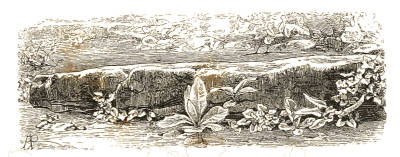

FINIS.
INDEX.
Acanthus, 120
Accident, a beautiful, 51
Achillea, 122
Achilleas, large white, 53
Aconite, the Winter, 139
Aconitum, 121
Adam’s Needle, 162
Ajuga, 122
Alkanet, 125
Allium, the White, 123
Allium, the Yellow, naturalised, 42
Alstrœmeria, 123
American Cowslip, 136
American Swamp Lily, 64
American White Wood Lily, 59
Ampelopsis, 130
Anchusa, 125
Anemone, 124
Anemone, Blue Apennine, 17
Anemone fulgens, 23
Anemones in the Riviera, 25
Anthericum, 125
Antirrhinum, 125
Apennine Anemone, 7
Aquilegia, 125
Arabis, 126
Arenaria, 126
Arenaria balearica on a wall, 88
Aristolochia Sipho, 129
Arum, 127
Arundo Donax, 155
Asclepias, 128
Asphodel, 127
Aster, 128
Astragalus, 129
Astrantia, 129
Atragene Alpina, 30
Aubrietia, 129
Bamboo, 130
Bambusa, 130
Baptisia, 130
Barren–wort, 138
Bear’s Breech, 120
Bedding System, the, 2
Bee Balm, 150
Bell–flower, 130
Bindweed, 134
Bindweed, a South European, 135
Bindweed, large white, 39
Bitter Vetch, 151
Blood–root, 15
Bloodwort, 157
Blue Apennine Anemone, 17
Blue Rock Cress, 129
Bog Garden, 77
Bog Gardens, 67
Bohemian Comfrey, 11
Borage, 12
Borage family, 9
Borago, 130
Borago cretica, 13
Bramble, 155
Bramble, the Nootka, 40
Brookside Gardens, 67
Bugle, 122
Bulbs, hardy, for naturalisation, 172
Bulbs and Tubers in grass, 15
Calla palustris, 135
Callirhoe, 150
Calystegia, 134
Campanula, 130
Candytuft, Evergreen, 145
Cape Pond Weed, 75
Catch–fly, 157
Celastrus, 46
Centaurea, 131
Centranthus ruber, 131
Cephalaria, 157
Cephalaria procera, 33
Cerastium, 131
Cheddar Pink, 91
Cheddar Pink, Saxifrage, etc., on wall, 89
Cheiranthus, 131
Christmas Rose, 143
Clematis, 133
Clematis erecta, 133
Clematis flammula, 21
Clematis, large white, on Yew tree, 44
Clematis, the mountain, 22
Clematis, the White–flowered European, 133
Climbers, 166
Climbing plants crucified, 45
Climbing plants for Wild Garden, 8
Climbing Rose isolated on grass, 87
Colchicum, 132
Colony of Myrrhis odorata, 51
Colony of Narcissus in shrubbery, 57
Colony of Summer Snowflake, 119
Columbine, 125
Columbine, the Siberian, 126
Columbines in Grass, v
Comfrey, 157
Comfreys, 11
Common Lupine, 146
Copse, Lily of the Valley in a, 63
Copses, 36
Coral–wort, 135
Cornus canadensis, 133
Coronilla varia, 135
Cotton Thistle, 151
Cow Parsnip, the Giant, 35
Cow Parsnips, 143
Crambe, 134
Crane’s Bill, wild, 94
Creeping Forget–me–not, 151
Cretan Borage, 13
Crocus, 132
Crocuses, 17
Crocuses in turf, 20
Culture in Woods, 64
Cyclamen, 133
Cyclamen, Ivy–leaved, 5
Cyclamens in the Wild Garden, 134
Cyperus longus, 73
Cypripedium spectabile, 133
Daffodil, 151
Day Lily, 143
Day Lily by margin of water, 76
Delphinium, 136
Dentaria, 135
Dianthus, 137
Dielytra, 136
Digitalis, 137
Digging shrubbery borders, 51
Ditches, 36
Dodecatheon, 136
Dog’s–tooth Violet, 139
Doronicum, 136
Drapery for trees and bushes, 43
Dug and mutilated shrubbery in St. James’s Park, 111
Dwarf Cornel, 133
Echinops, 138
Ellacombe, Rev. H. N., on the Rose, 81
Enothera, 151
Epigæa repens, 138
Epimedium, 138
Eranthis hyemalis, 139
Erica, 138
Eryngium, 138
Erythronium, 139
Eupatorium, 137
Evening Primrose, 151
Evening Primrose at night, 4
Evergreen Candytuft, 145
Everlasting Pea, 148
Exotic and British Wild Flowers in the Wild Garden, 17
Ferns, 141
Ferula, 140
Flame Flower, 159
Fleur de Lis, 145
Flowers, Spring and early Summer, 166
Forget–me–not, 149
Forget–me–not, Creeping, 151
Foxglove, 137
Fritillaria, 140
Fumaria, 136
Fumitory, 136
Fumitory, the Yellow, on wall, 91
Funkia, 139
Funkia Sieboldi, group of, 140
Galanthus, 143
Galega, 142
Gardens of the future, 58
Gentian, 142
Geranium, 141
Geranium, a hardy, 141
Geraniums in Grass, v
Giant Comfrey, 13
Giant Cow Parsnip, 35
Giant Fennel, 140
Giant Sea–kale, 134
Globe Flower, 159
Globe Flower order, 21
Globe Flowers, 25
Globe Flowers, group of, 21
Globe Thistle, 138
Goat’s Rue, 142
Golden Rod, 156
Grape Hyacinth, 148
Grape Hyacinths, 17
Grass, double Crimson Pæonies in, 30
Grass, Star of Bethlehem in, 15
Grasses for naturalisation, 171
Great Siberian vegetation, type of, 35
Green Hellebore in the Wild Garden, 26
Gromwells, 11
Gypsophila, 142
Hardy flowers by brook–side, 69
Heath, 138
Hedgerows, 36
Helianthemum, 144
Helianthus, 144
Hellebore in Wild Garden, 26
Helleborus, 143
Hemerocallis, 143
Hemp Agrimony, 137
Hepatica angulosa, 24
Hepatica, common, 25
Heracleum, 143
Herb Paris and Solomon’s Seal in copse by streamlet, 67
Hesperis, 145
Honesty, 146
Honeysuckle, 147
Hop, the, 45
Houseleek, 158
Hovey, Mr., on tree drapery, 47
Hypericum, 145
Iberis, 145
Illustrations, list of, xi
Indian Cress, showy, 160
Iris, 145
Japan Anemone in the Wild Garden, 23
Japan Knotweed, 152
Japan Sedum in Wild Garden, 92
Kitaibelia, 150
Knap–weed, 131
Knautia, 157
Landwort, 126
Large Achilleas, 53
Large Bindweed, 39
Large–flowered Clematis, 101
Large–leafed Saxifrage, 97
Larkspurs, perennial, 27
Lathyrus, 147
Lavender, Sea, 156
Leopard’s Bane, 136
Leucojum, 147
Liane in the north, 49
Lilies through carpet of White Arabis, 55
Lilium, 146
Lily, 146
Lily, American Swamp, 64
Lily, American White Wood, 59
Lily of the Valley in a copse, 63
Lily, Wood, 159
Lily, Water, 151
Lily, White Wood, 37
Lithospermum prostratum, 147
Longleat, Wild Garden at, 61
Lonicera, 147
Lords and Ladies, 127
Lunaria, 146
Lungwort, 154
Lungworts, 11
Lupine, common, 146
Lychnis, 147
Mallow, 150
Malope, 150
Malva, 150
Marsh Calla, 135
Marsh Mallow, 123
Marsh Marigold and Iris in early spring, 78
Masterwort, 129
Matthiola, 149
May–flower, 138
Meadow Rue, 158
Meadow Rue in Wild Garden, 1
Meadow Rues, 31
Meadow Saffron, foliage of, 132
Menispermum, 47
Menziesia, 138
Mertensia virginica, 12
Milk Vetch, 129
Mimulus, 148
Mocassin Flower, 133
Molopospermum, 149
Monarda, 150
Monkey–flower, 148
Monkshood, 121
Moonseed, 47
Mountain Clematis, 22
Mouse–ear, 131
Mowing Grass, 17
Mullein, a tall, 161
Muscari, 148
Myosotis, 149
Myrrh, 60
Myrrhis odorata, a colony of, 51
Narcissus, 151
Narcissus, colony of, in shrubbery, 57
New England, woods of, 58
Night effect of Evening Primrose, 4
Nootka Bramble, 40
Nuphar, 151
Nursery for London Parks, 118
Nymphæa, 151
Œnothera Lamarkiana, 4
Omphalodes, 151
Omphalodes verna, 10
Onopordon, 151
Orchard Wild Garden, 65
Ornithogalum, 151
Orobus, 151
Oxalis, 152
Ox–eye Daisy, the tall, 154
Pæonies in grass, 30
Pæony, 153
Papaver, in var., 153
Partridge Berry, 80
Pea, 147
Pea, Everlasting, 148
Perennial Larkspurs, 27
Perennial Larkspurs naturalised in shrubbbery, 28
Periwinkle, 161
Phlomis, 153
Physostegia, 154
Phytolacca decandra, 154
Pink, 137
Plants, Annual and Biennial, for naturalisation, 171
Plants, Aquatic, 171
Plants chiefly fitted for the Wild Garden, 32
Plants, climbing and twining, for copses, thickets, hedgerows, and trees, 172
Plants for bare banks, 164
Plants for calcareous or chalky soil, 169
Plants, hardy, with fine foliage, 165
Plants for hedge–banks and like places, 165
Plants for moist rich soils, 169
Plants for naturalisation beneath specimen trees on lawns, 167
Plants for naturalisation in lawns and other grassy places, 172
Plants for peat–soil, 169
Plants for the Wild Garden, 120
Plants of vigorous habit for the Wild Garden, 164
Plants, selections of, for old walls, ruins, or rocky slopes, 170
Plants, selections of hardy, 163
Plants suited for dry and gravelly soil, 170
Polygonum cuspidatum, 152
Poppy, 153
Primrose, Evening, 151
Pulmonaria, 154
Pyrethrum serotinum, 154
Rabbits and Woods, 173
Reasons for the system, 4
Red Valerian, 131
Reed, the Great, 155
Results, 92
Rheum, 155
Rhubarb, 155
Riviera, Anemones in the, 25
Rocket, 145
Rosa, 155
Rose, 155
Roses for the Wild Garden, hedgerows, fences, and groups, 81
Roses in the Riviera, 85
Rosy Coronilla, 135
Rubus, 155
Rudbeckia, 144
Rush, flowering, 73
Sanguinaria canadensis, 157
Saxifraga, 158
Saxifrage, 158
Scabious, the Giant, 33
Scabious, 157
Scilla, 157
Scillas, 17
Sea Holly, 138
Sea–kale, the Giant, 134
Sea Lavender, 156
Sedum, 157
Sempervivum, 158
Shady Lanes, 36
Shrubbery borders, digging of, 51
Shrubbery, margin of, 118
Shrubbery, Perennial Larkspurs naturalised in, 28
Sida, 150
Silene, 157
Silkweed, 128
Silphium, 144
Snakes–head, 140
Snapdragon, 125
Snowdrop, 17
Snowdrop–Anemone, colony of, in shrubbery not dug, 115
Snowdrops, 143
Snowdrops, Wild, by streamlet, 142
Solidago, 156
Solomon’s Seal, 18
Sowbread, 133
Speedwell, 162
Spiderwort, 159
Spiræa, 156
Spring Flowers in the Wild Garden, 7
Squill, 157
Star of Bethlehem, 151
Star of Bethlehem in grass, 15
Starwort, 128
Statice, 156
St. Bruno’s Lily, 125
St. John’s Wort, 145
Stock, 149
Stonecrop, 157
Sunflower, Perennial, 144
Sun Rose on limestone rocks, 144
Sun Roses, 104
Symphytum, 157
Telekia cordifolia, 159
Tew Park, 98
Thalictrum, 158
Thickets, 36
Tiger Lilies in Wild Garden at Great Tew, 98
Tradescantia virginica, 159
Trailers, 166
Trees and Bushes, drapery for, 43
Tree drapery, Mr. Hovey on, 47
Trillium, 159
Tritoma, 159
Tritoma, group of, 160
Tropæolum speciosum, 160
Tulip, 159
Tunica, 142
Turf, Crocuses in, 20
Turk’s Cap Lily, 19
Valley in Somersetshire, 70
Verbascum, 161
Veronica, 162
Vetch, Bitter, 151
Vinca, 161
Vines, Wild, 48
Viola, 162
Violet, 162
Virginian Creepers, 130
Virginian Poke, 154
Wall Cress, 126
Wallflower, 131
Water Dock, Great, 72
Water Lily, 151
Water Lily, Yellow, 71
Water Plants, 70
Waterside Gardens, 67
White Arabis, Lilies coming up through carpet of, 55
White Clematis on Yew tree, 44
White Climbing Rose over old Catalpa tree, 84
White Lily in Wild Garden, 146
Wild Garden in the orchard, 65
Wild Garden, Japan Anemone in the, 23
Wild Garden, plants chiefly fitted for, 32
Wild Garden, plants for, 120
Wild Garden in America, 106
Wild gardening on walls or ruins, 88
Wild Garden, where to obtain plants, 120
Wild Orchard, 65
Wild Rose on a Pollard Ash, 83
Wild Vines, 48
Willow Herb, 7
Wilson, Mr. G. F., and wood–culture, 64
Windflower, 124
Winter Aconite, 15
Winter Heliotrope, 7
Wistaria, 45
Wood and herbaceous Meadow–sweets, 105
Wood–culture, 64
Wood–culture at Bodorgan, 65
Wood Lily, 159
Wood Plants, American, 150
Woodruff and Ivy, 108
Woods and woodland drives, 51
Woods of New England, 58
Wood Sorrel, 152
Wye Valley, 90
Yarrow, 122
Yellow Allium naturalised, 42
Yucca, 162
Printed by R. & R. Clark, Edinburgh.
